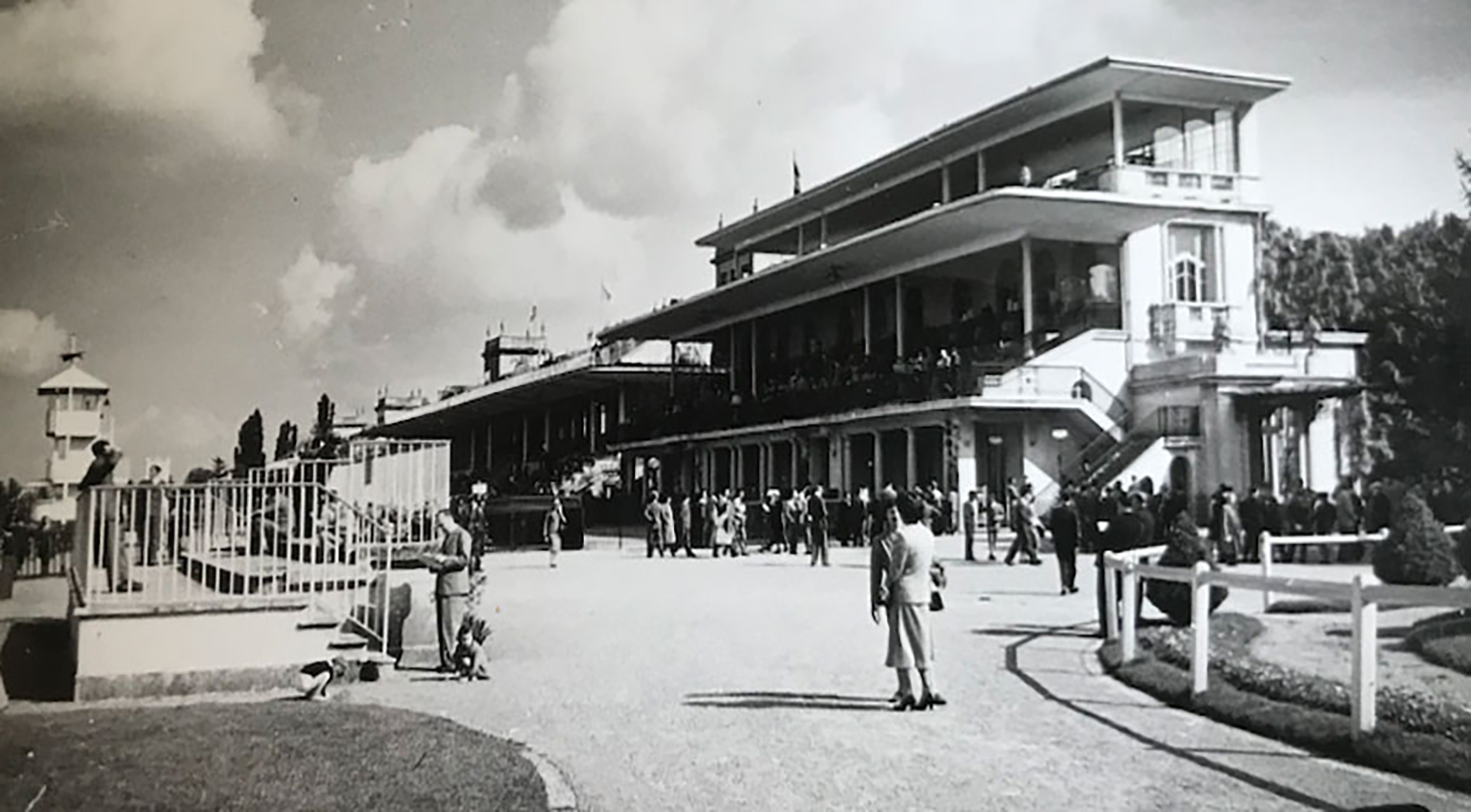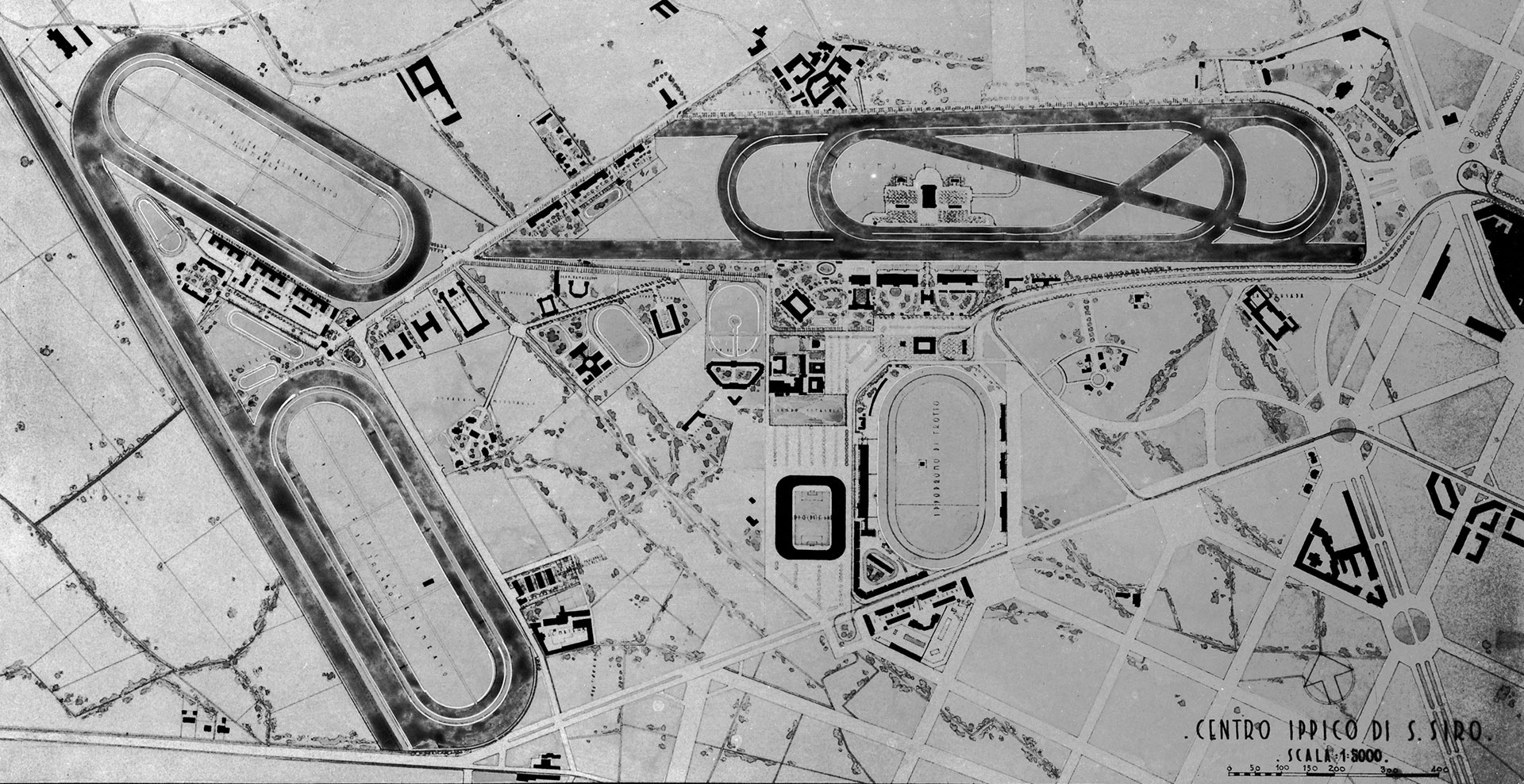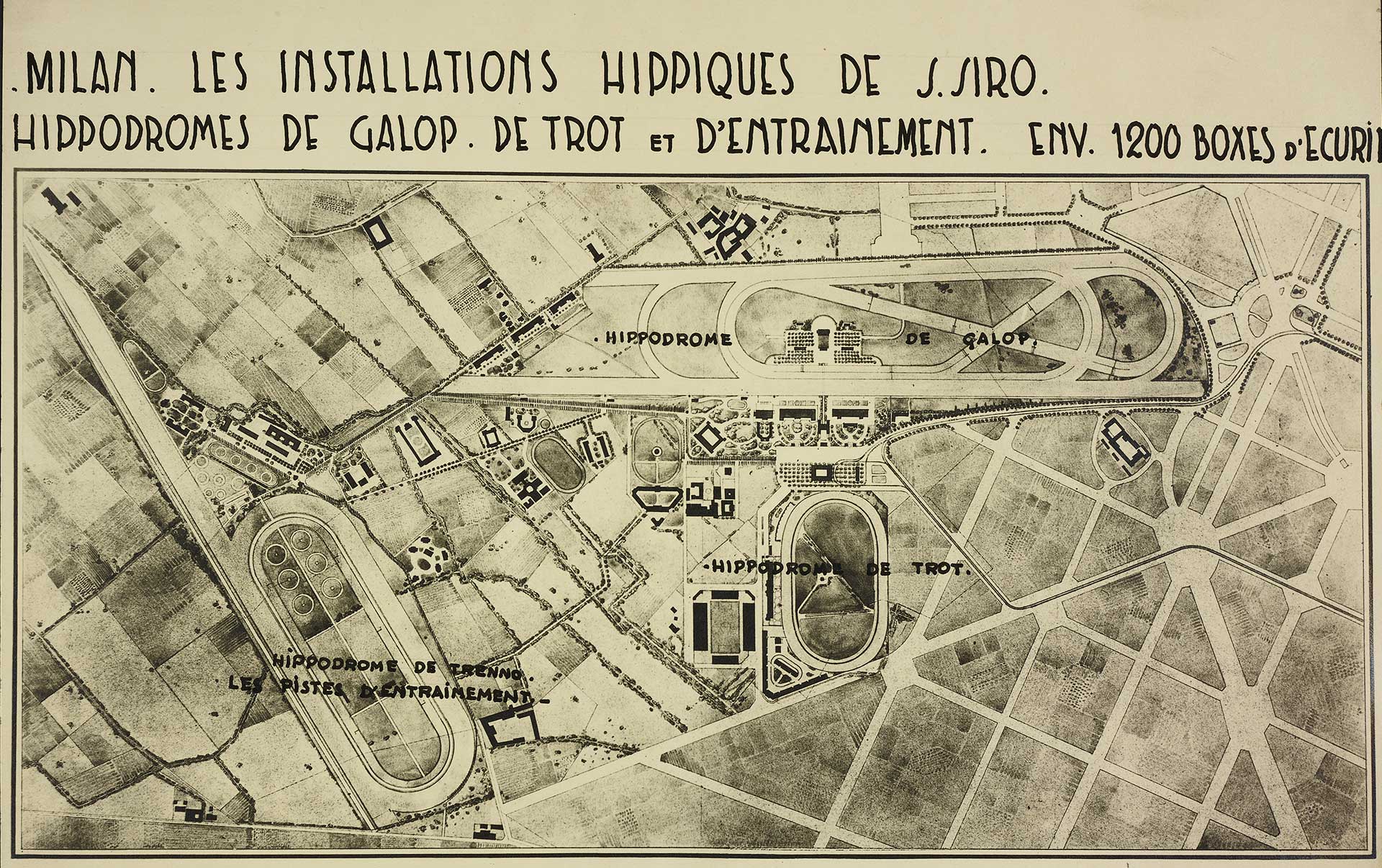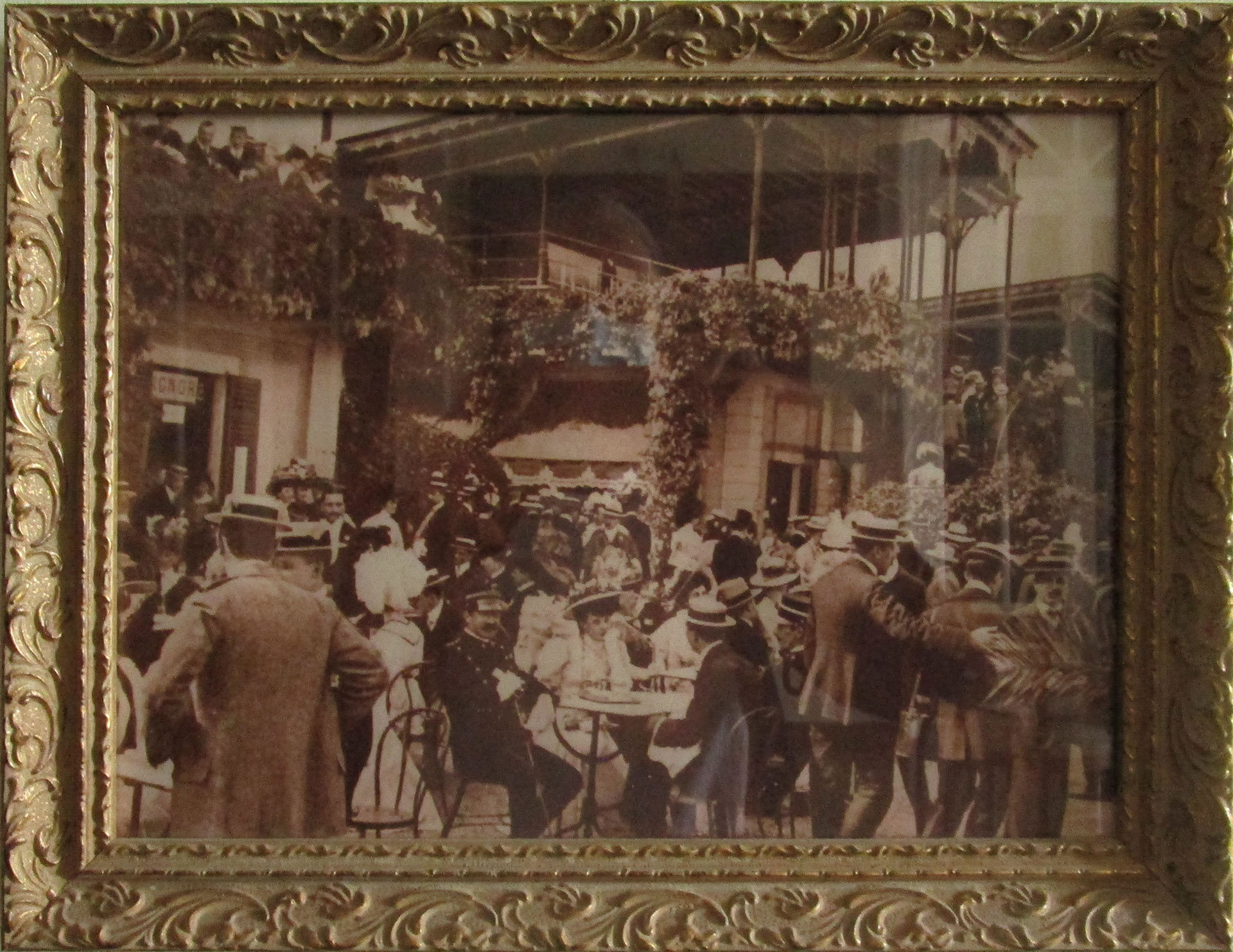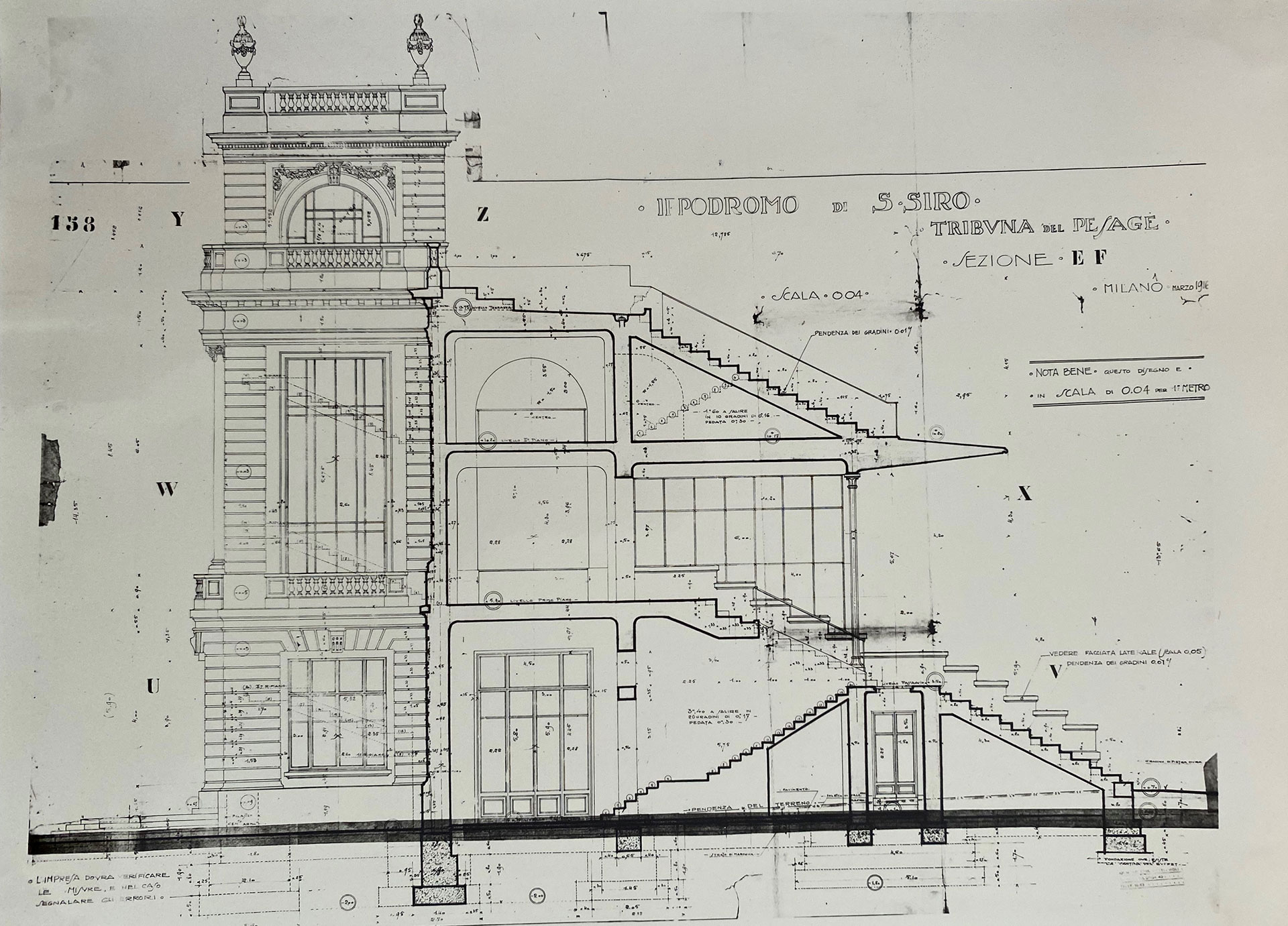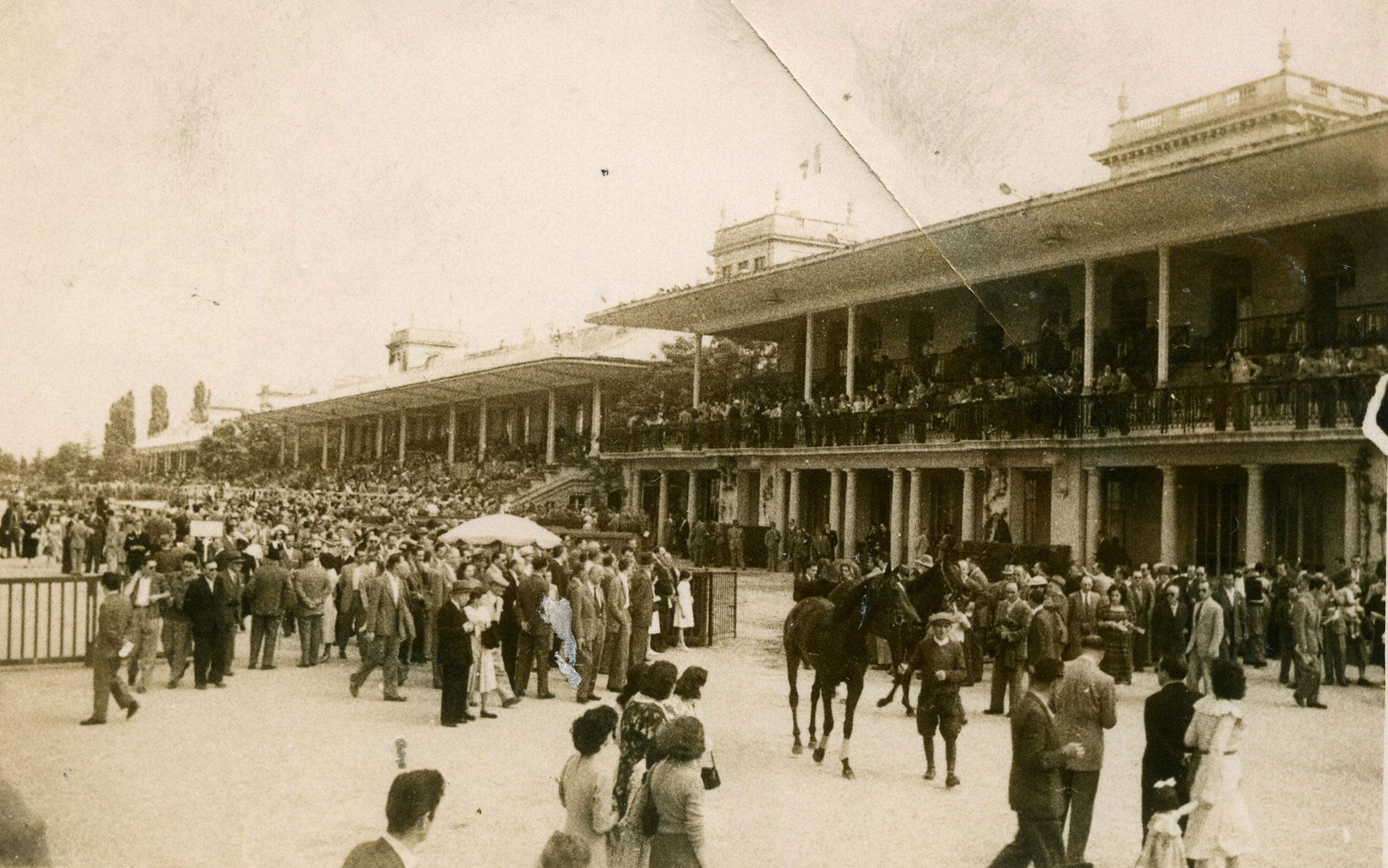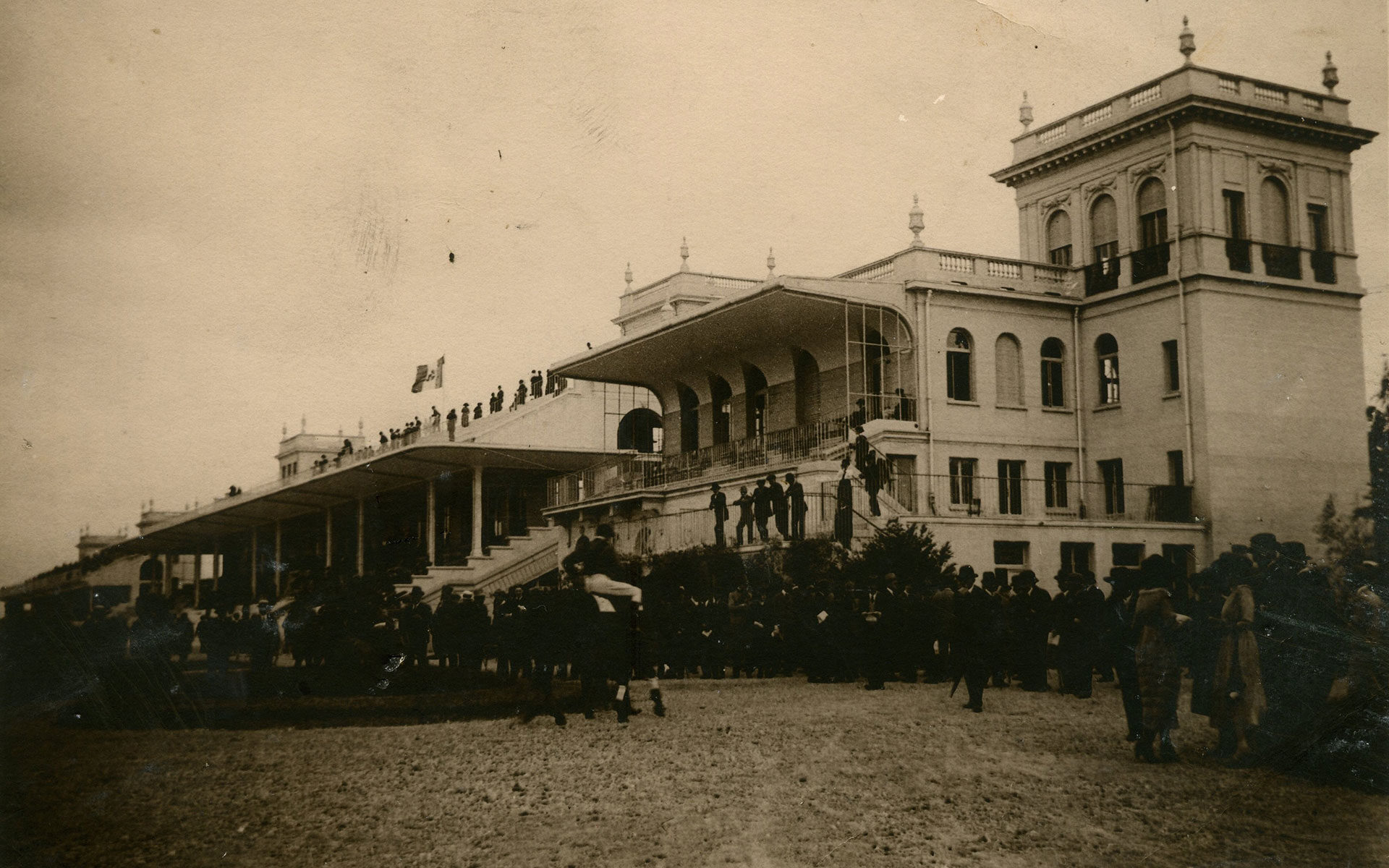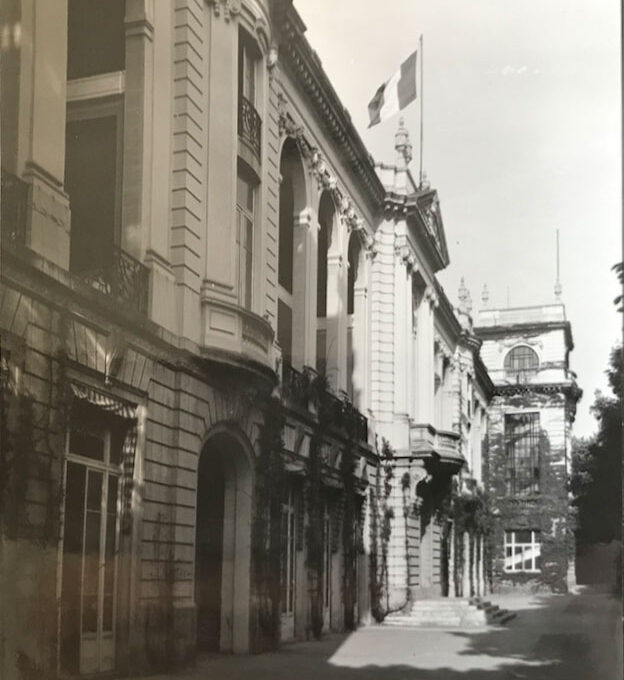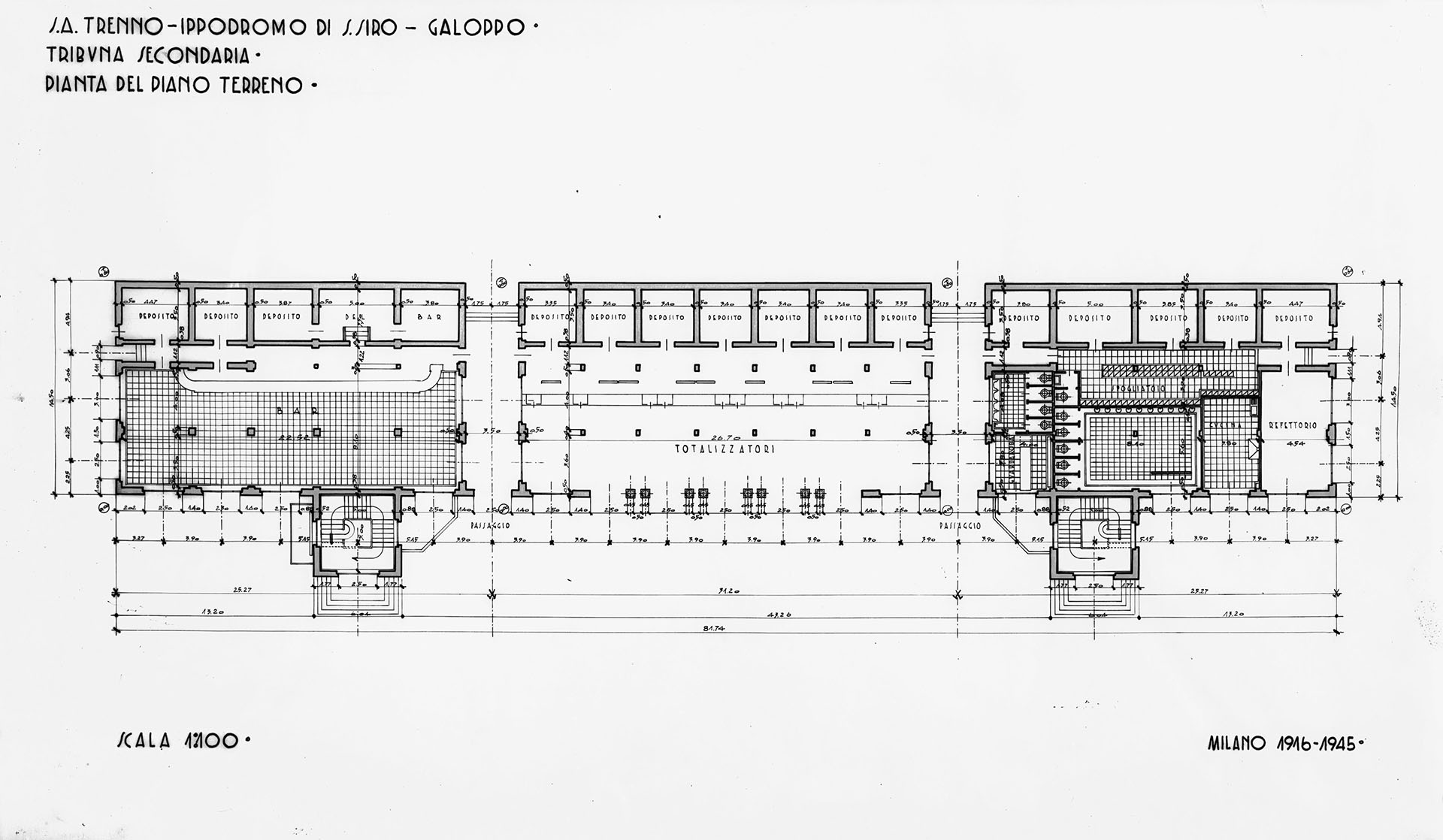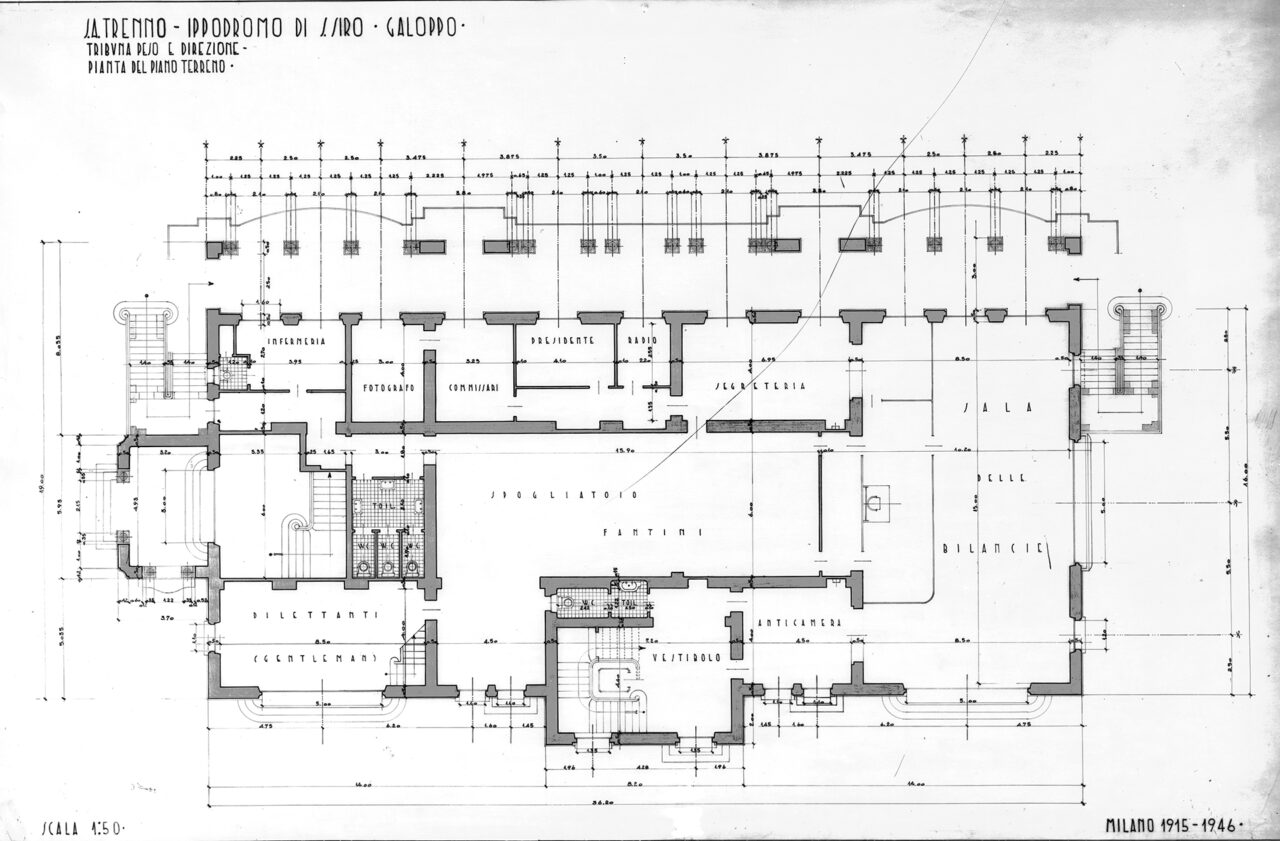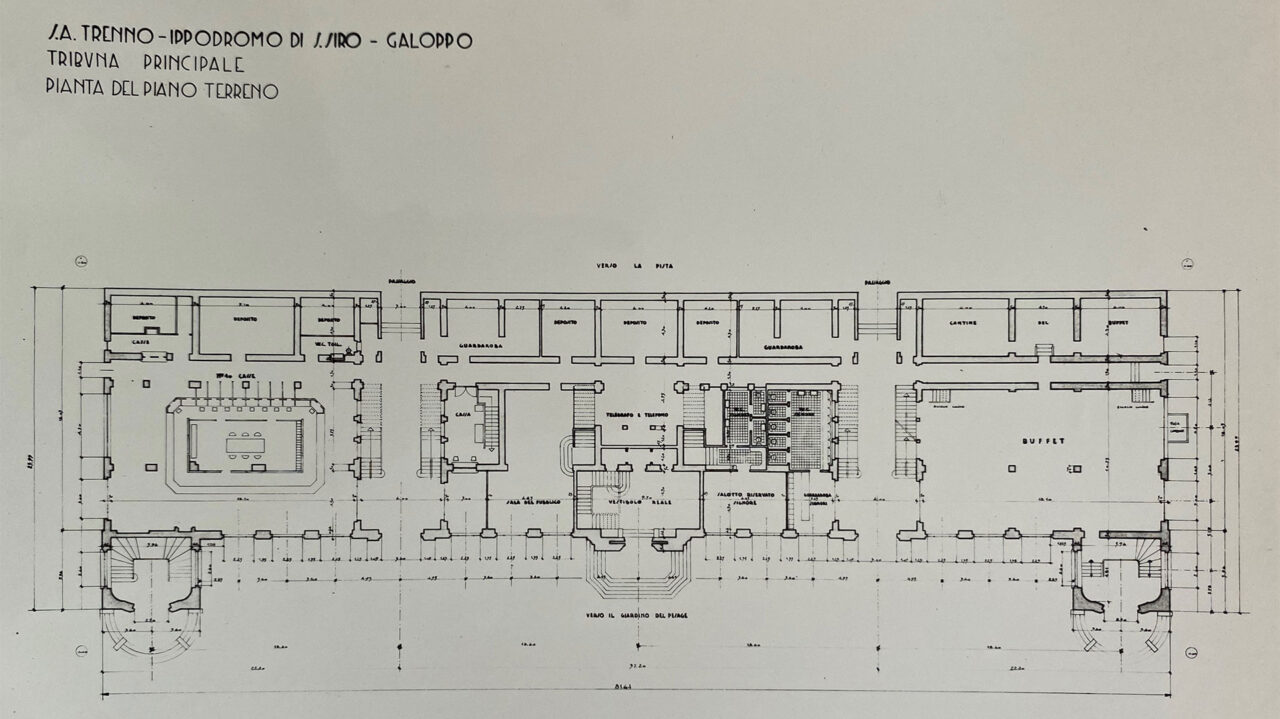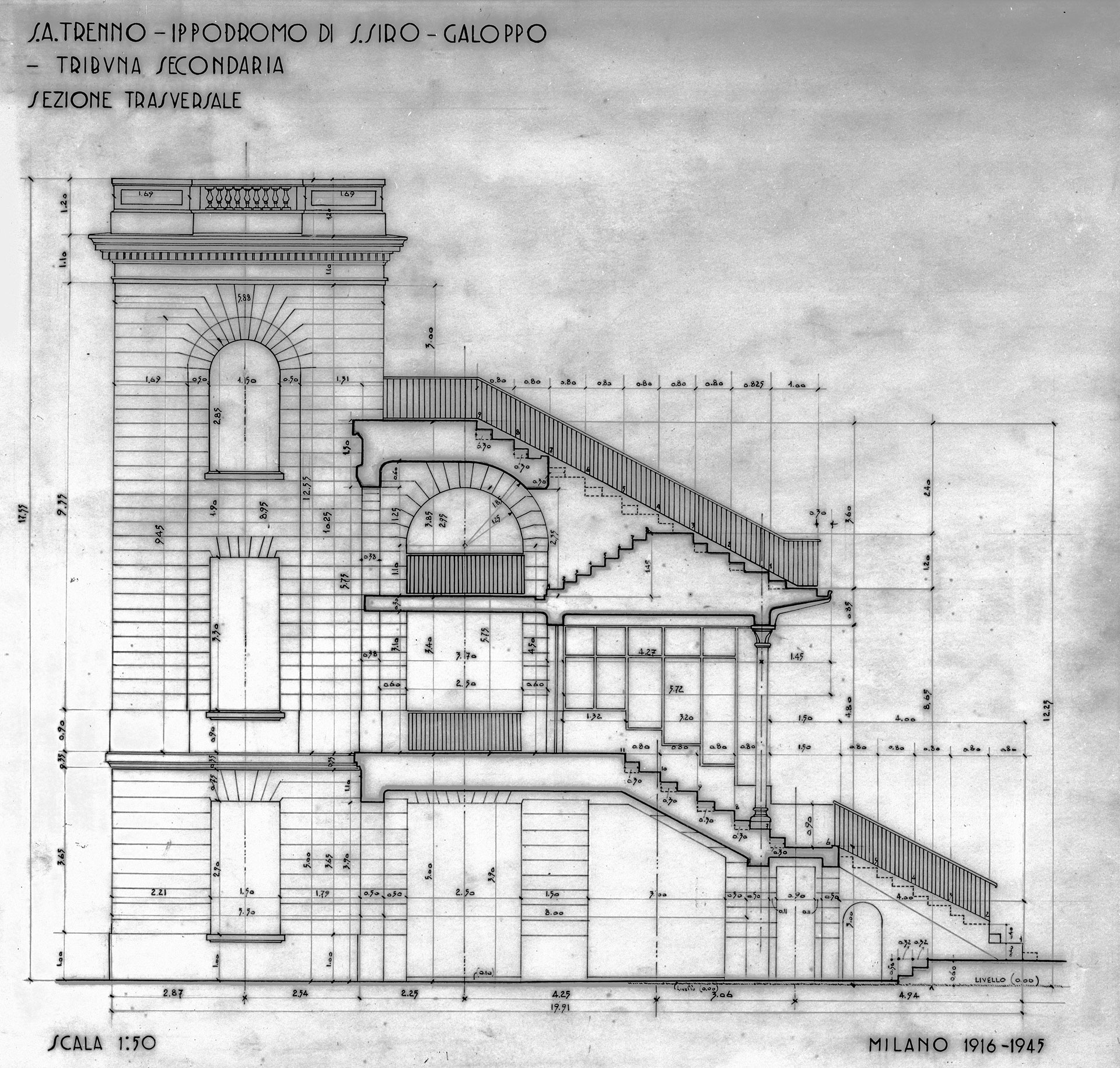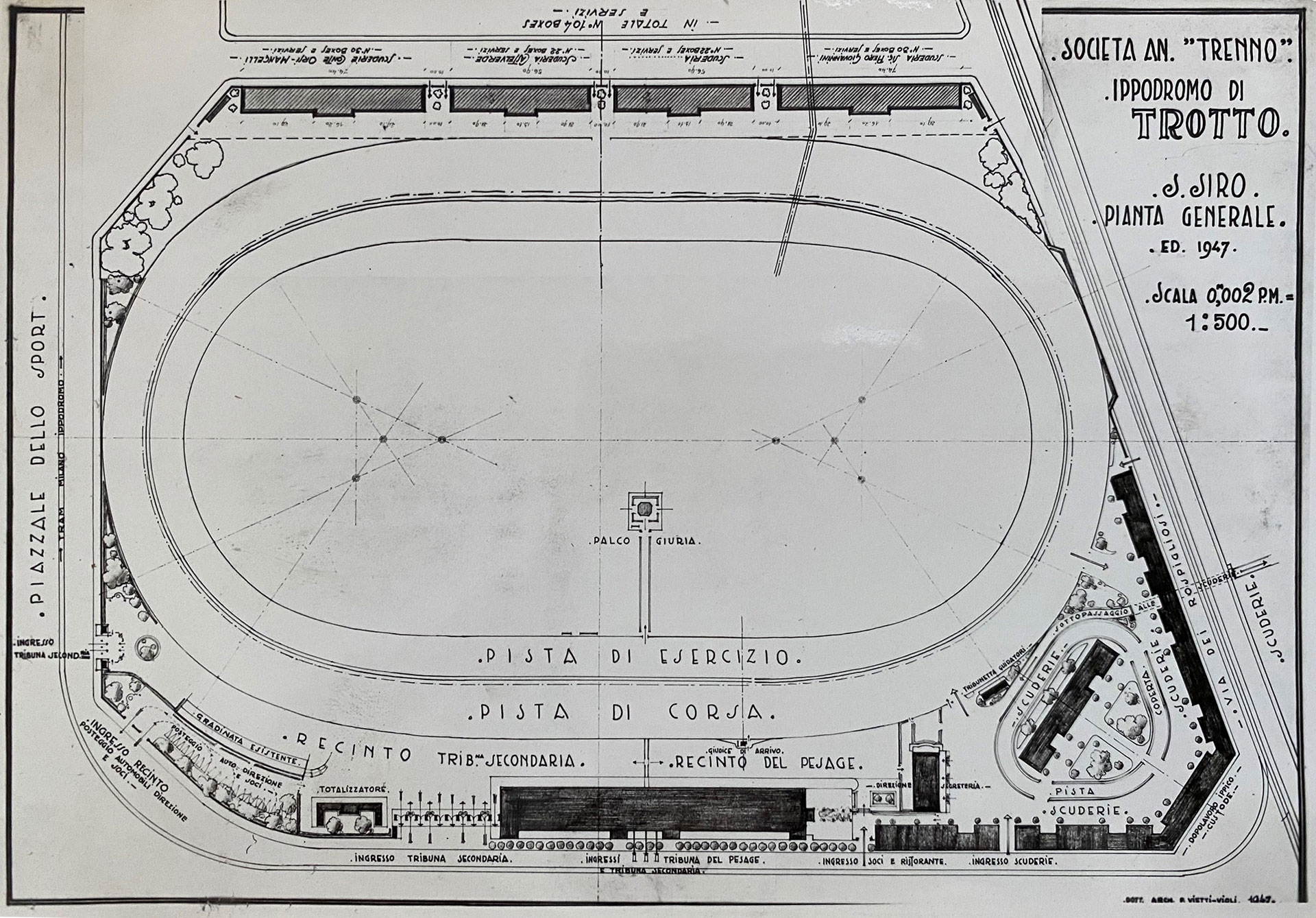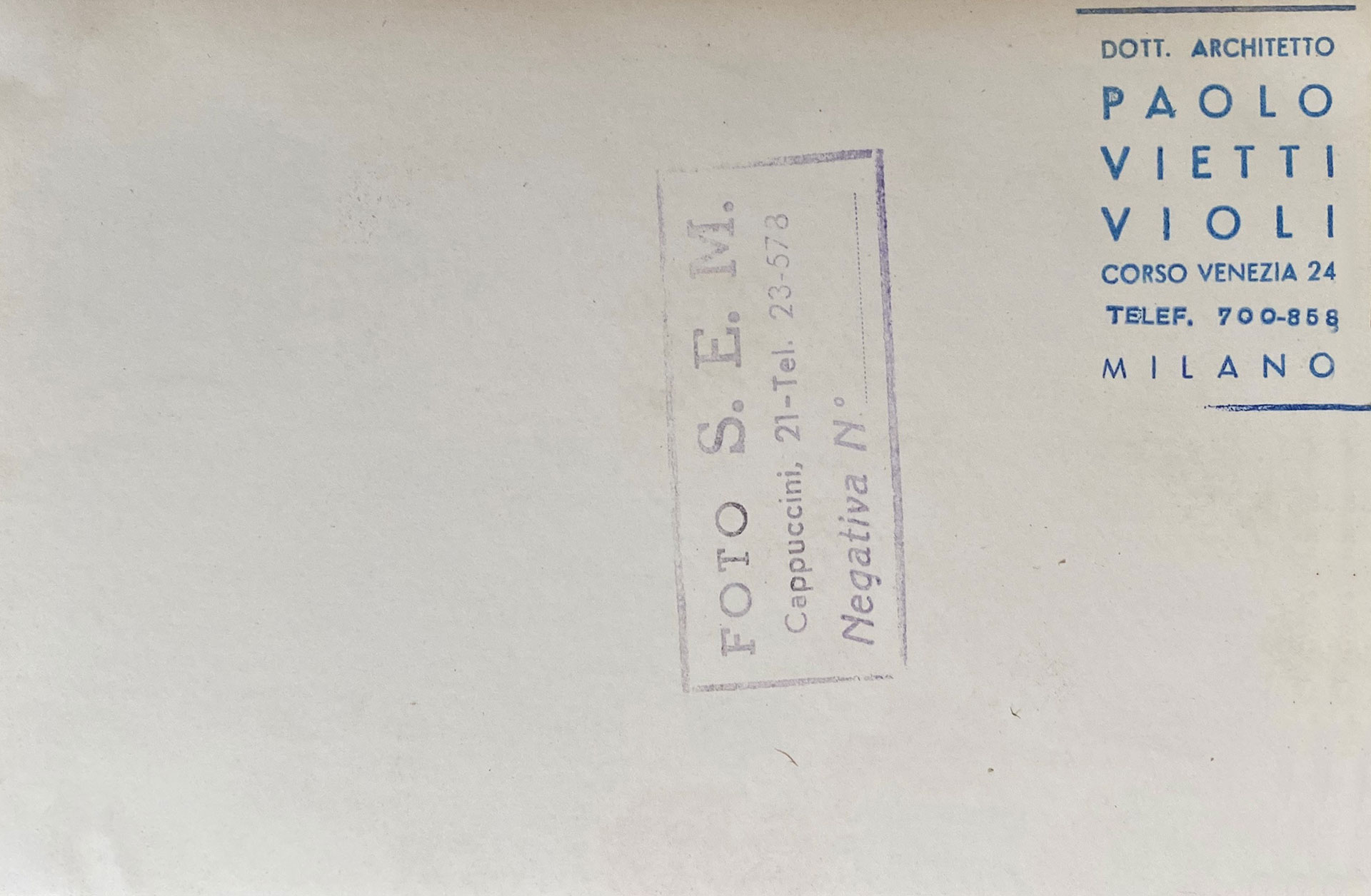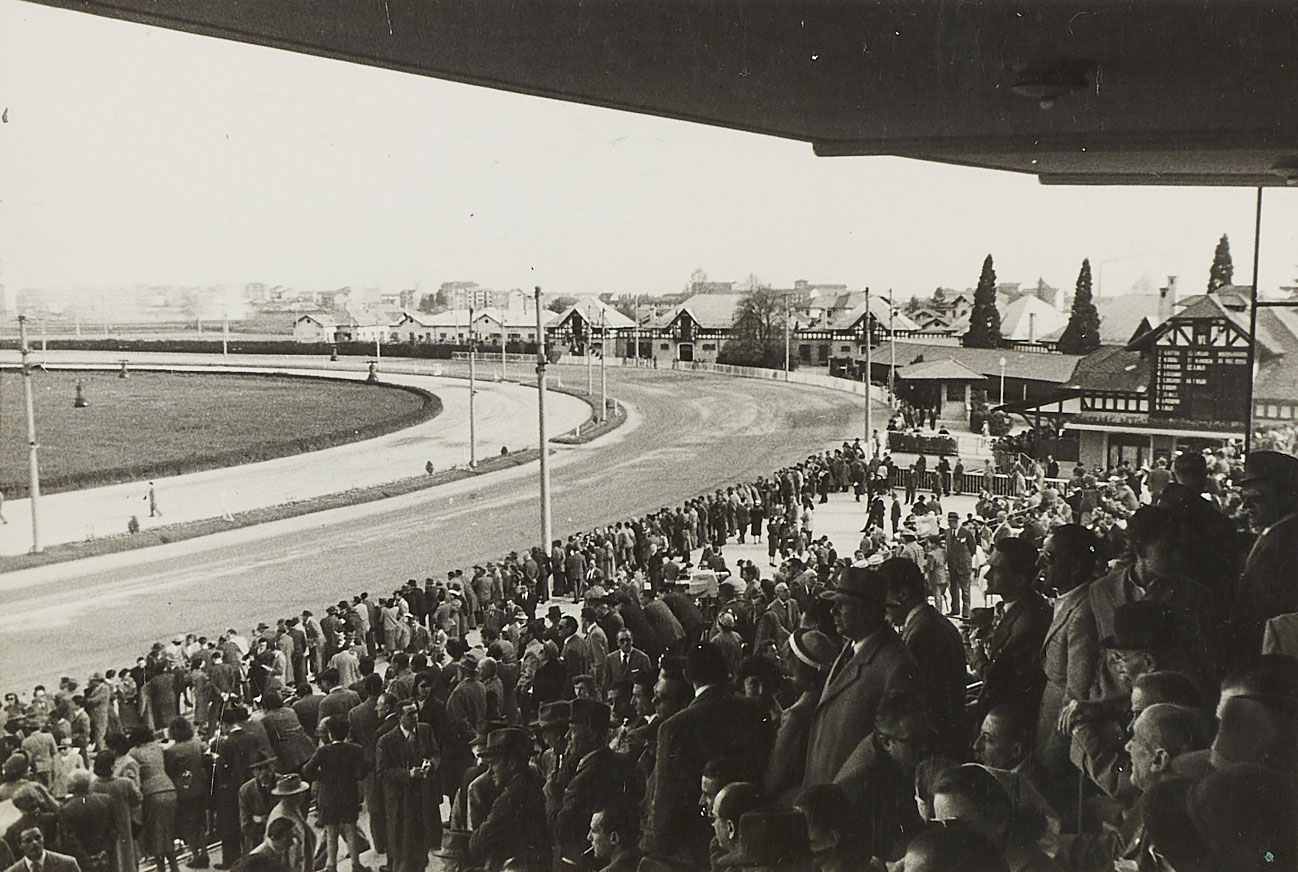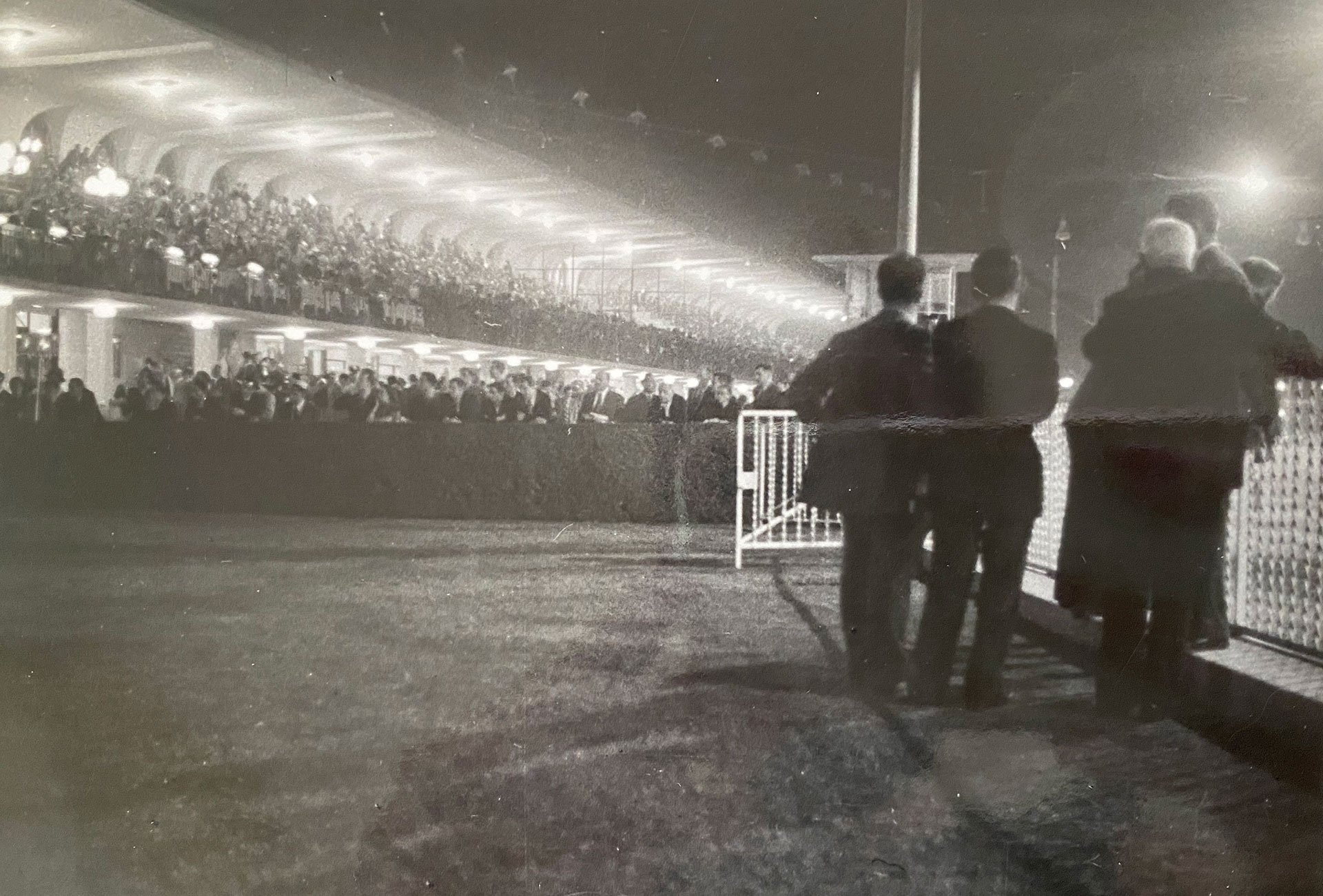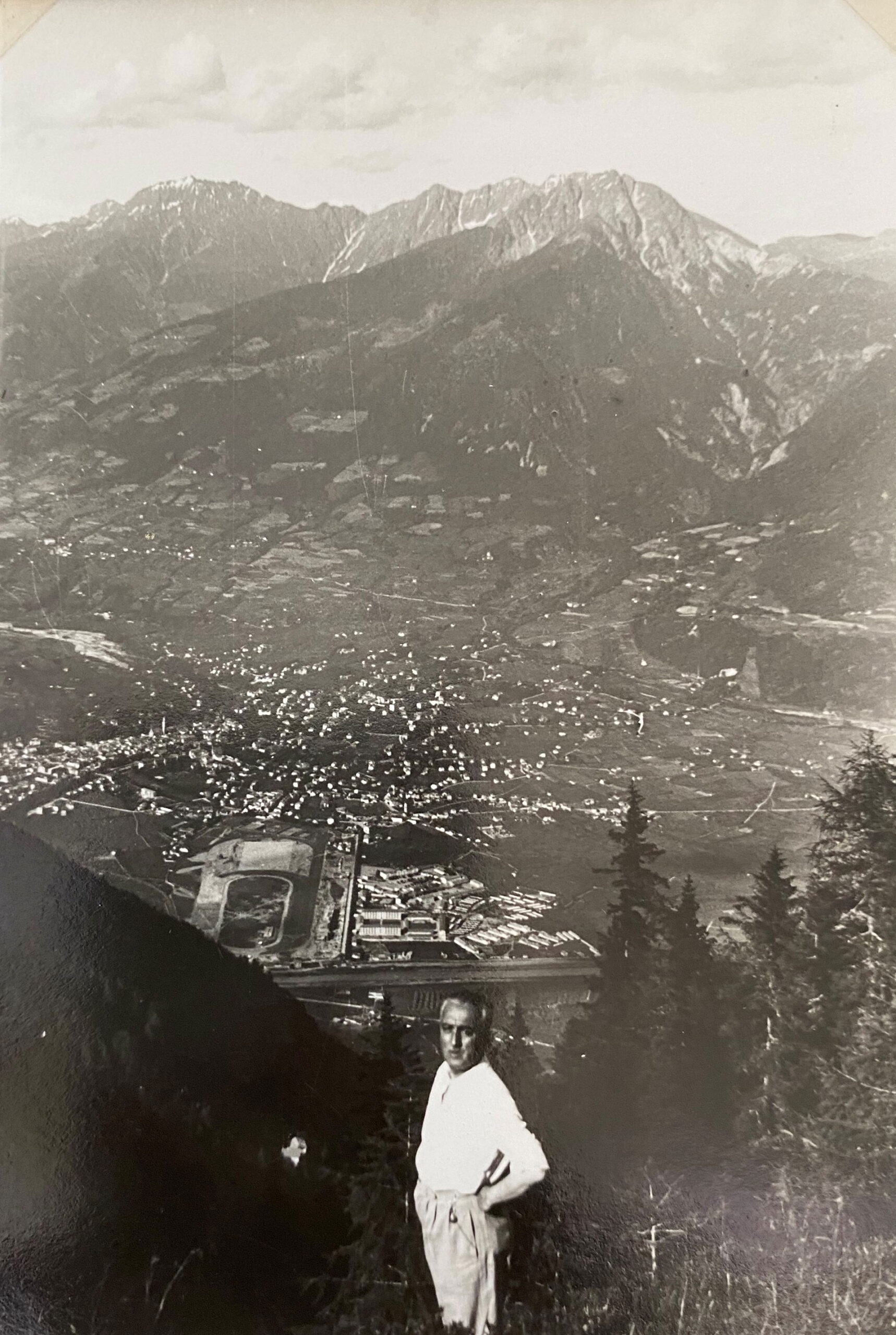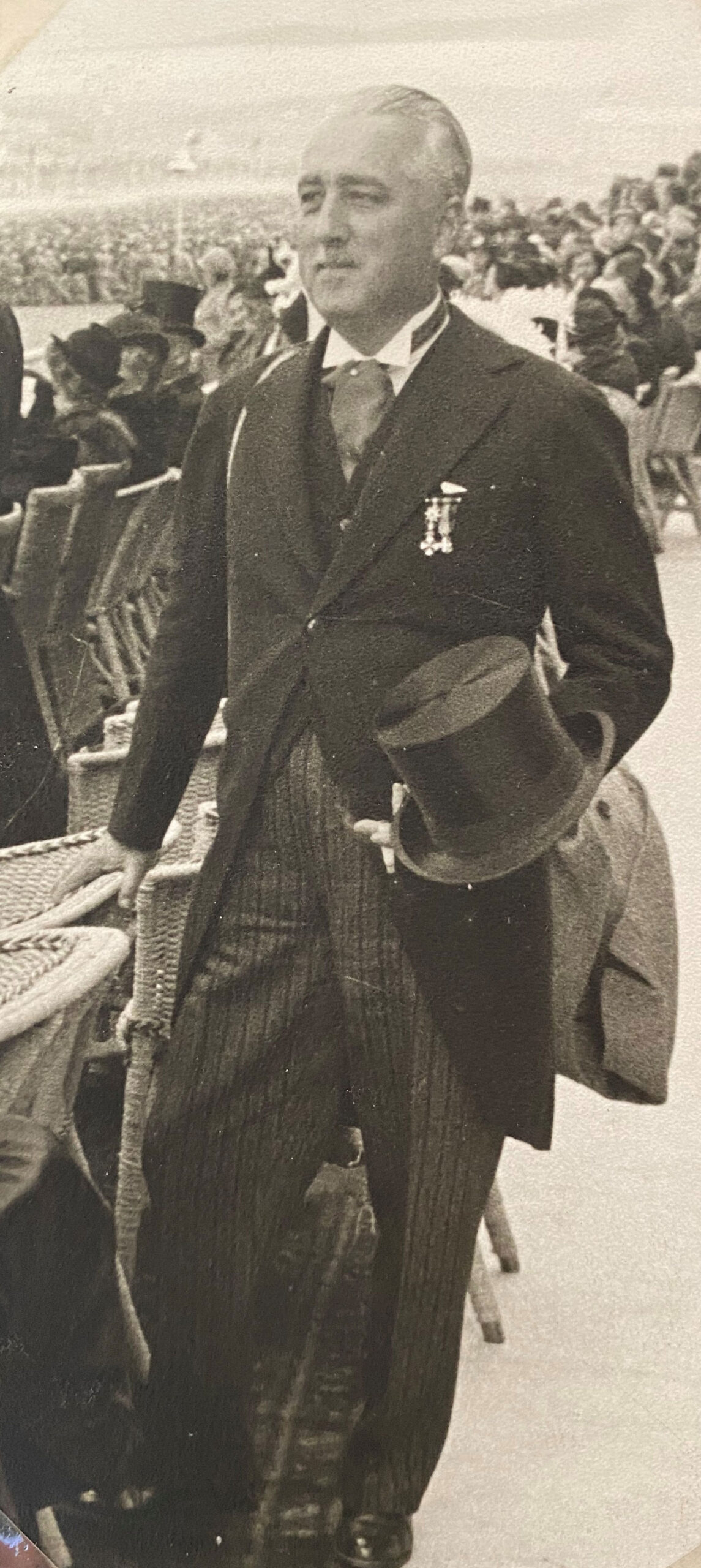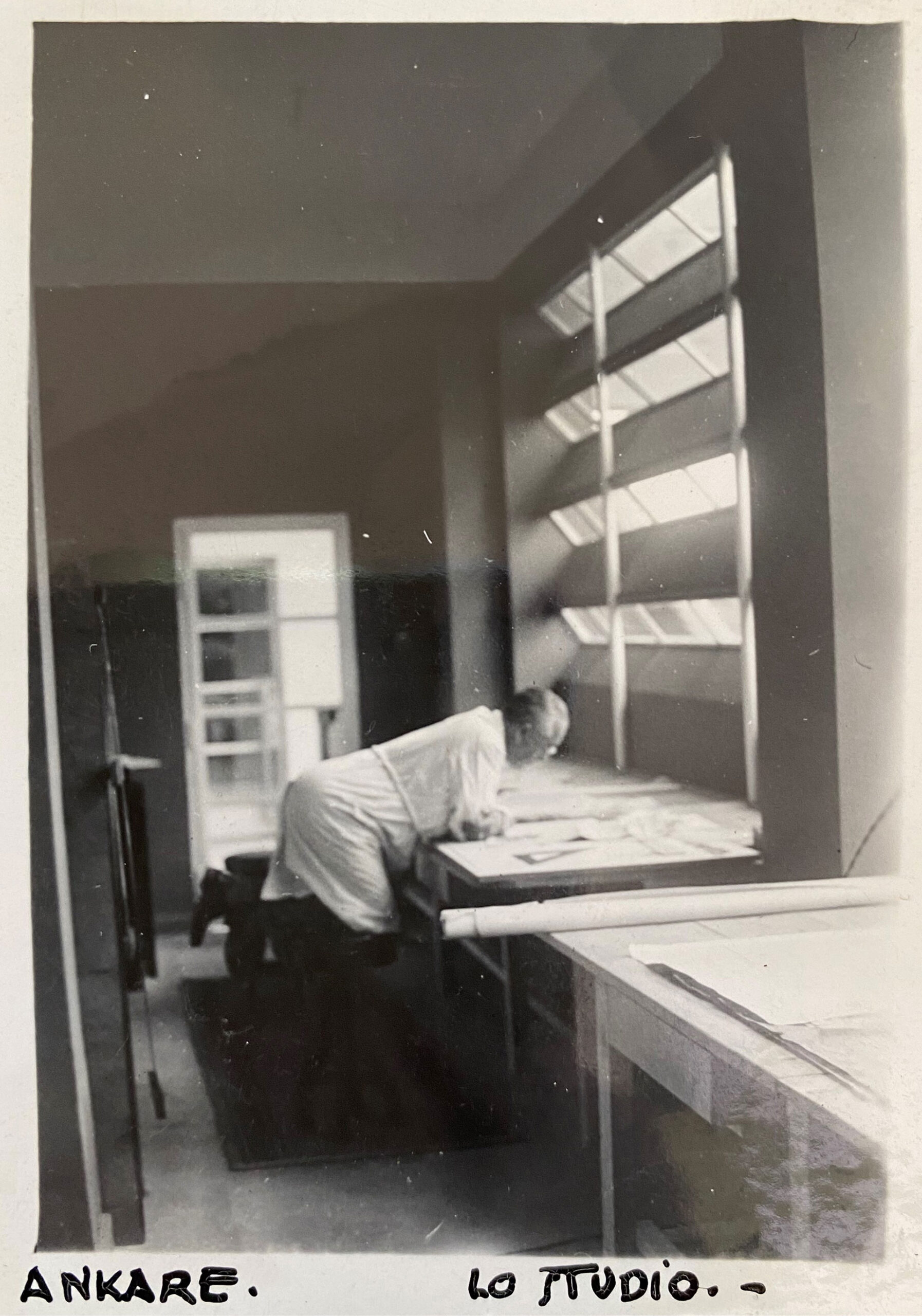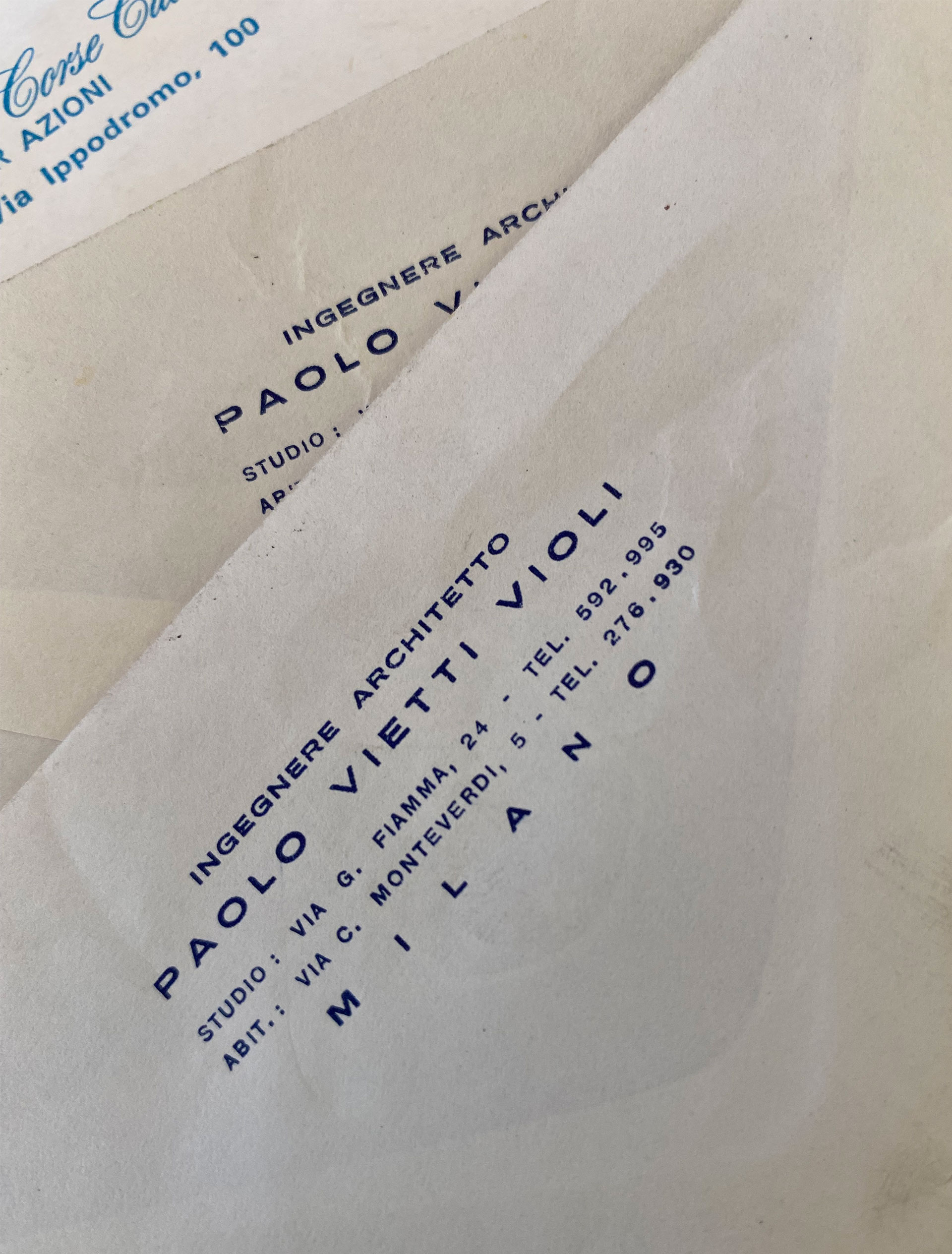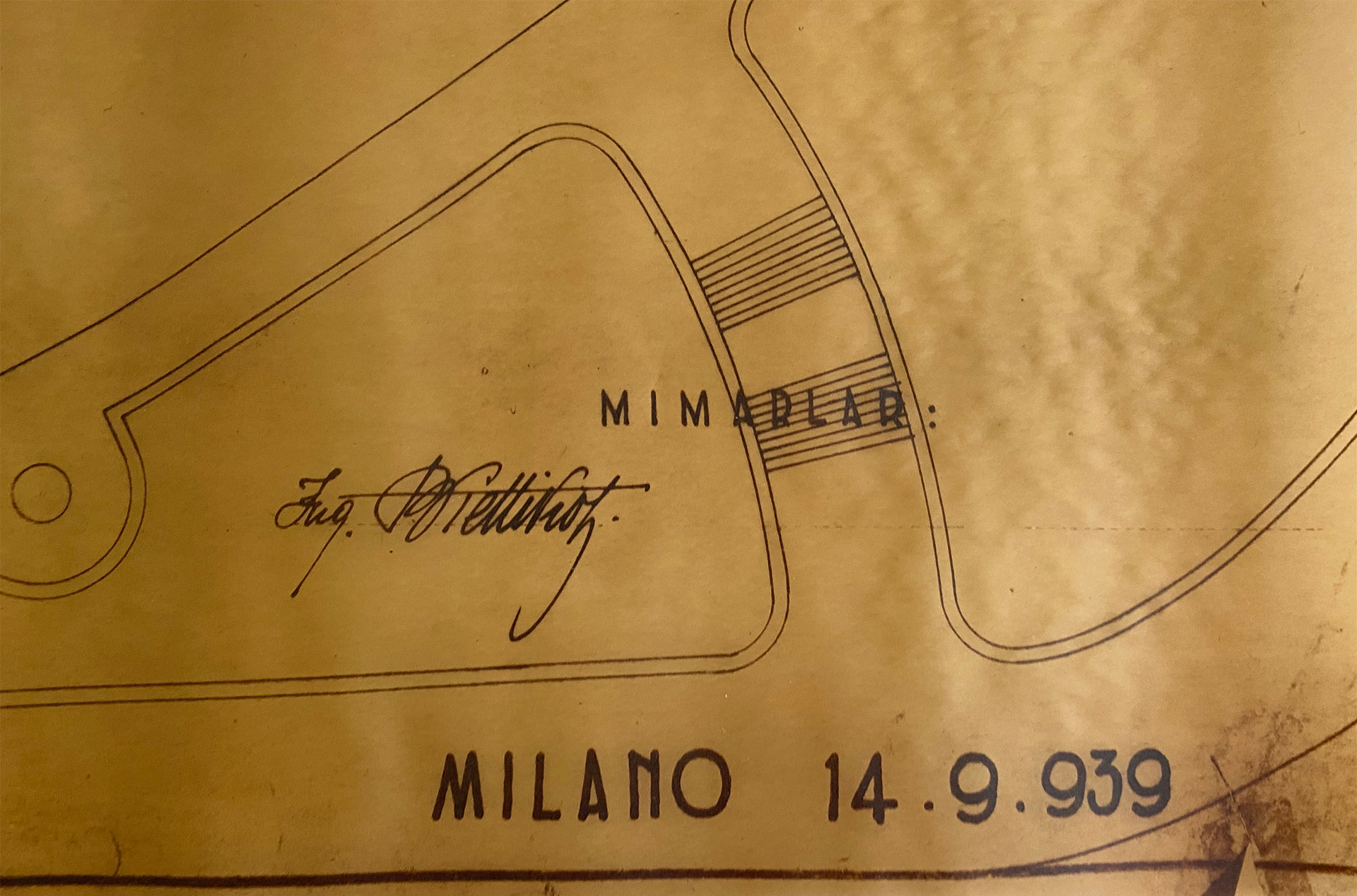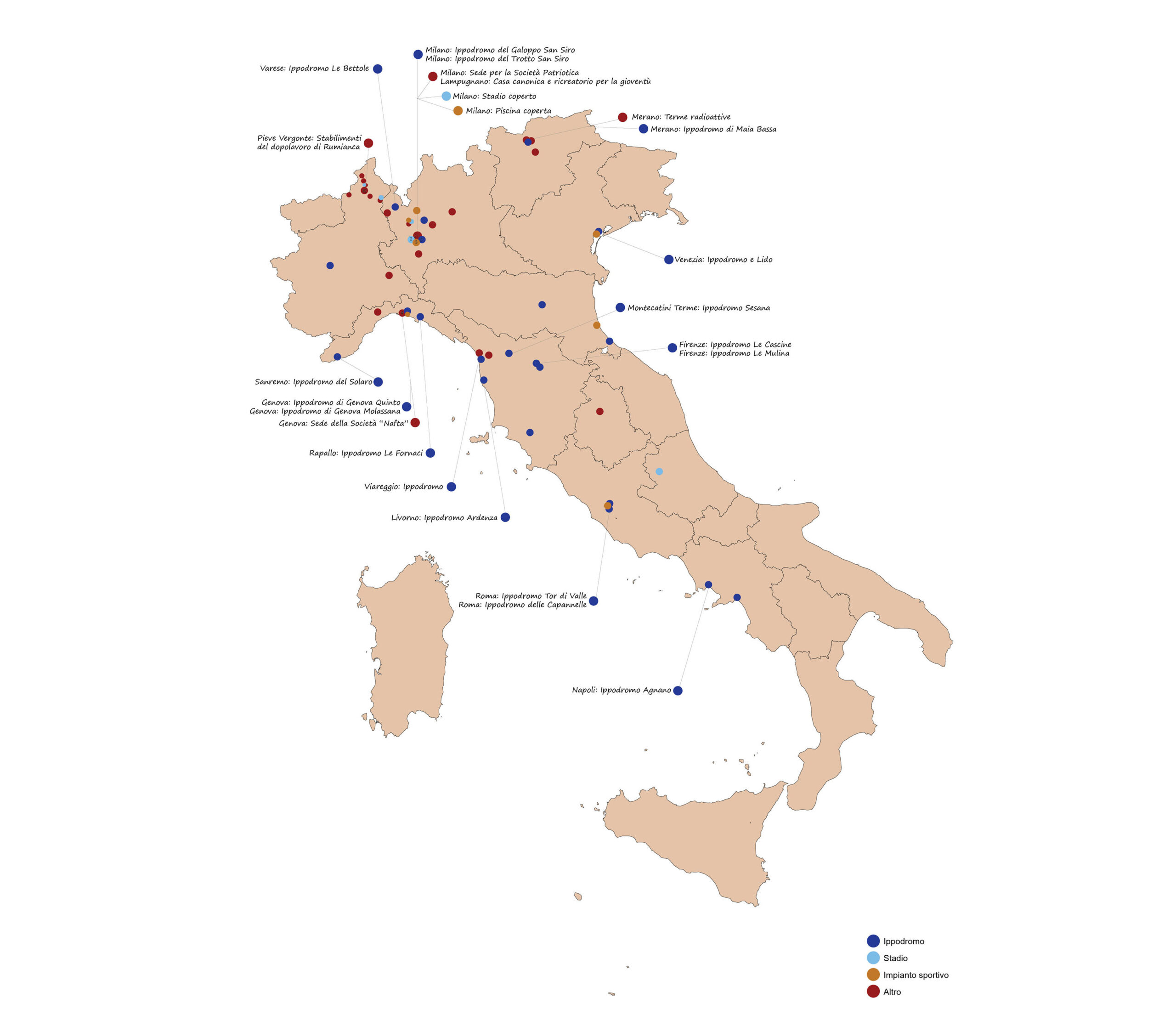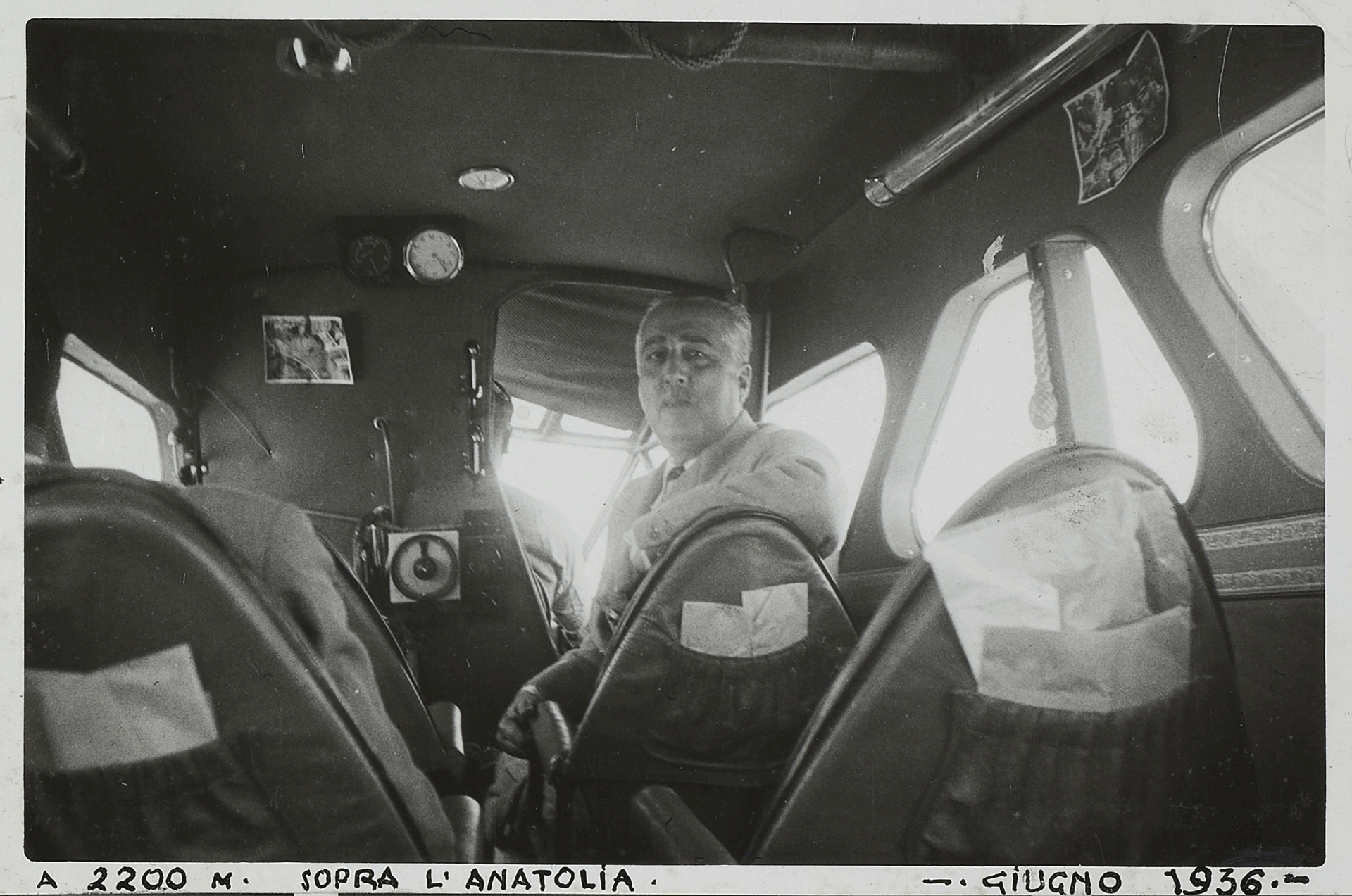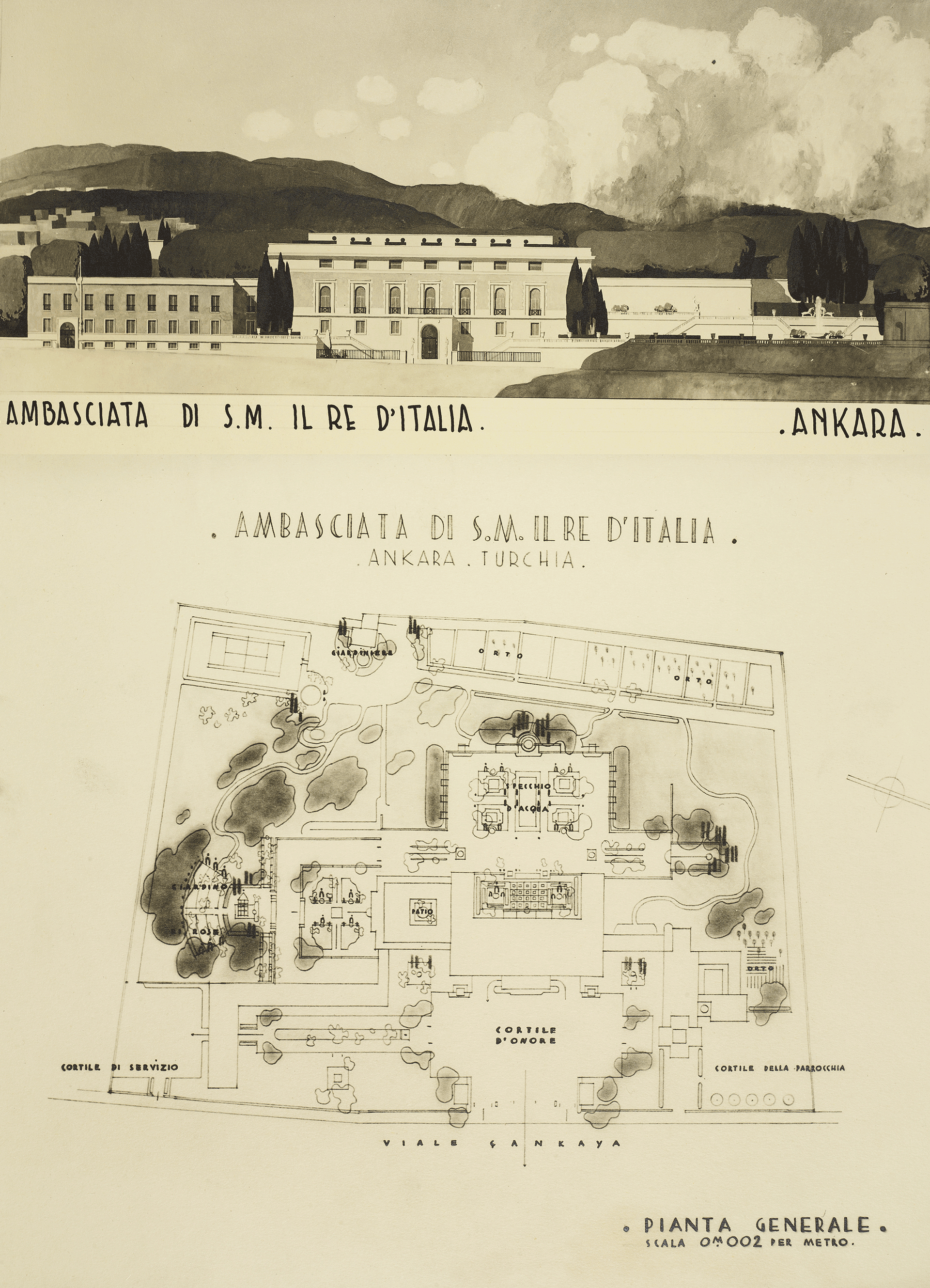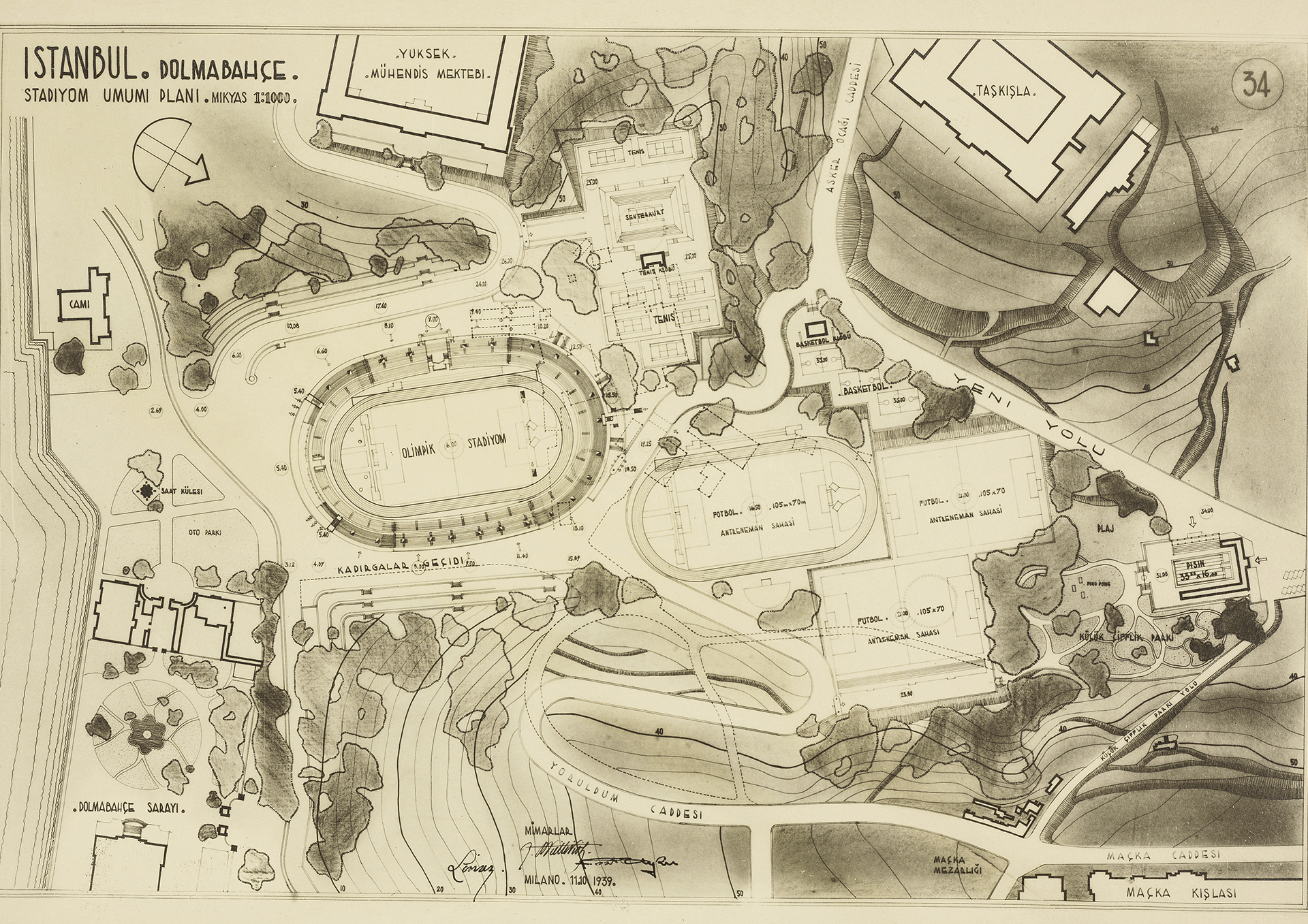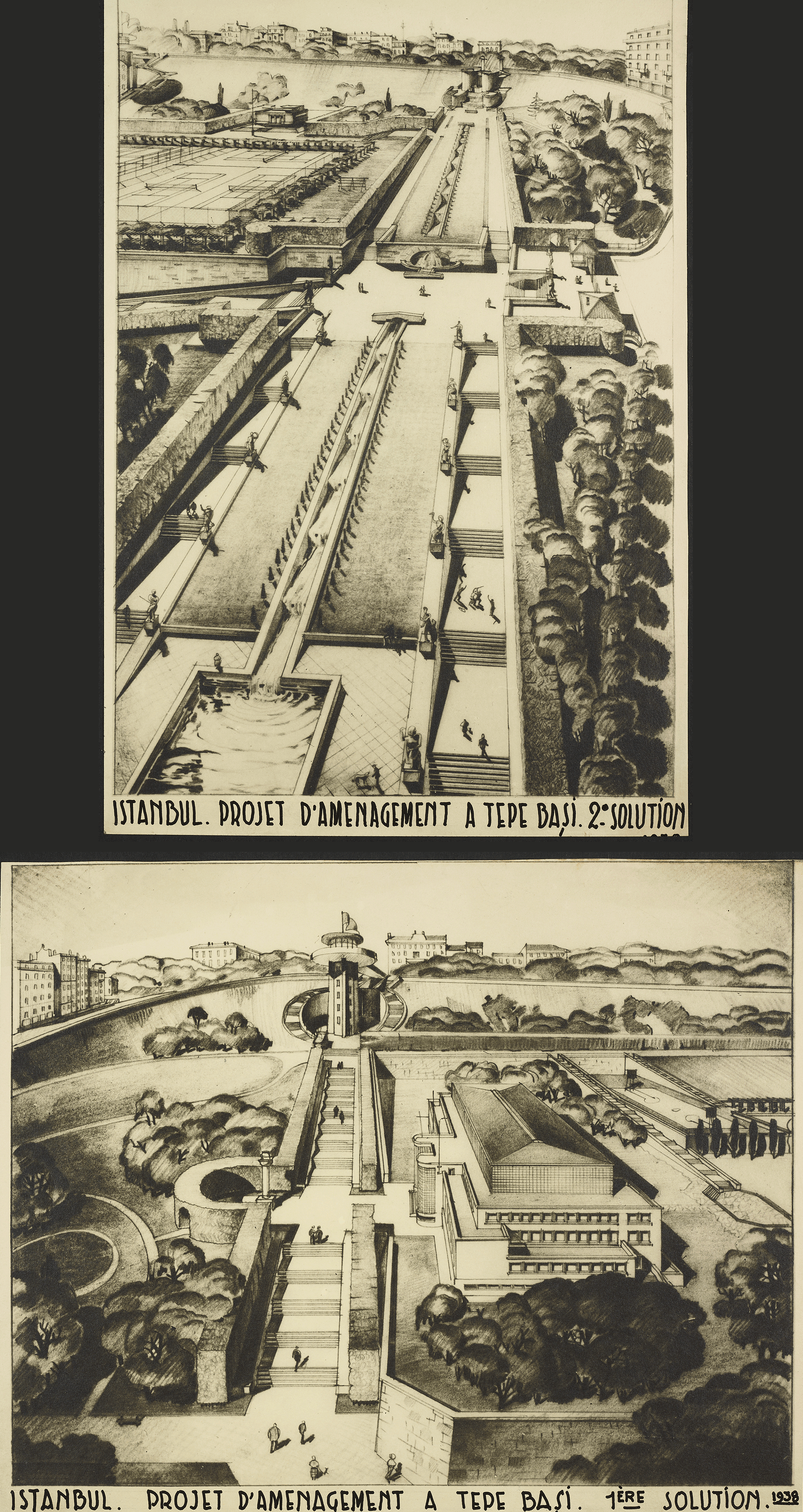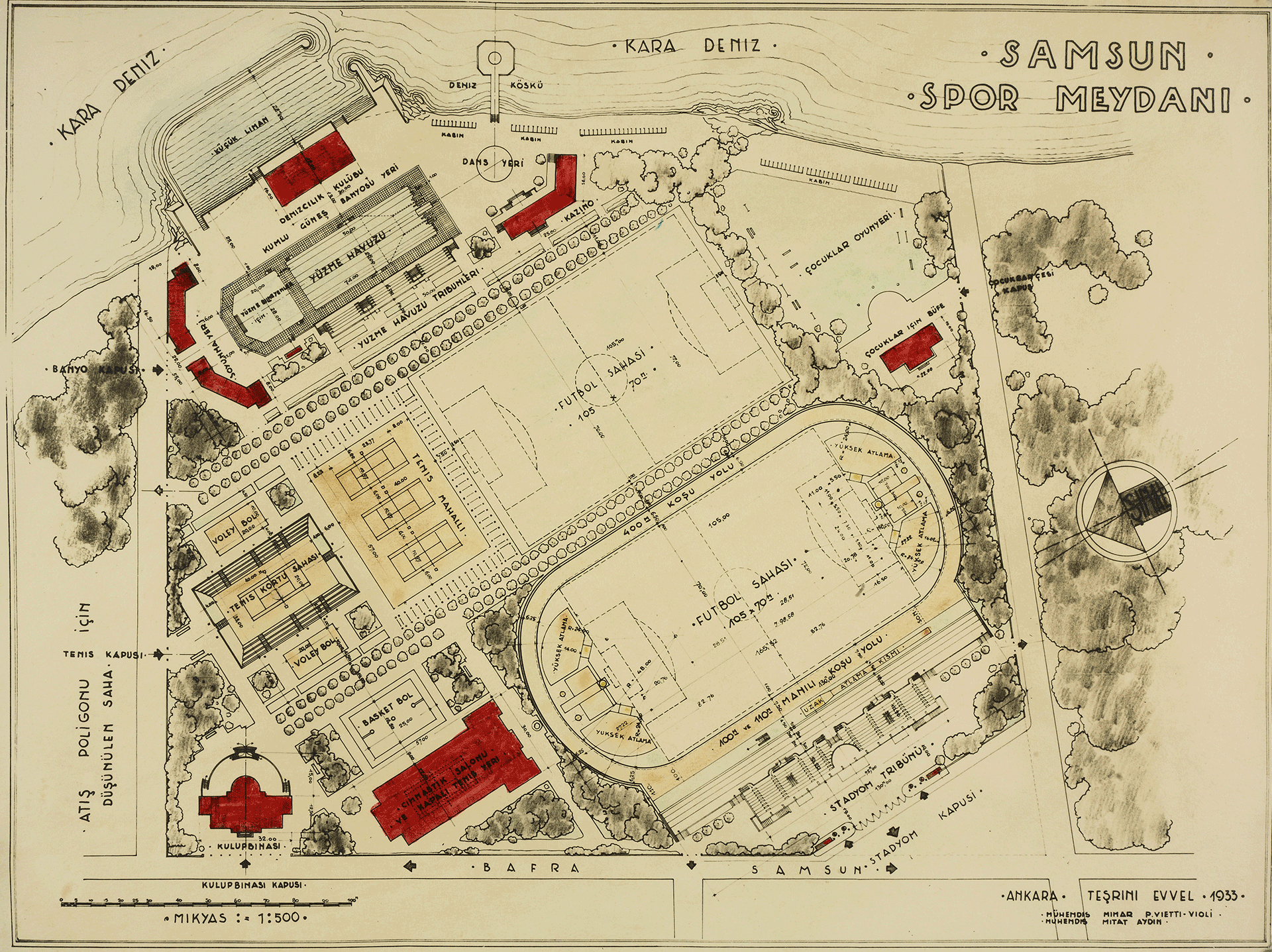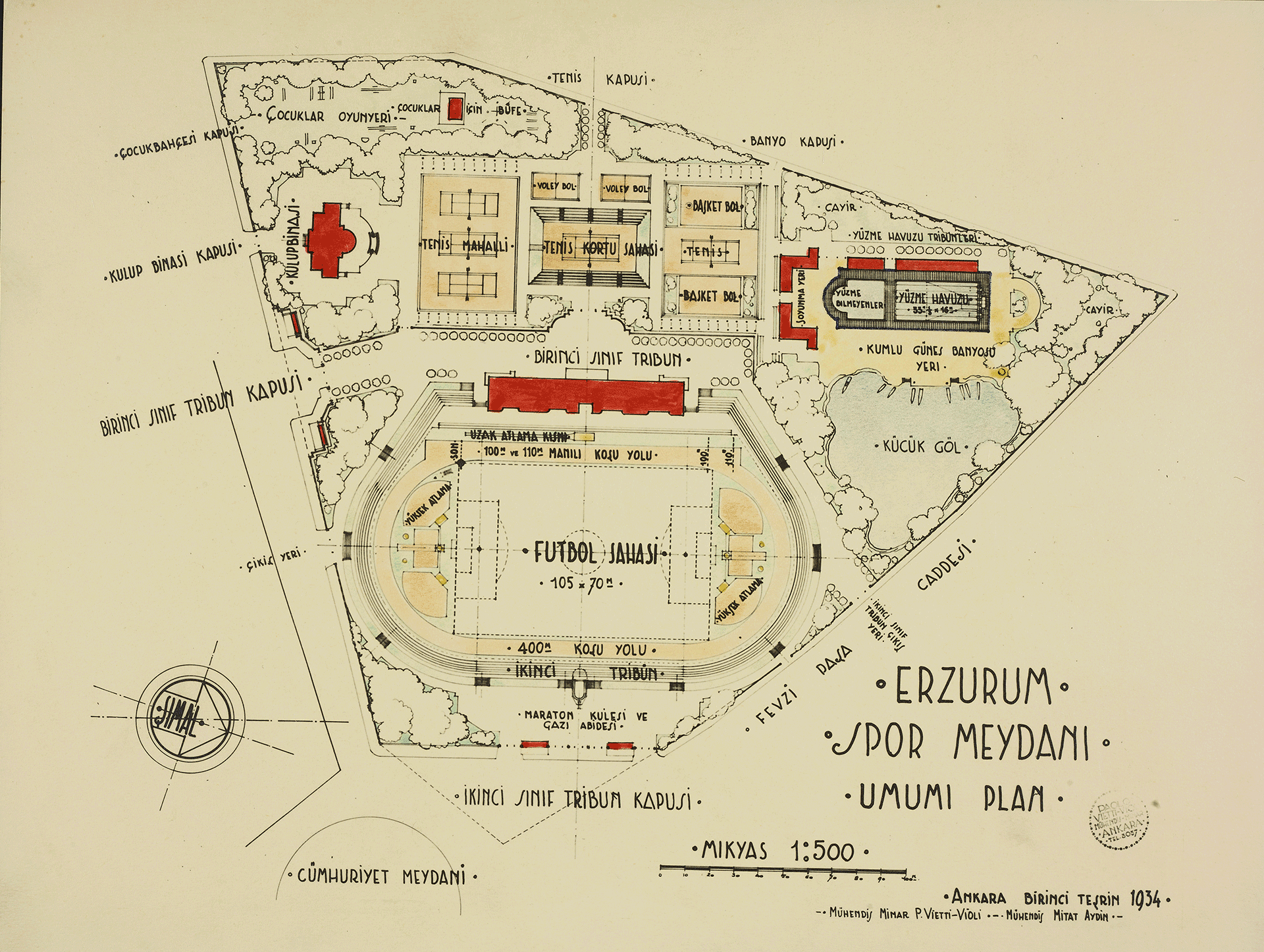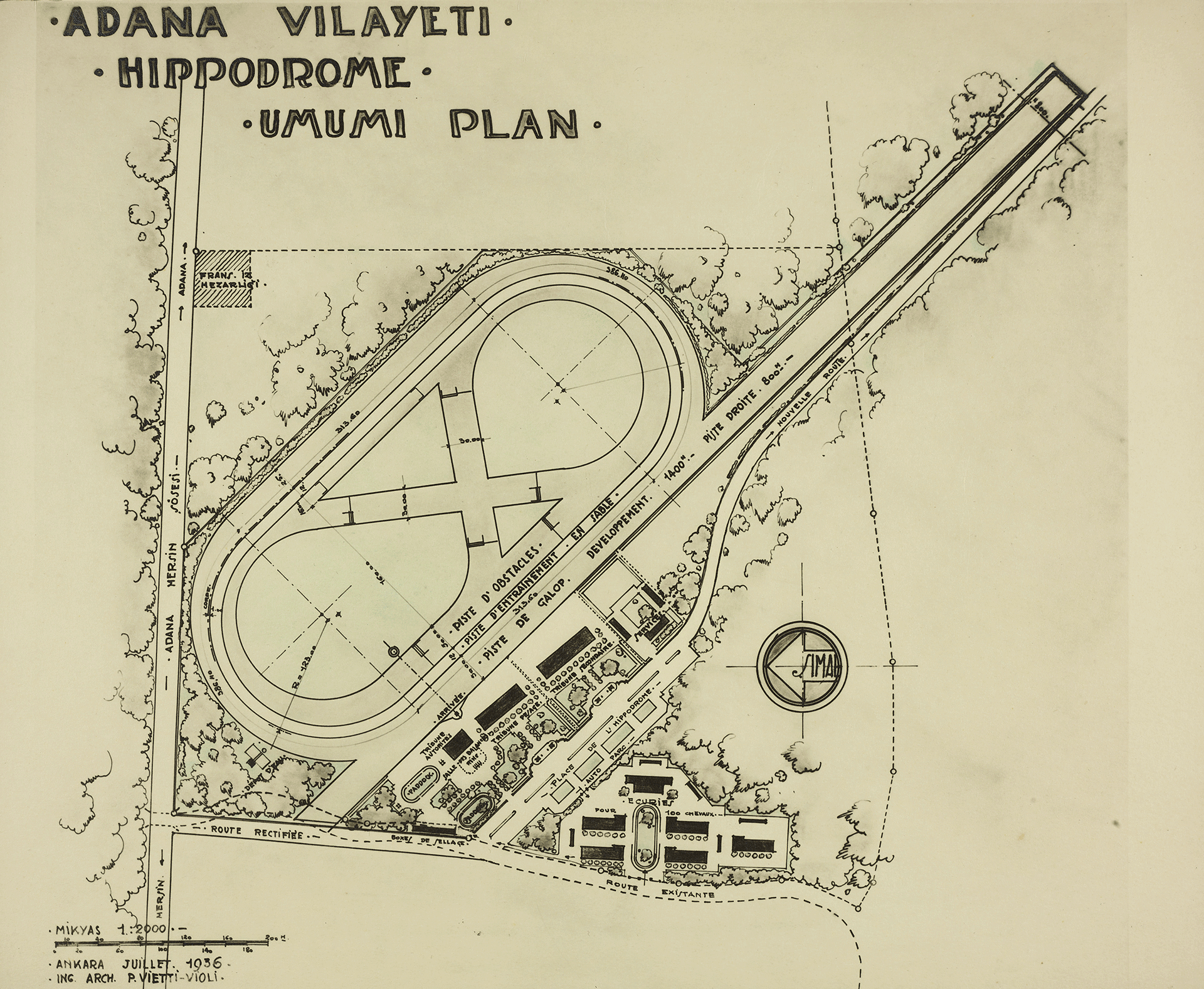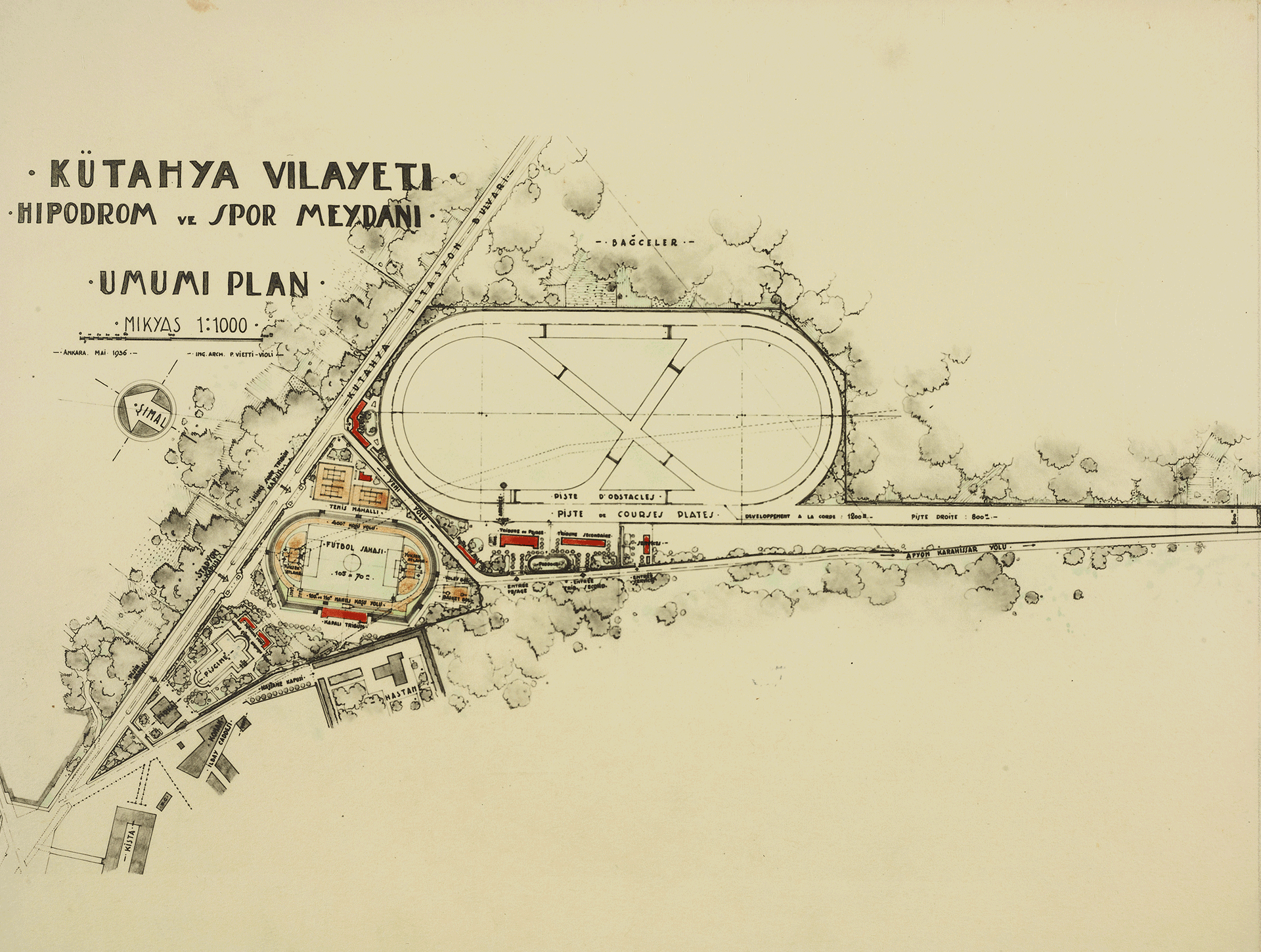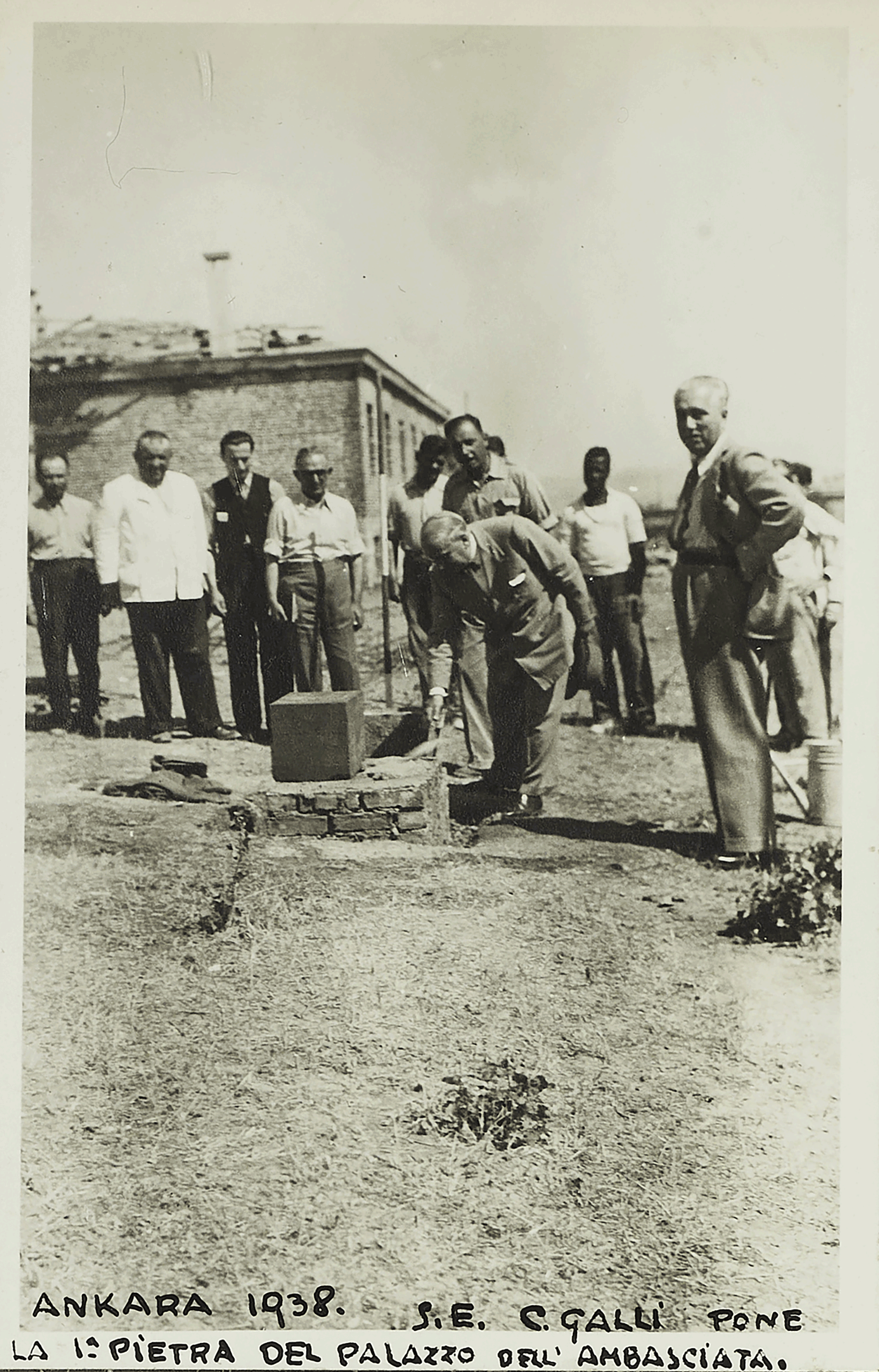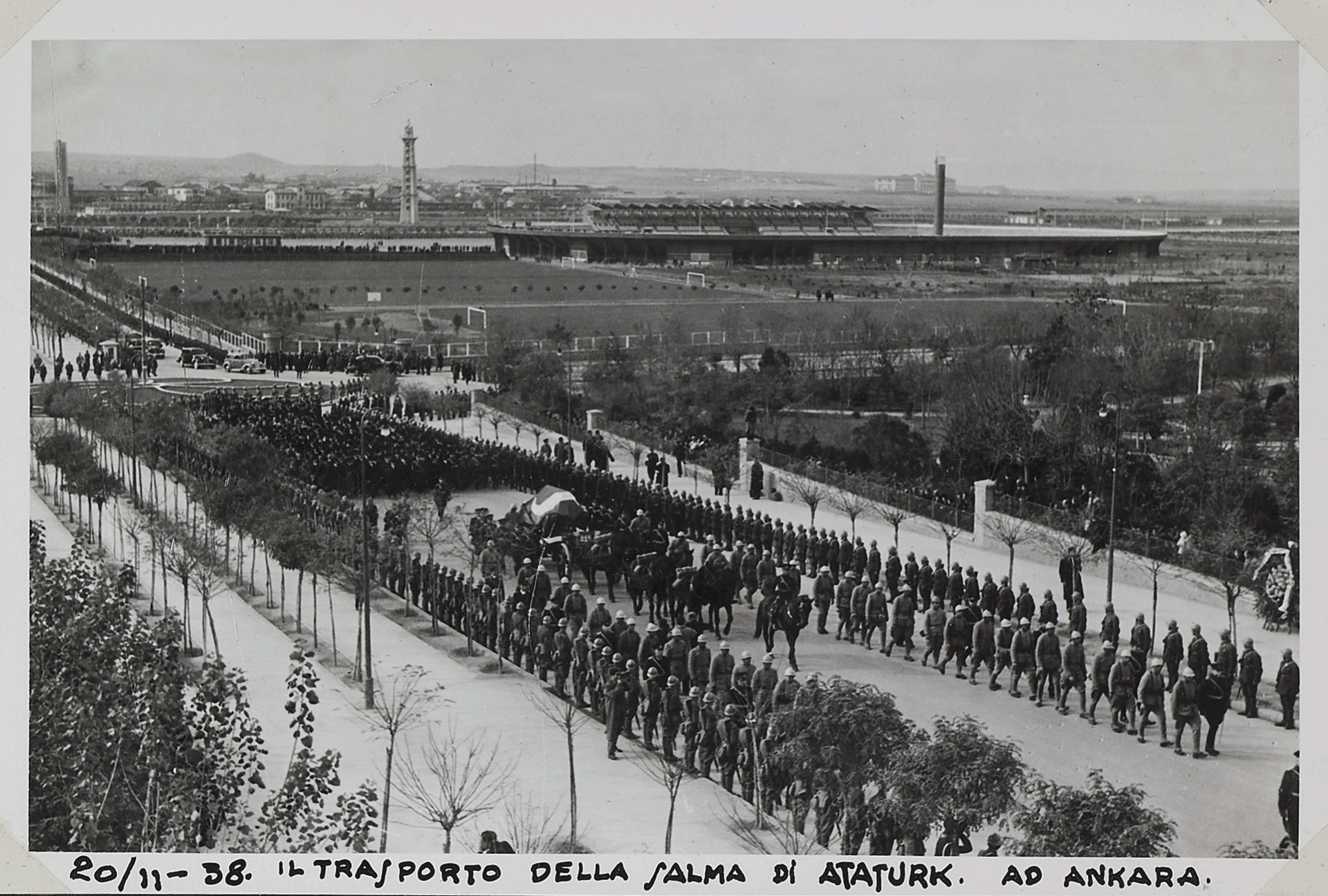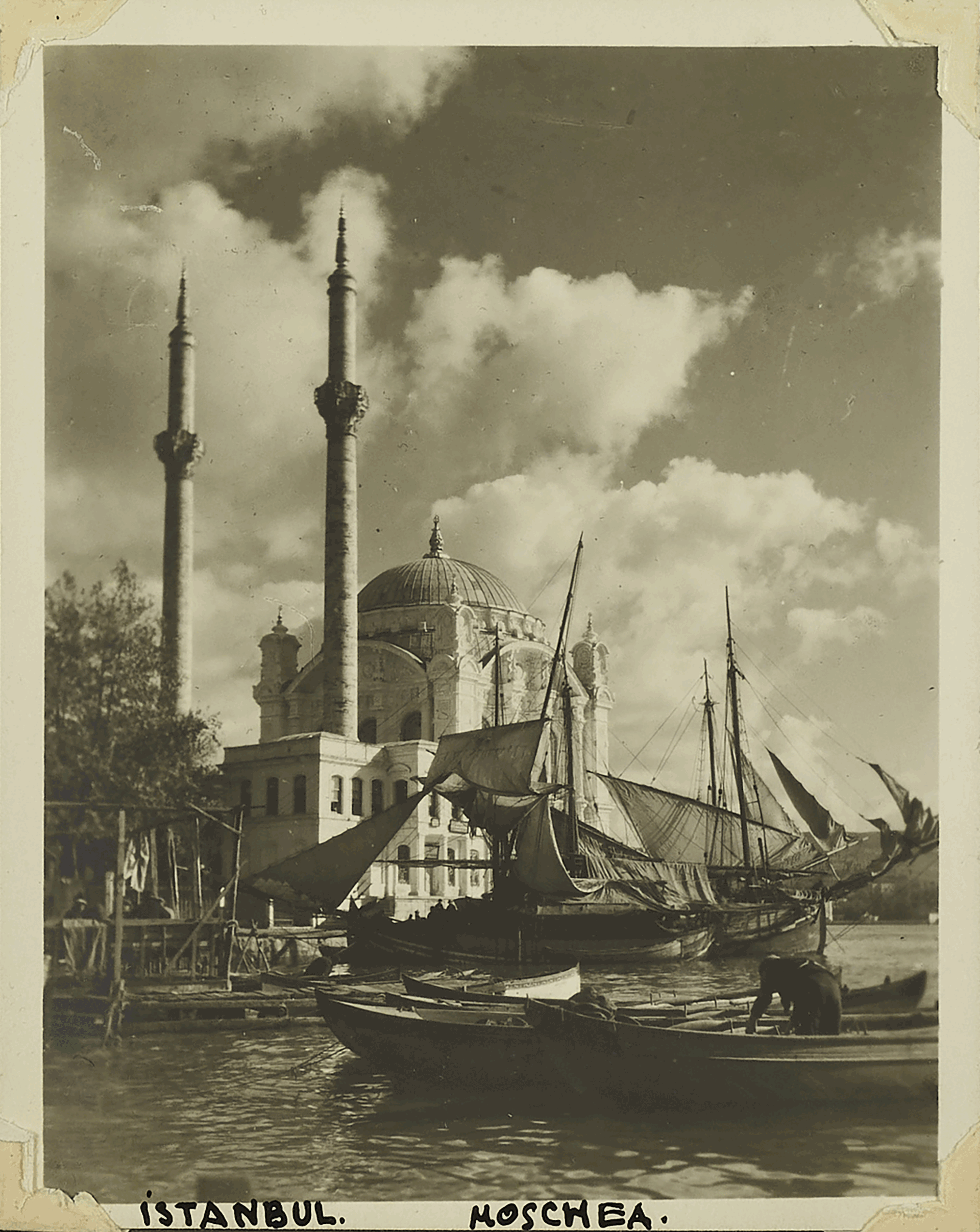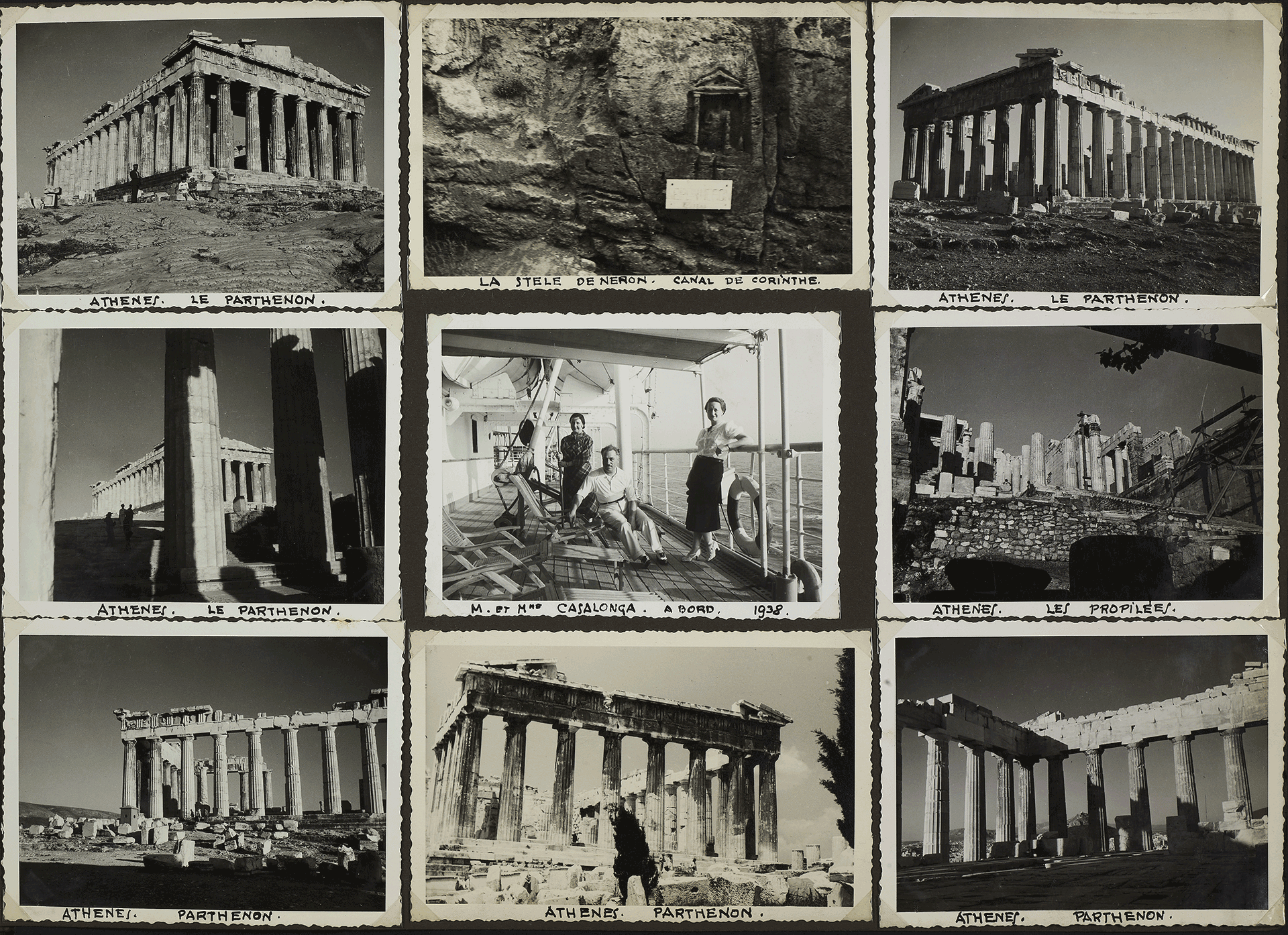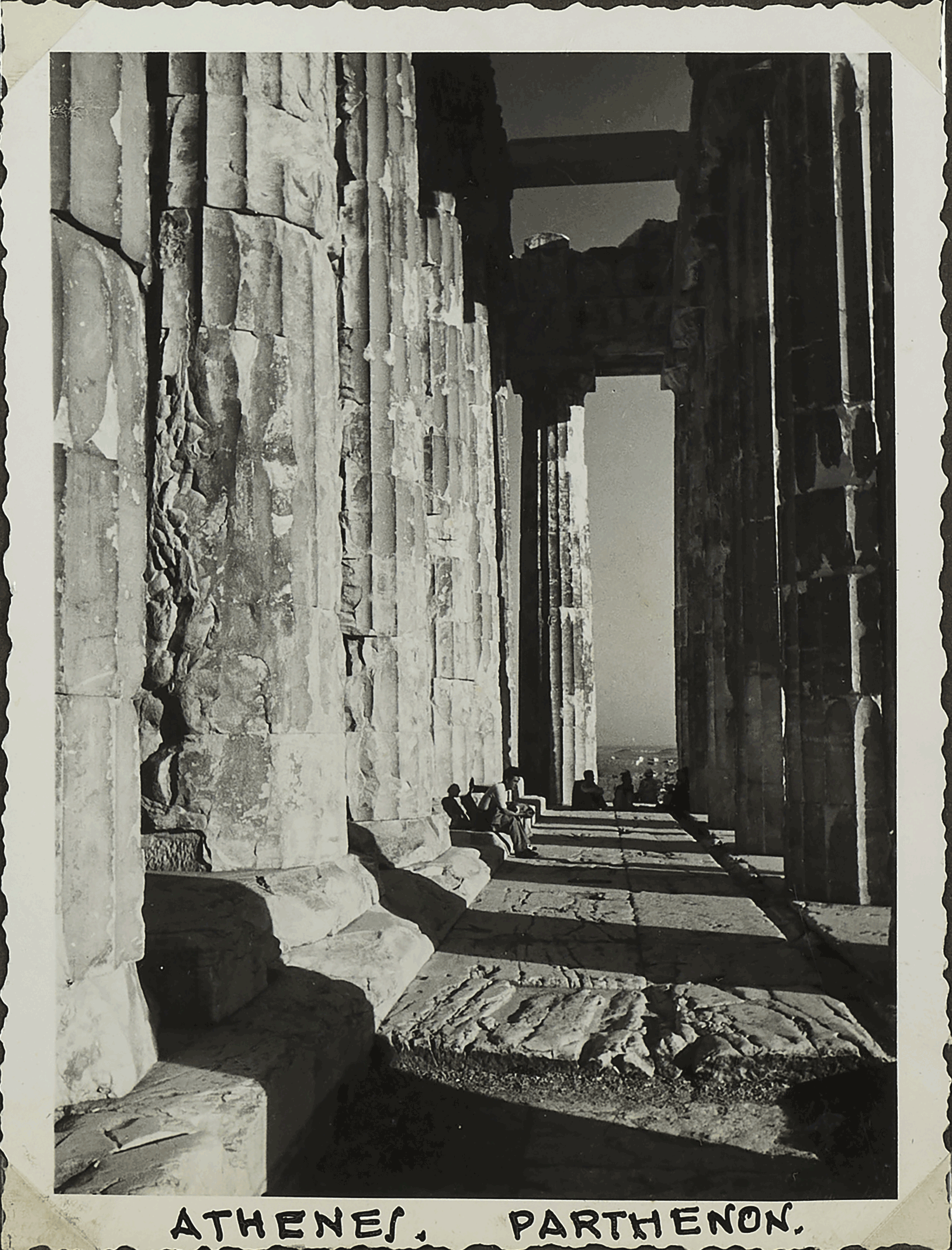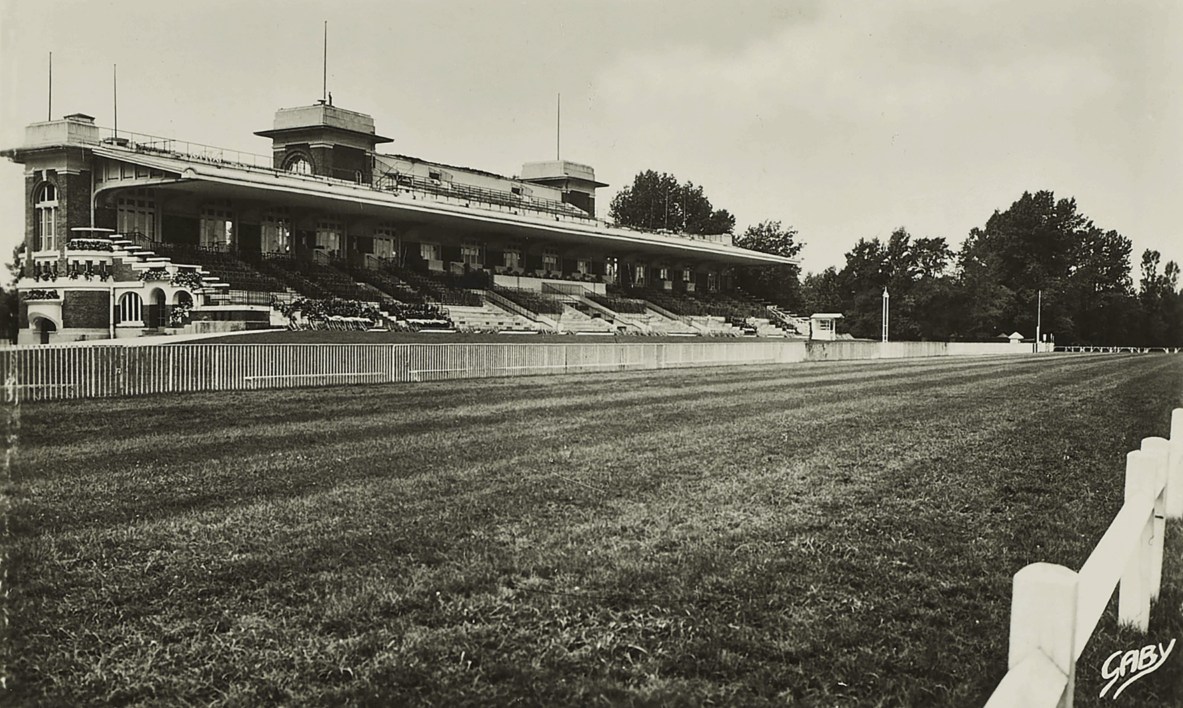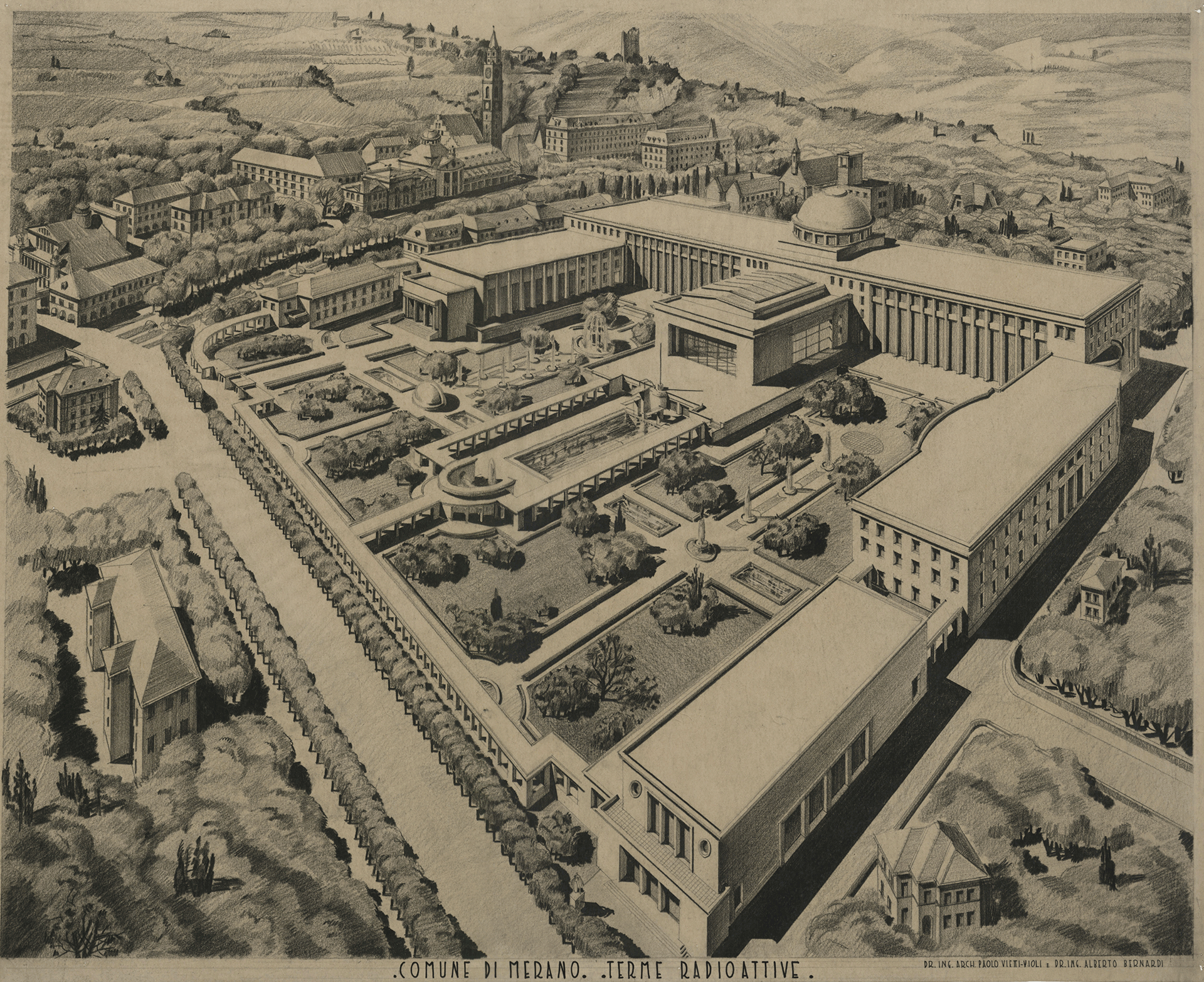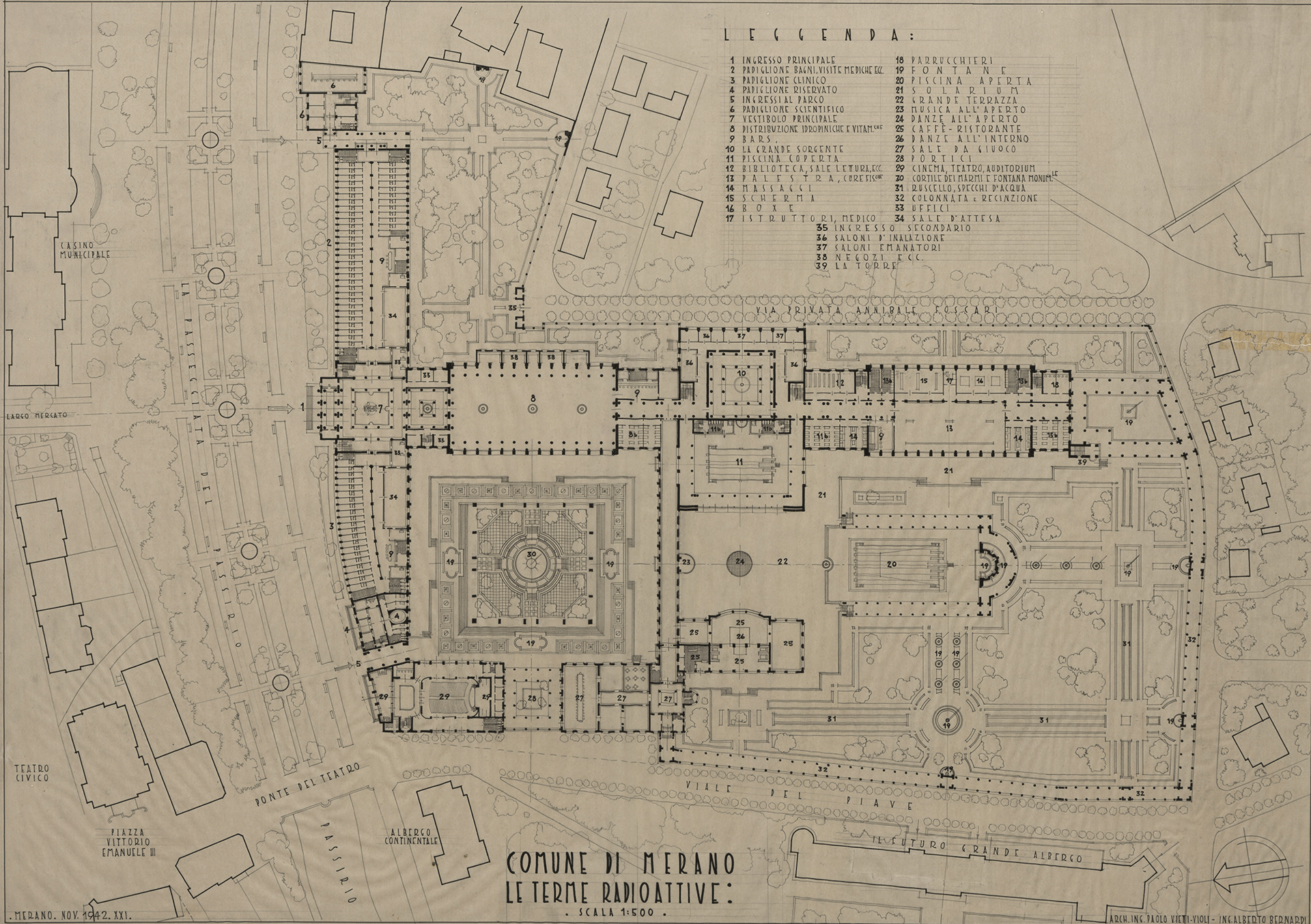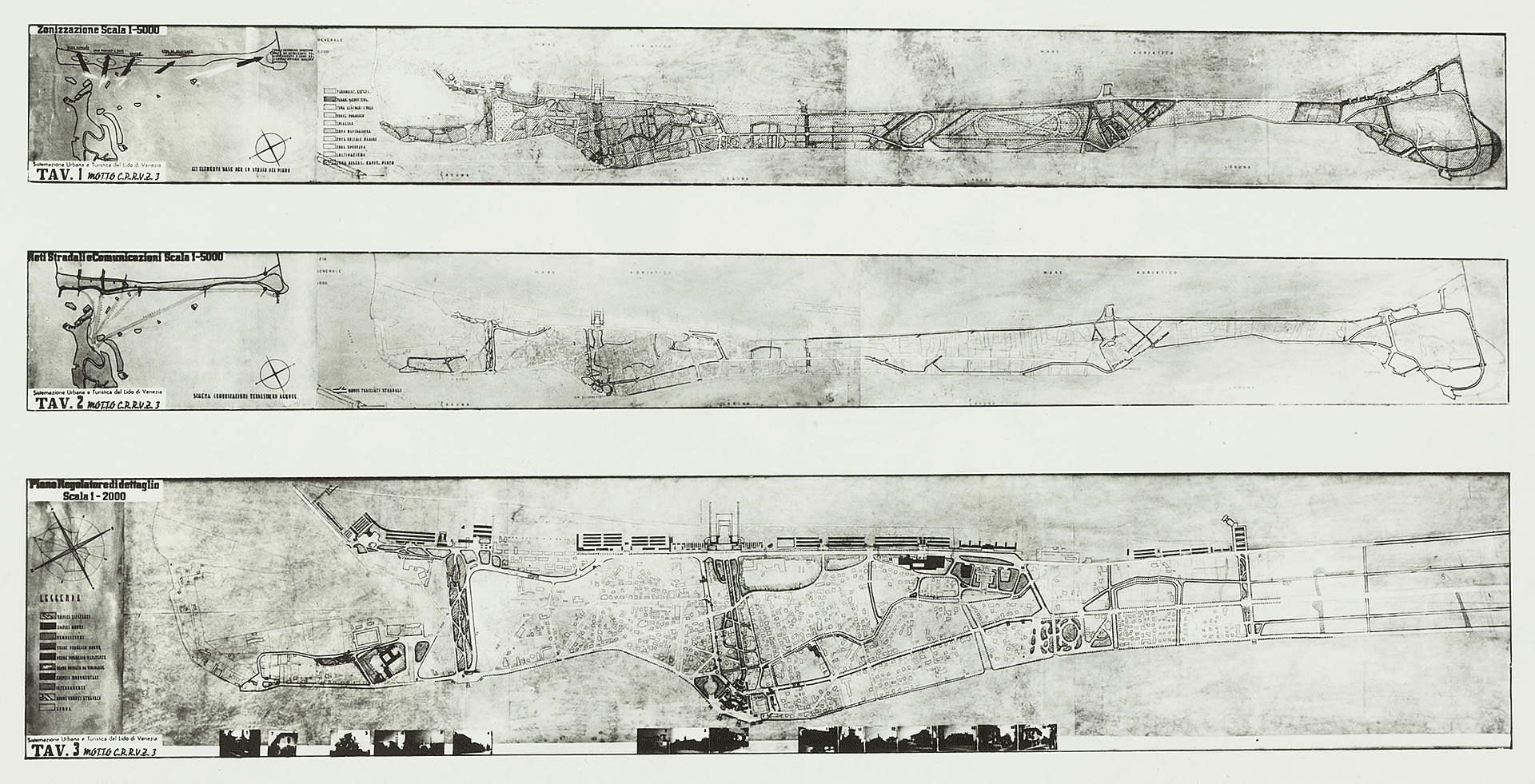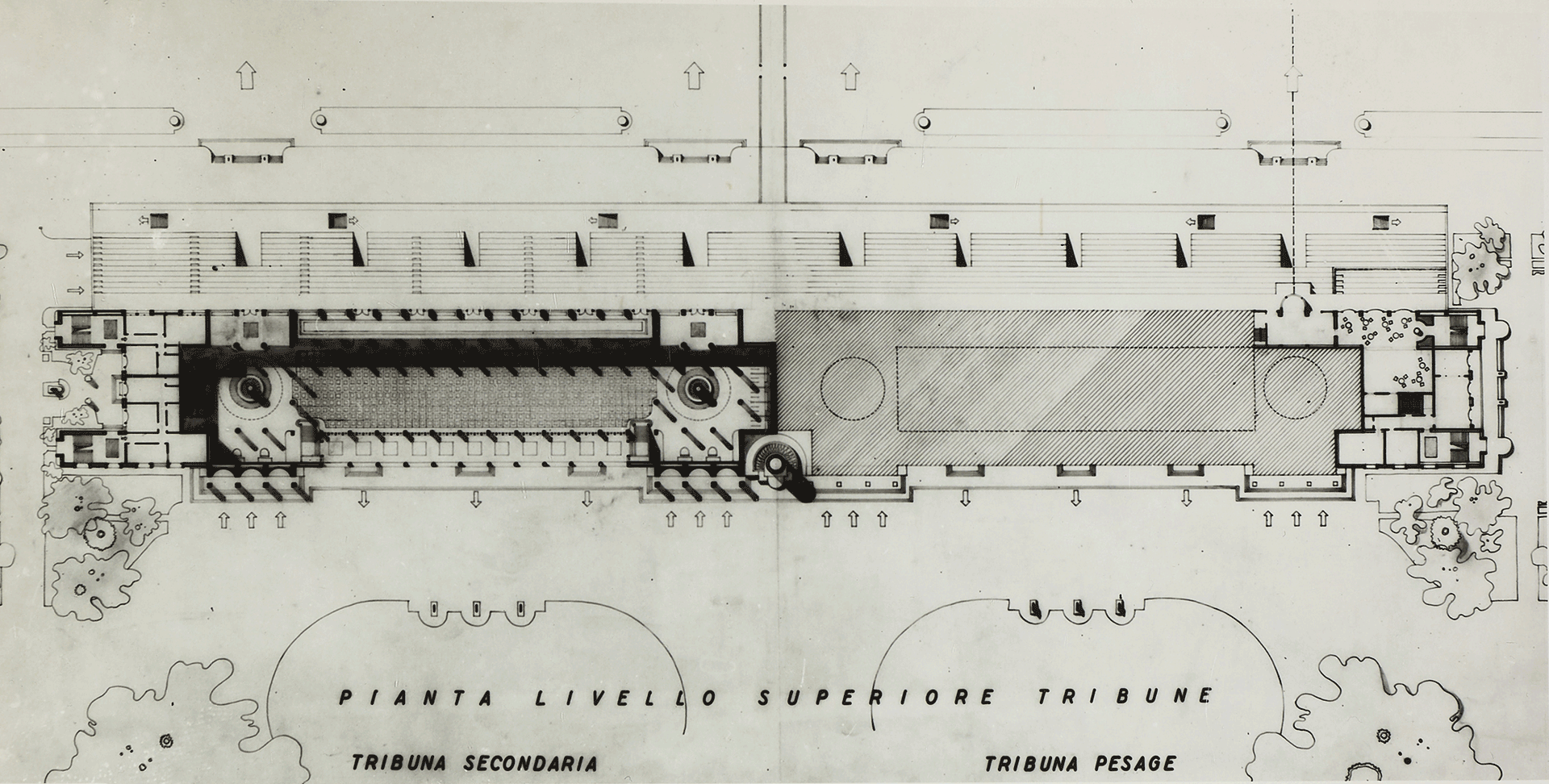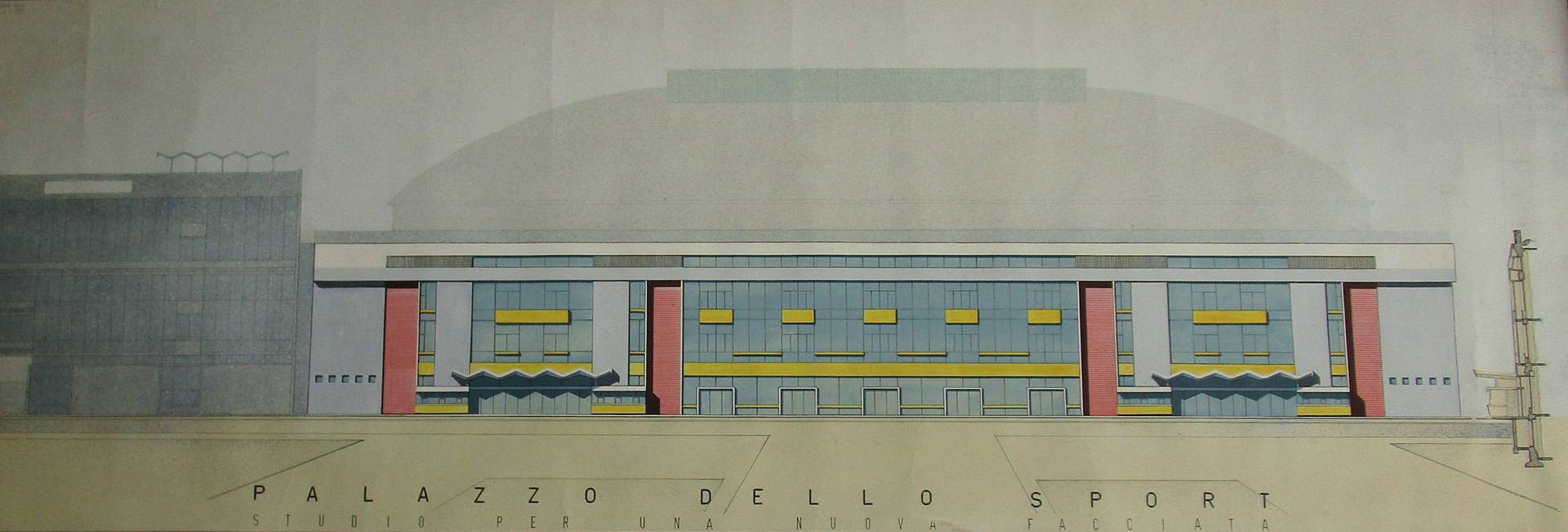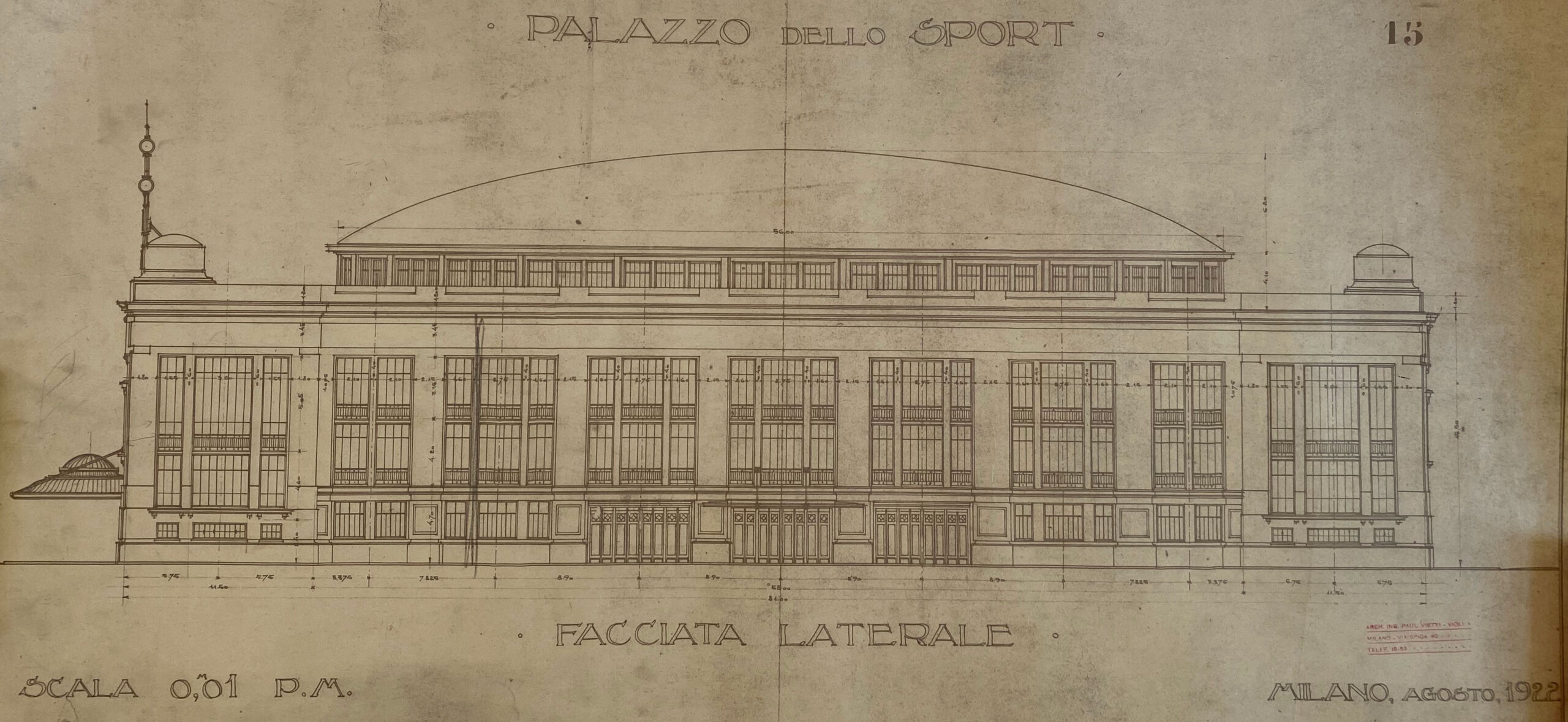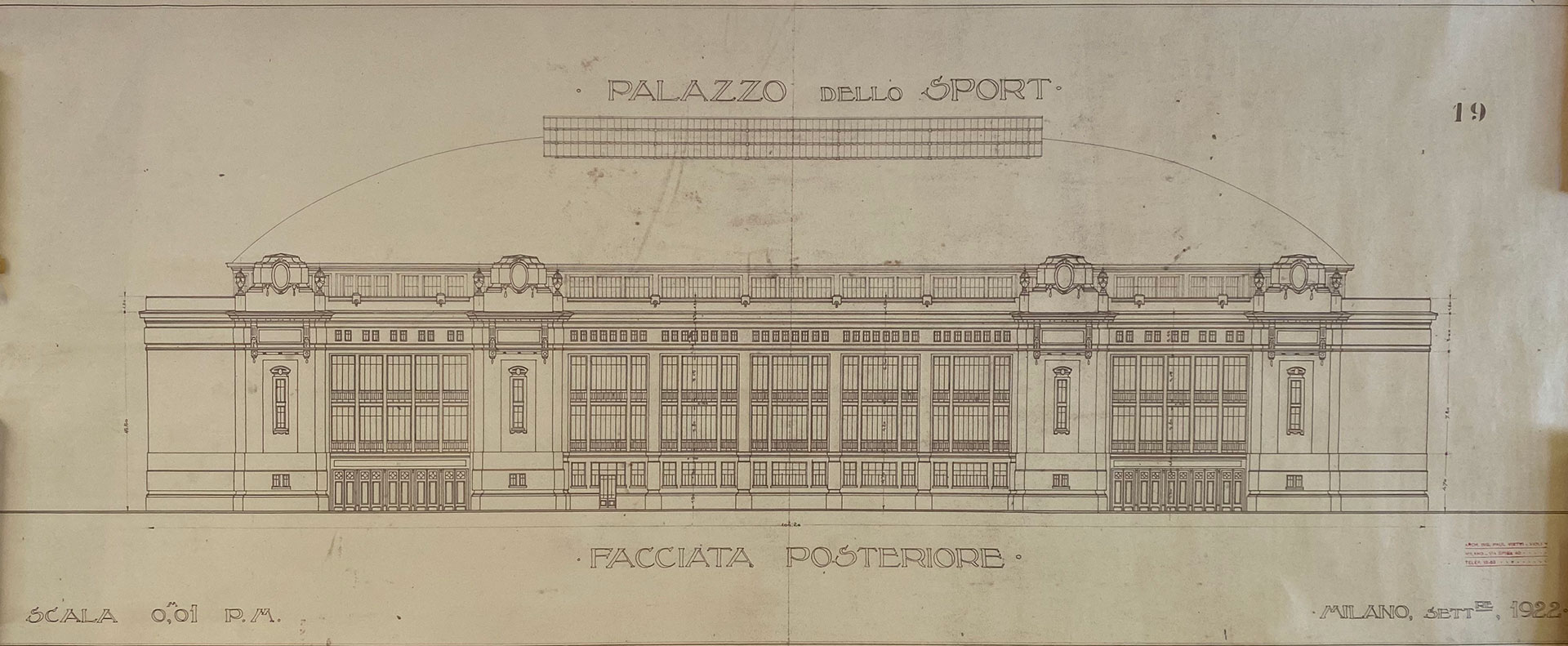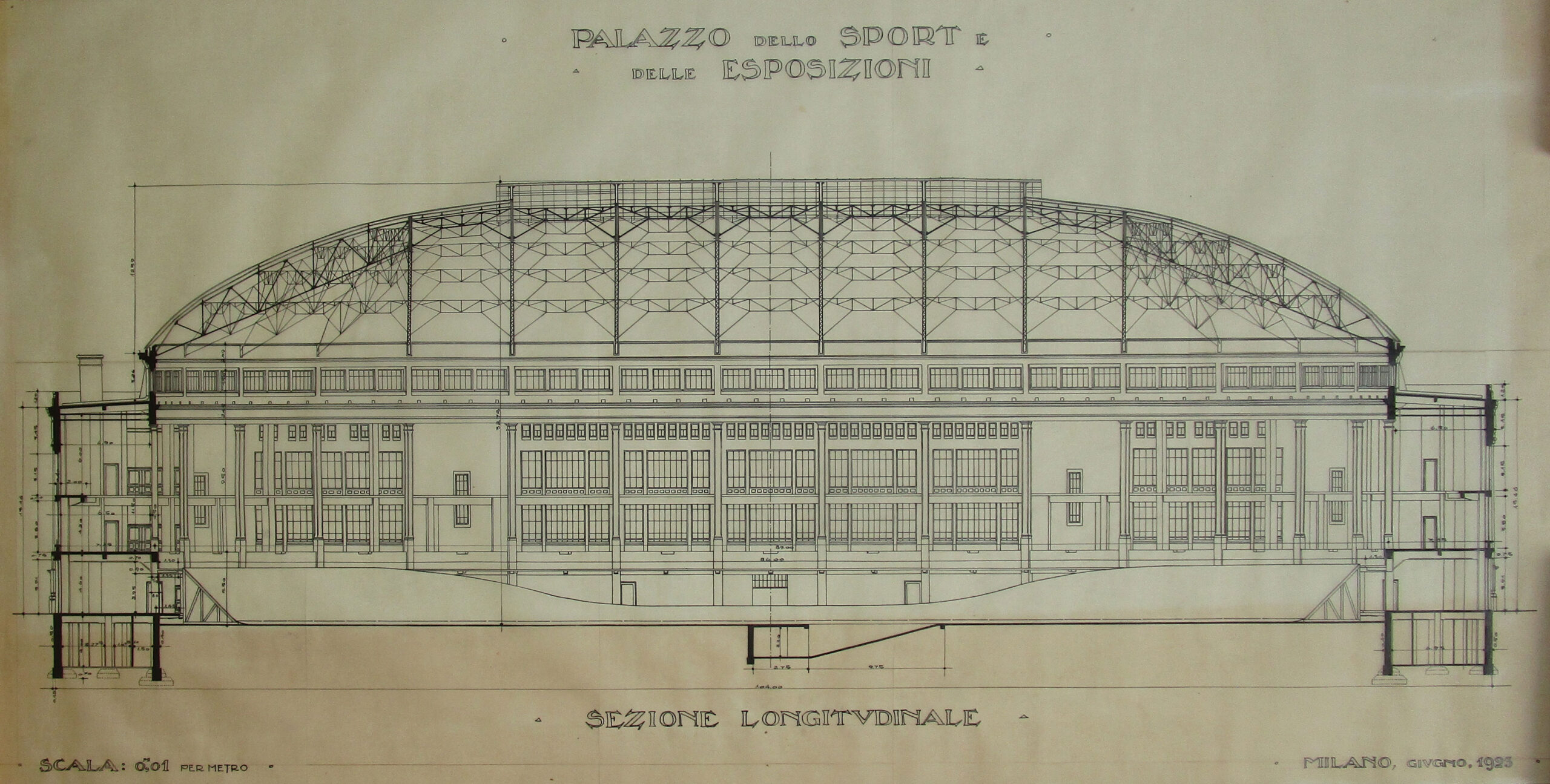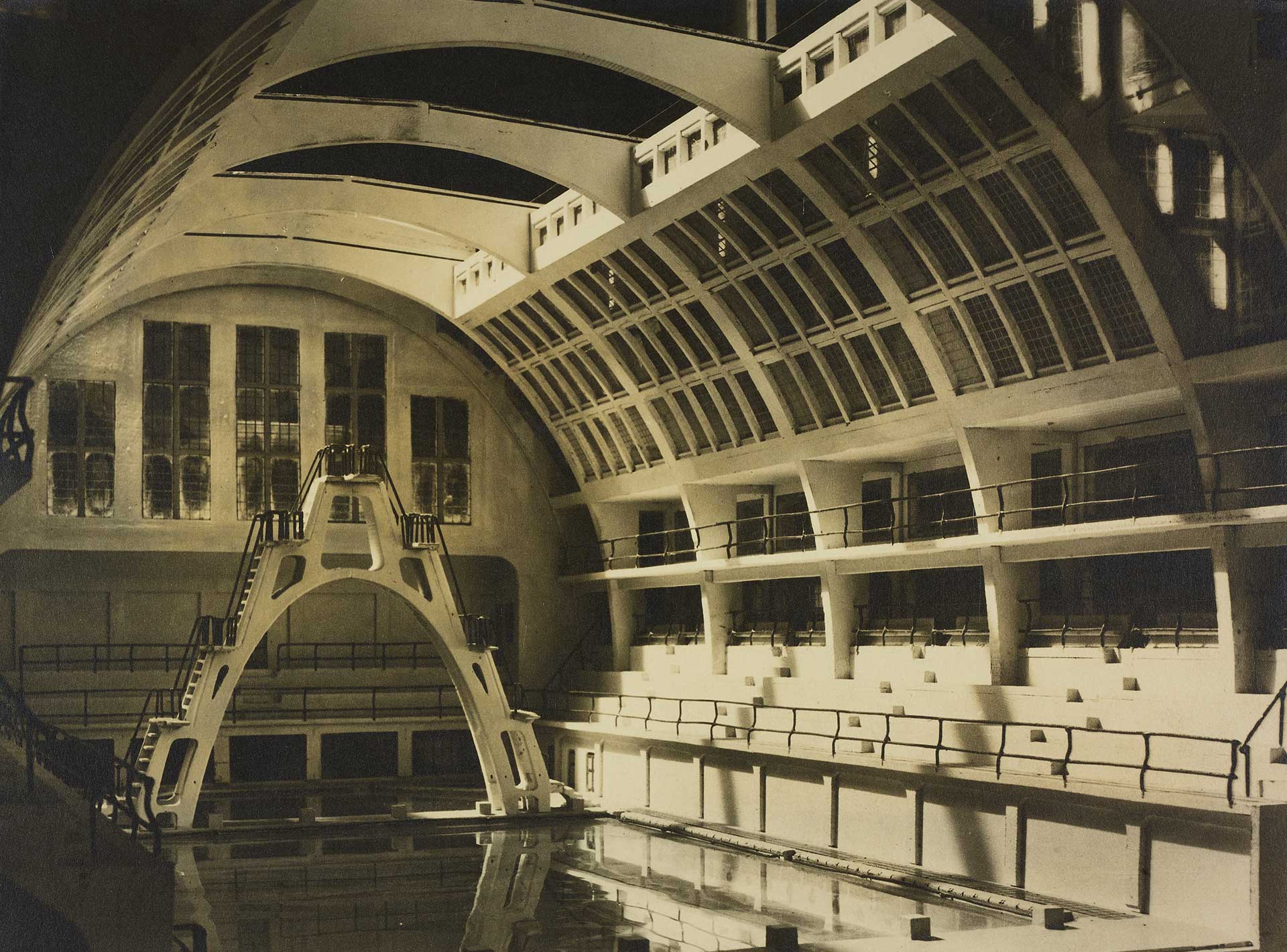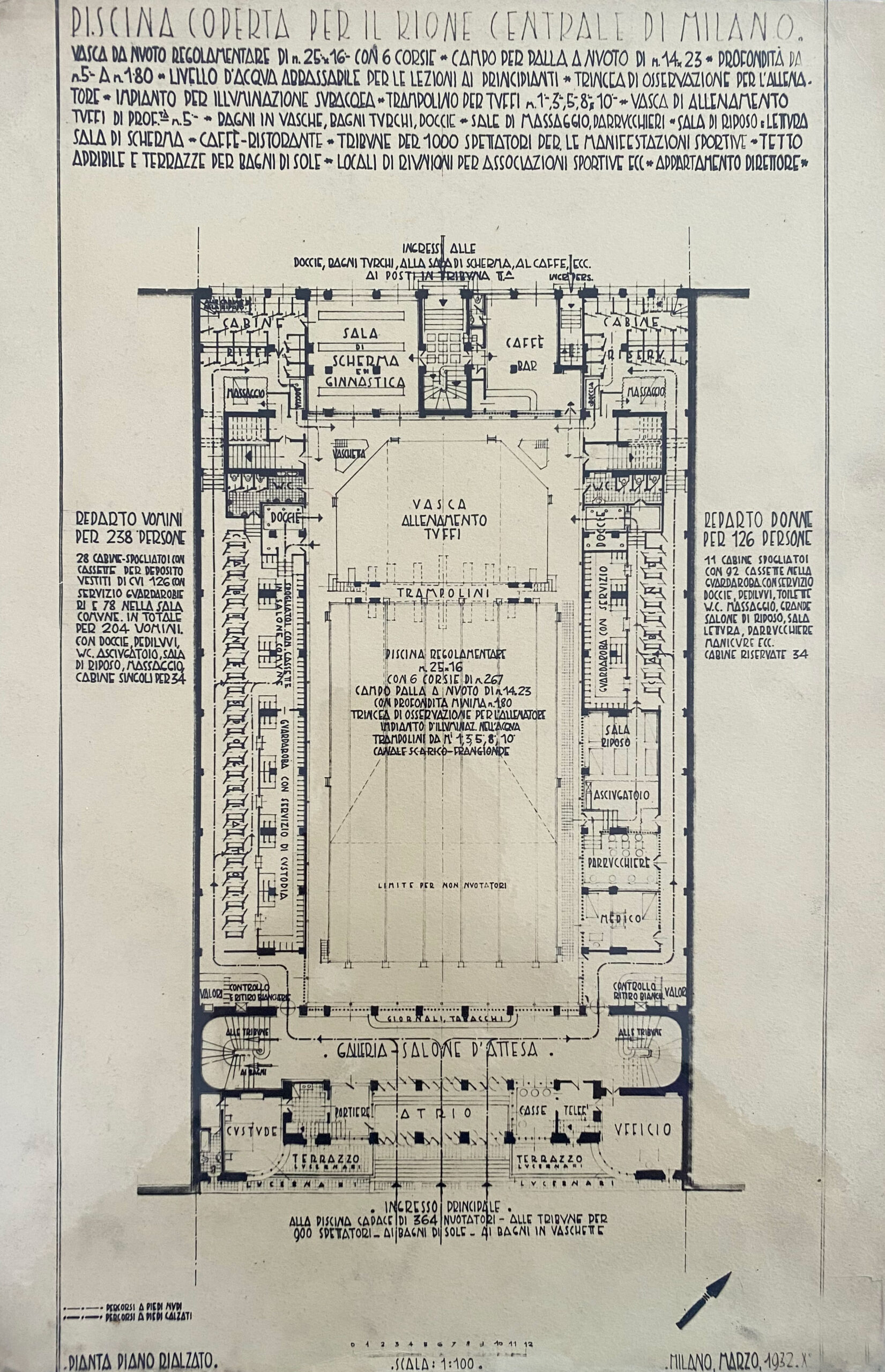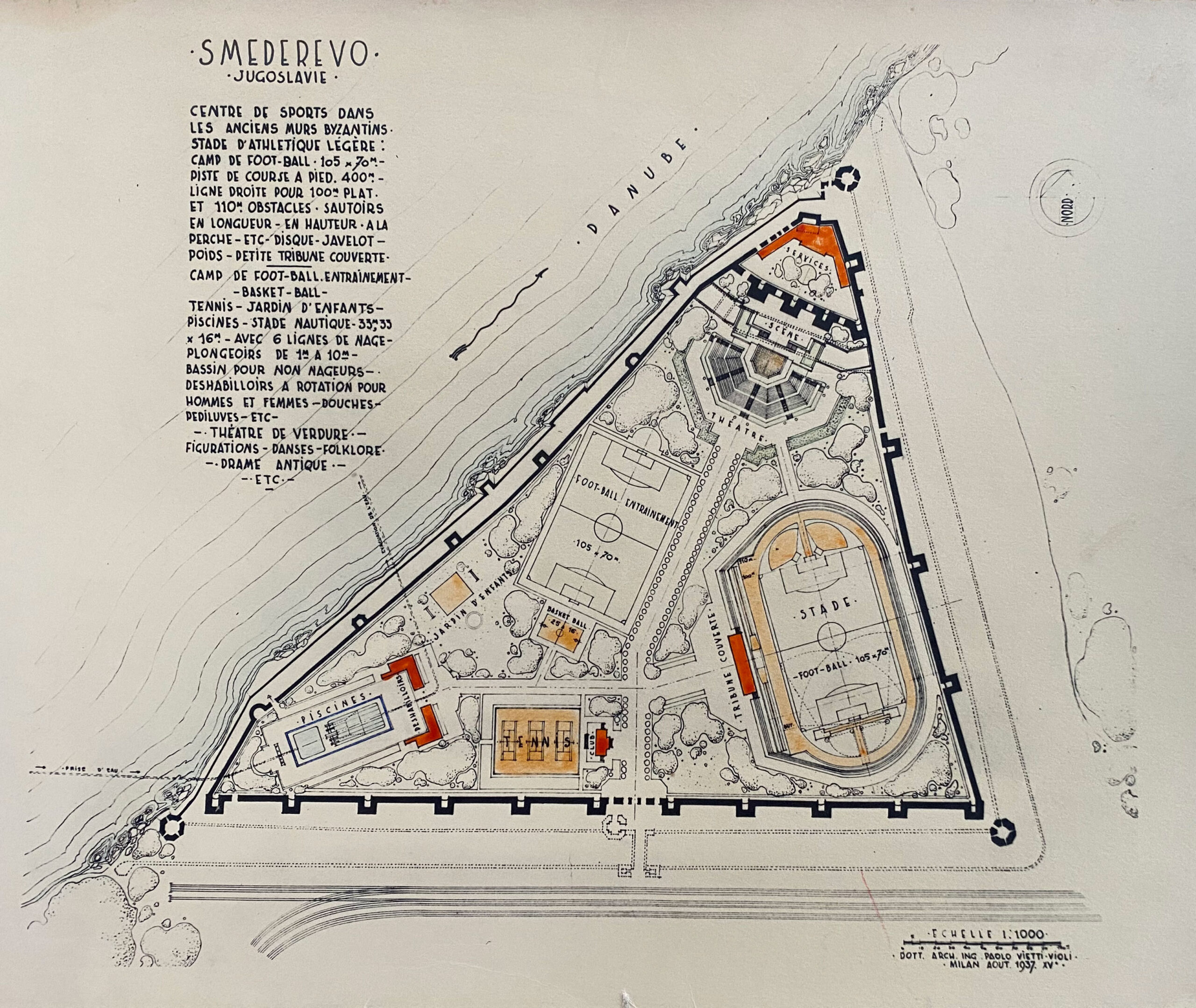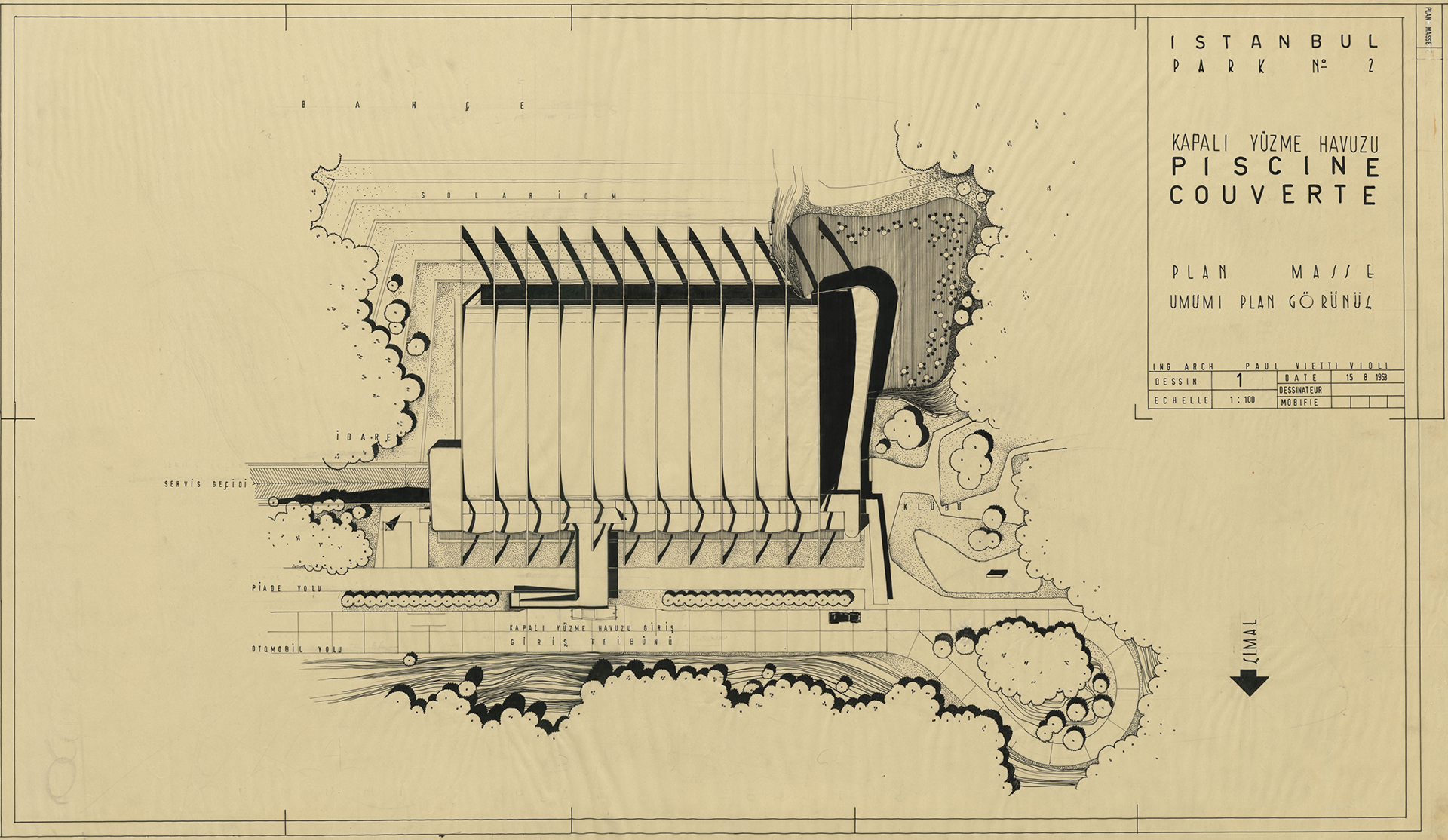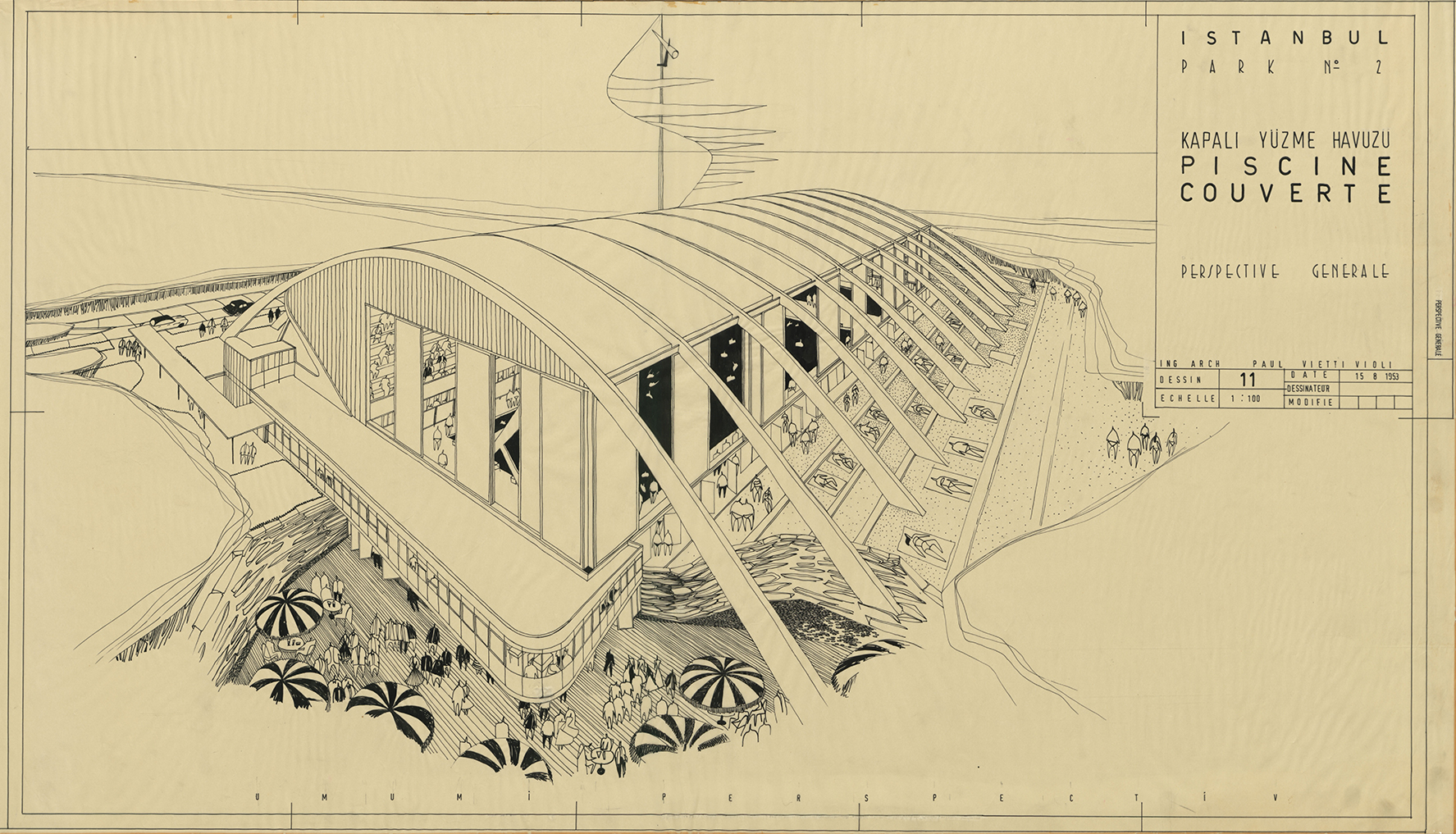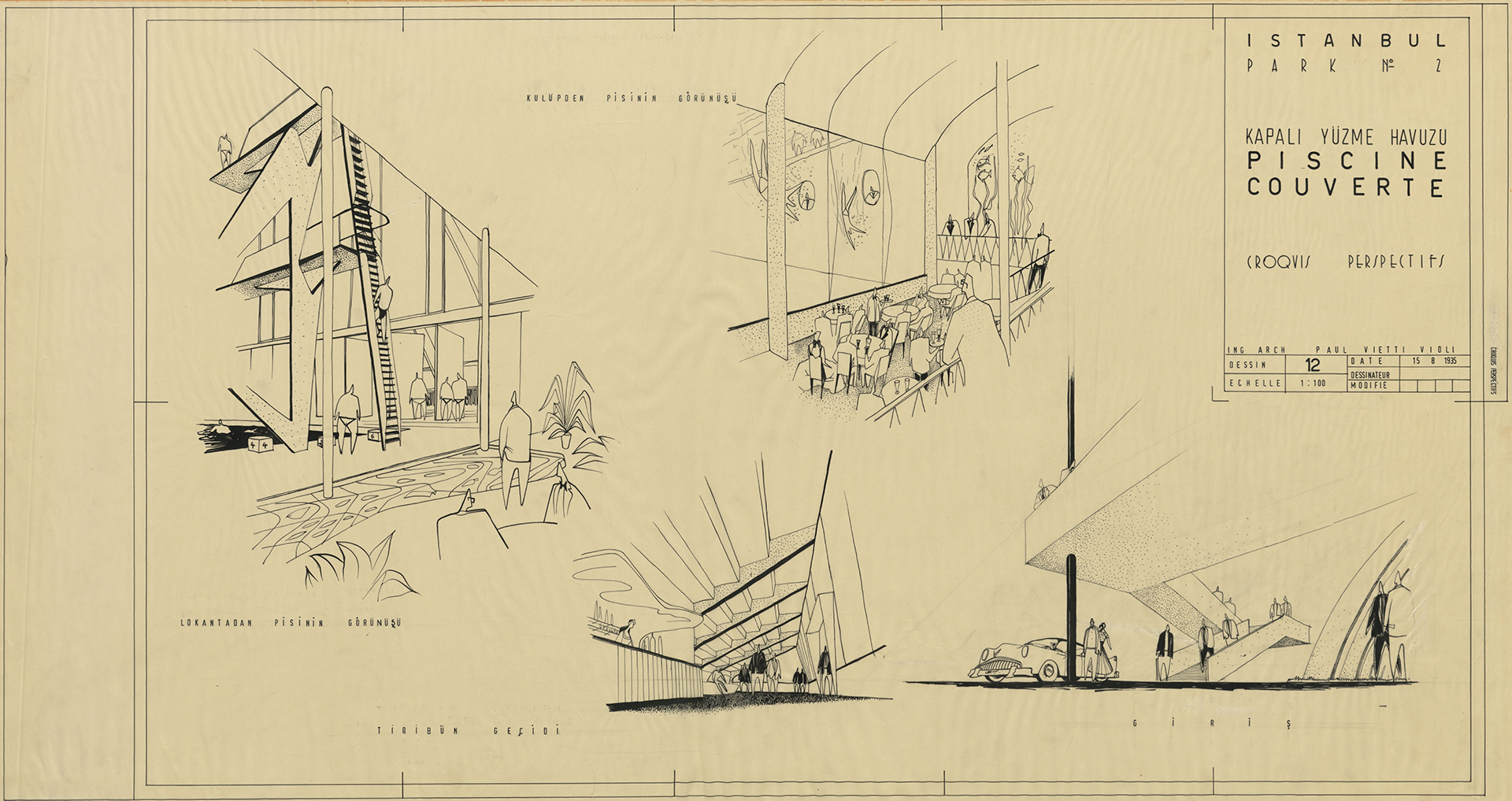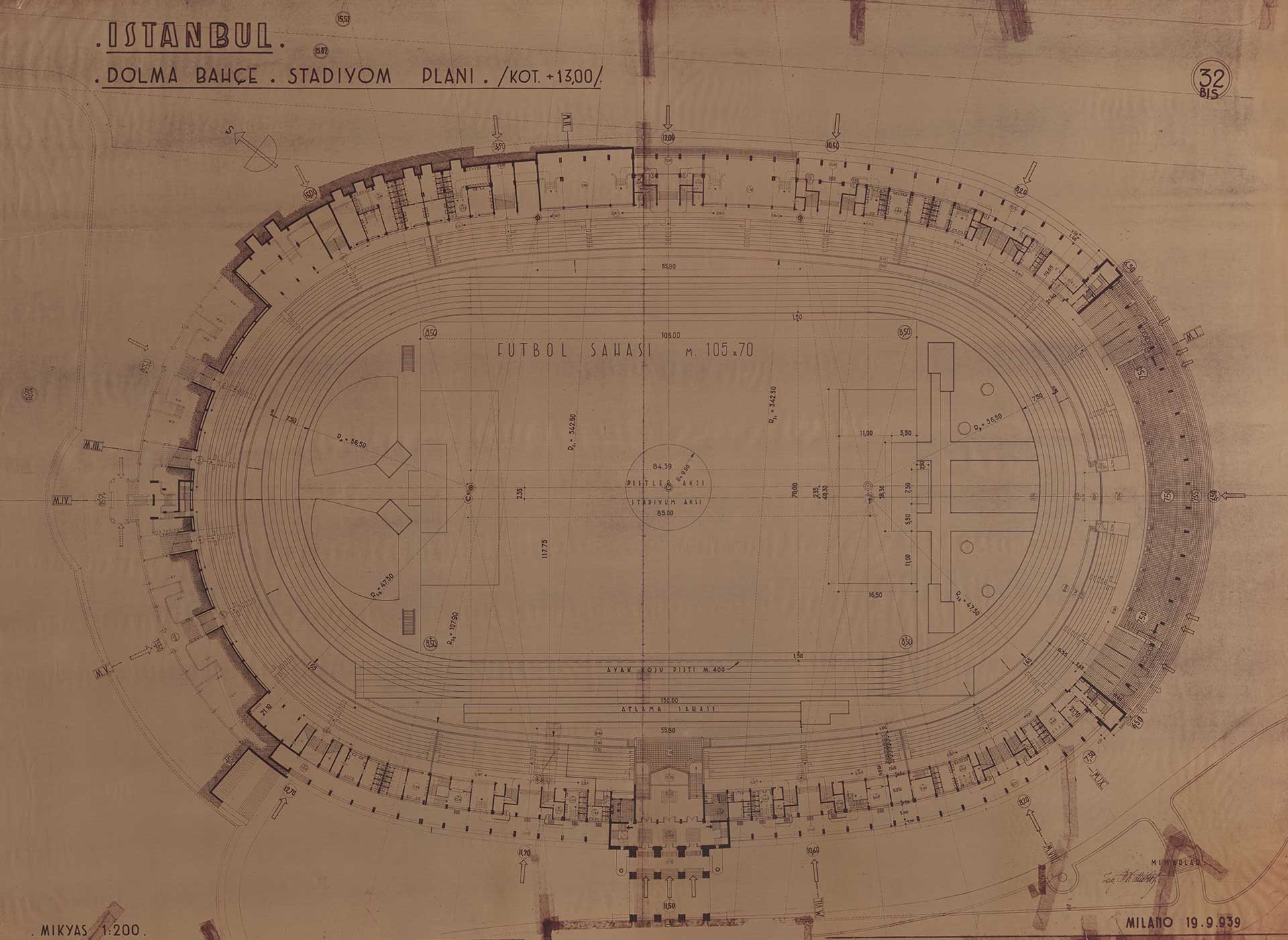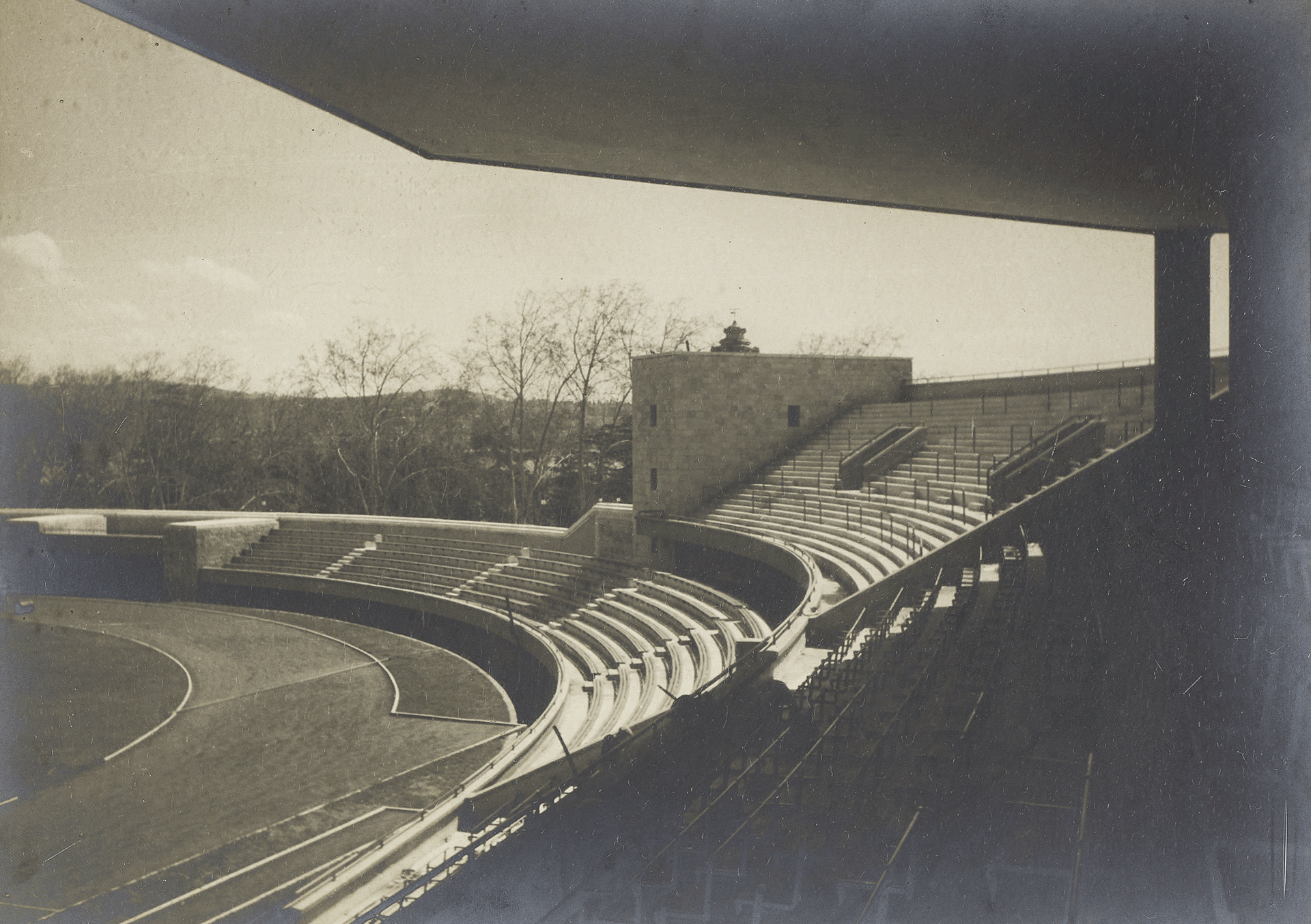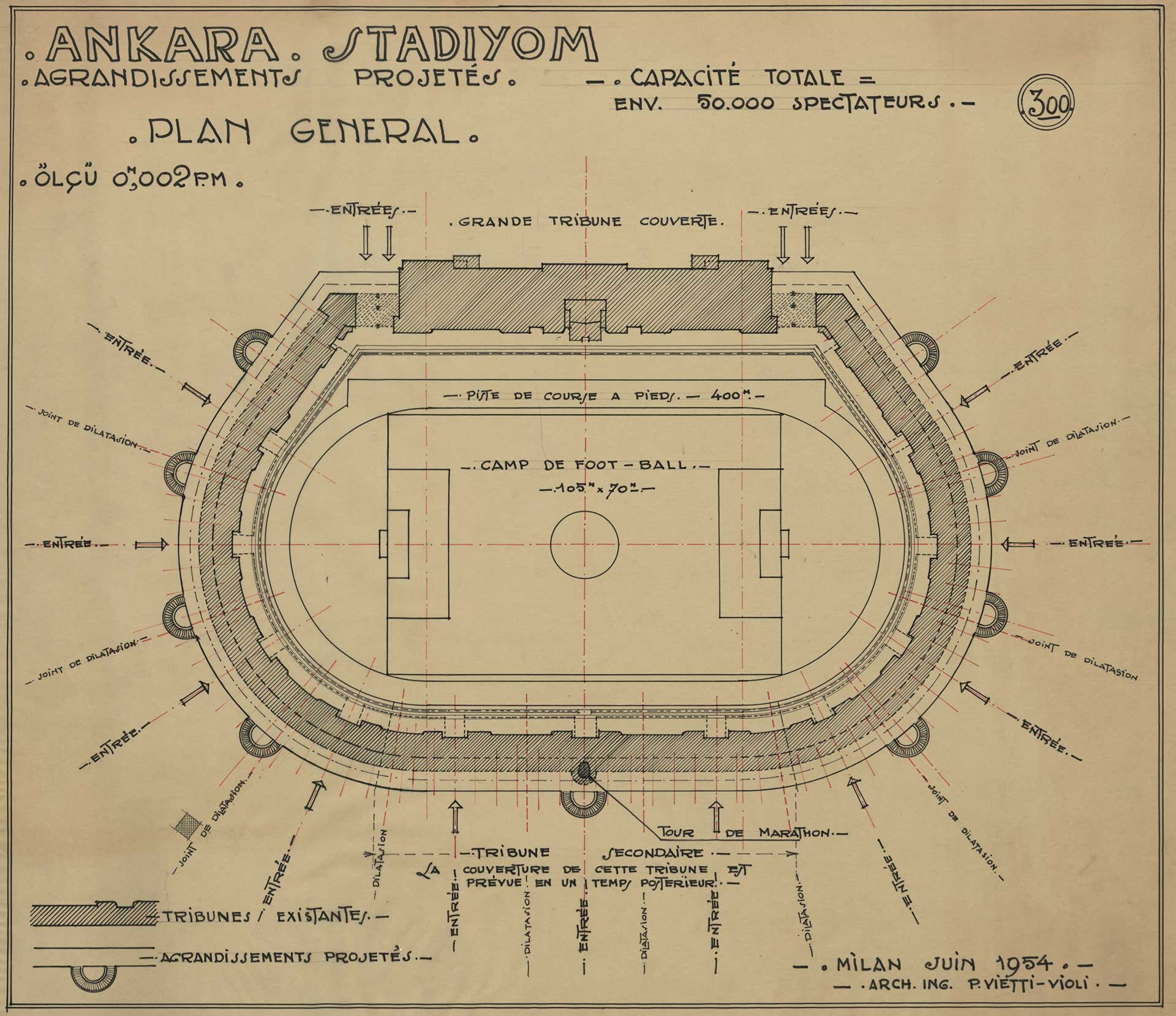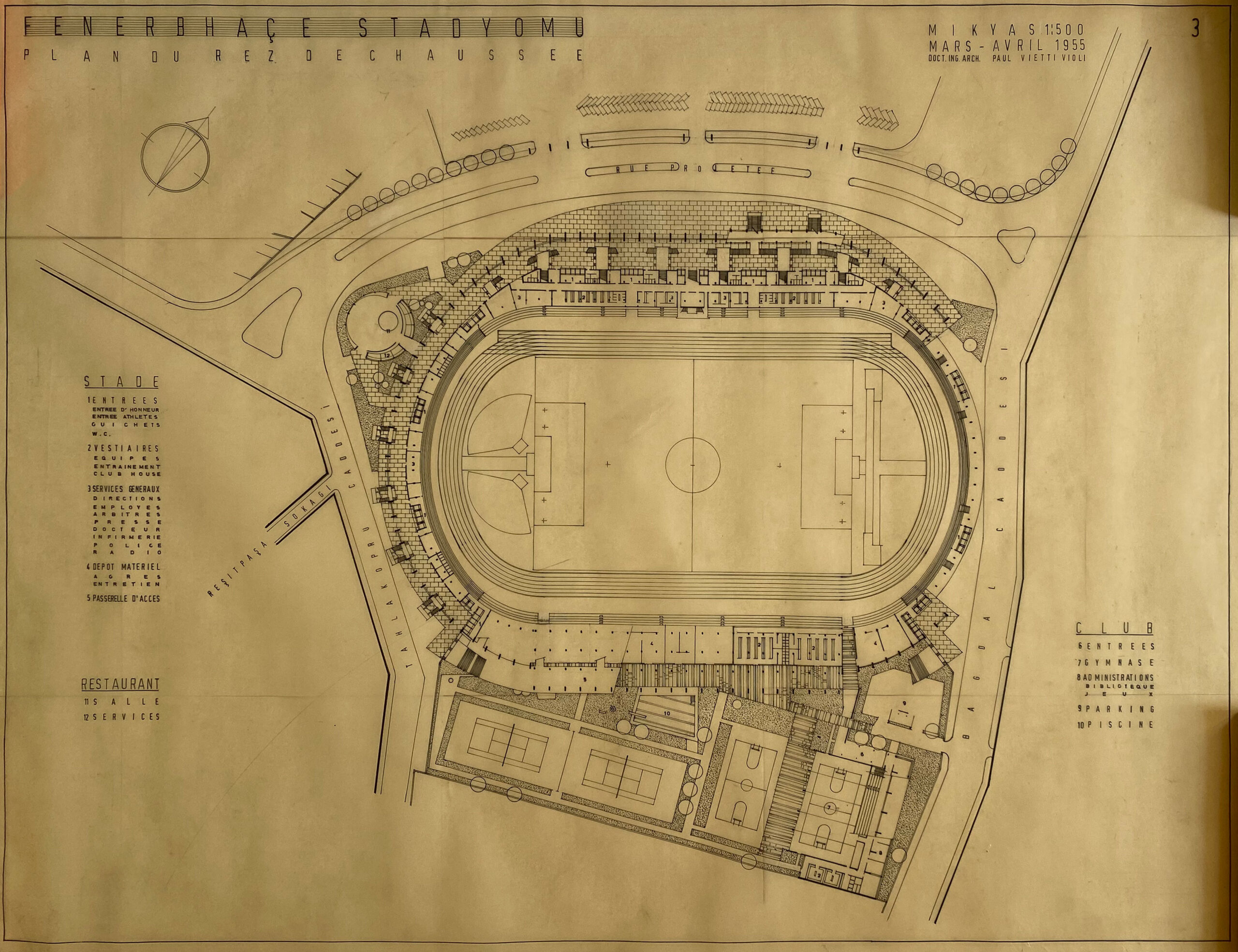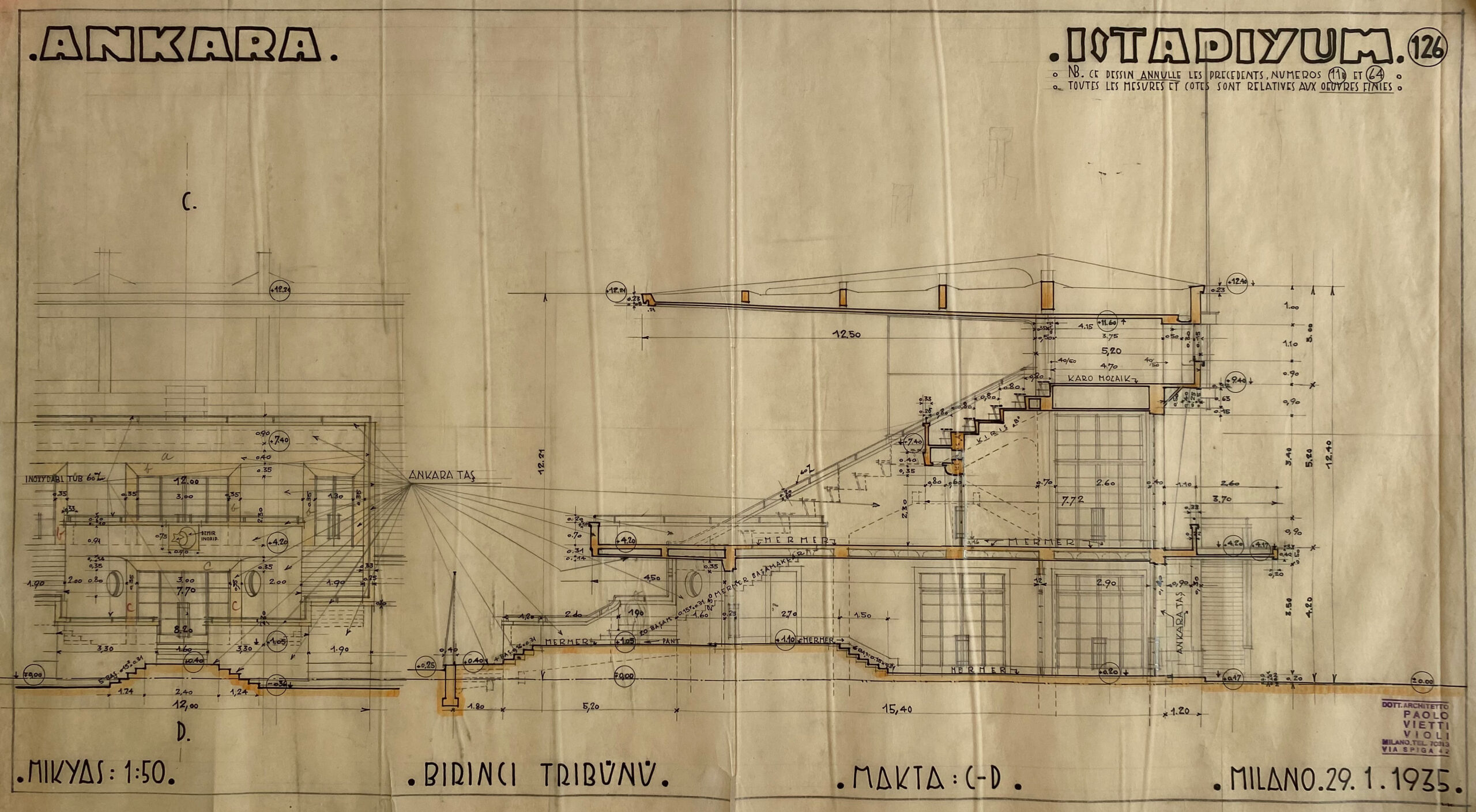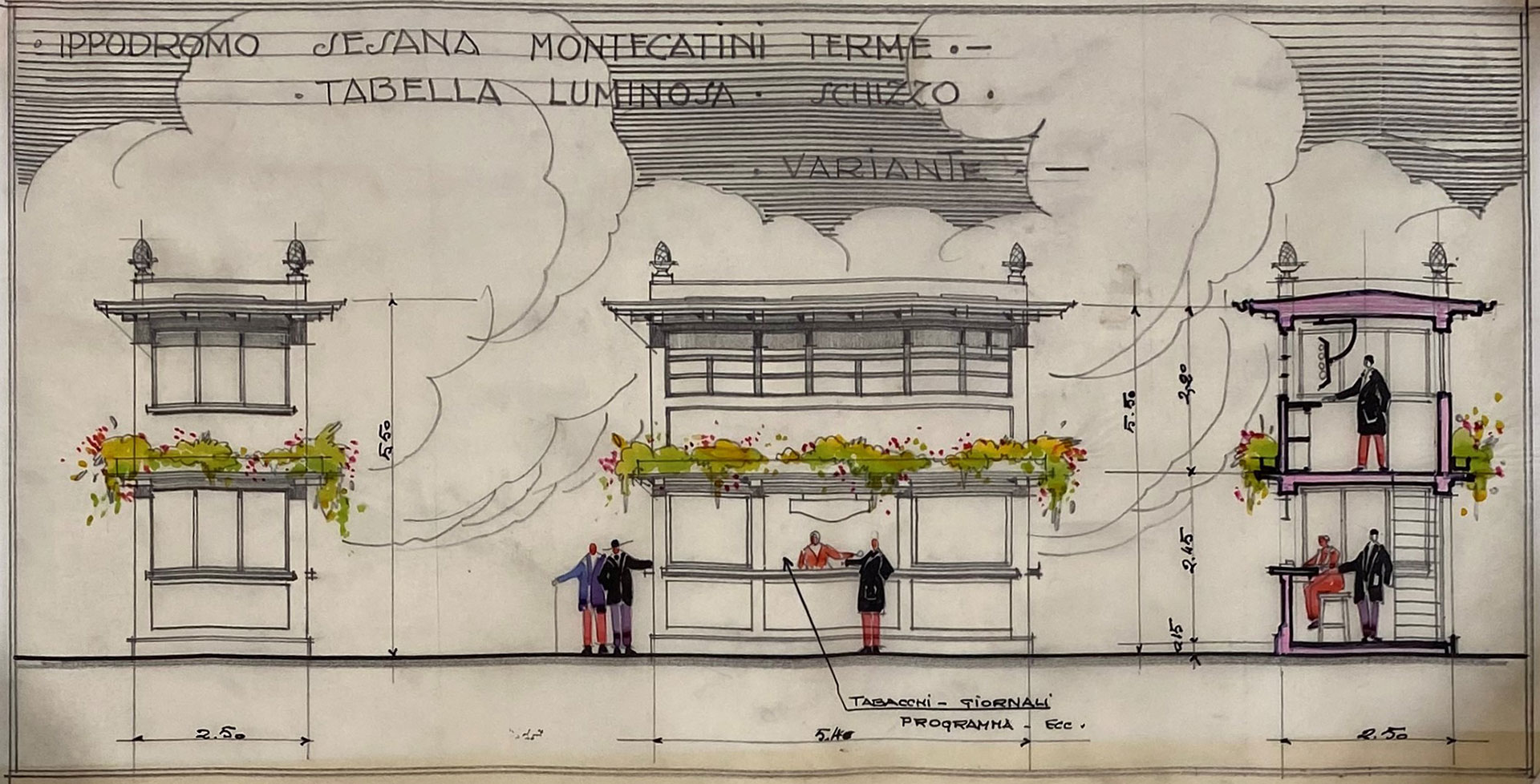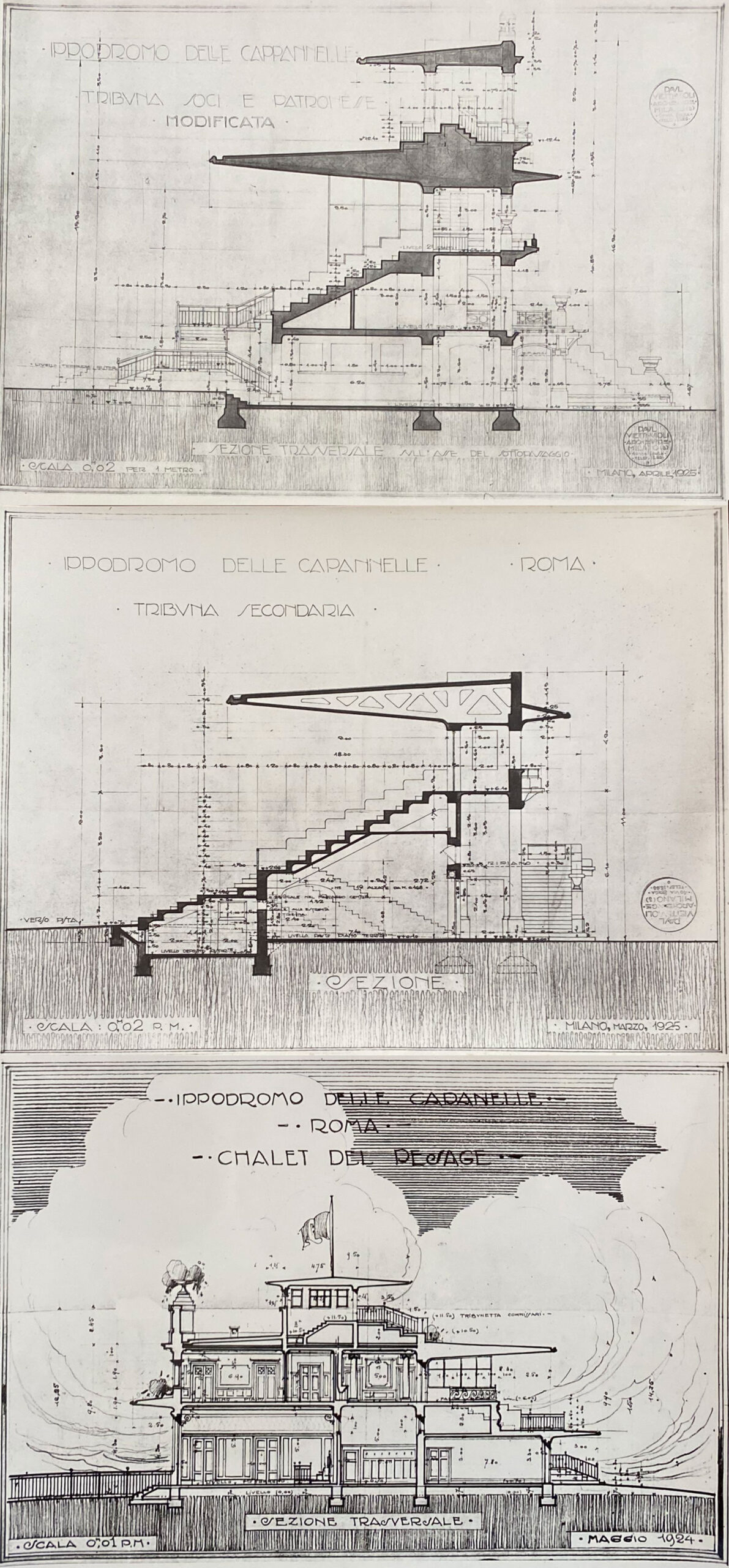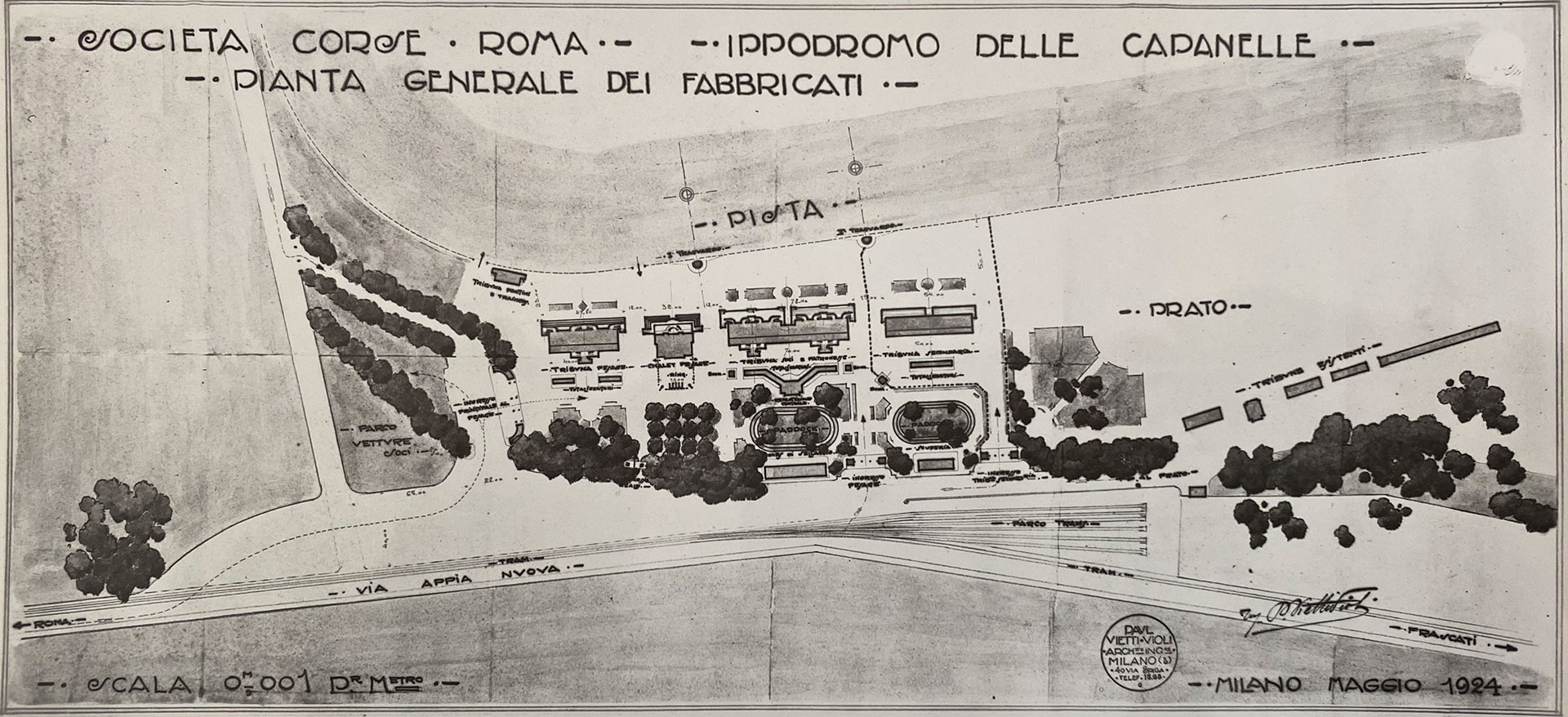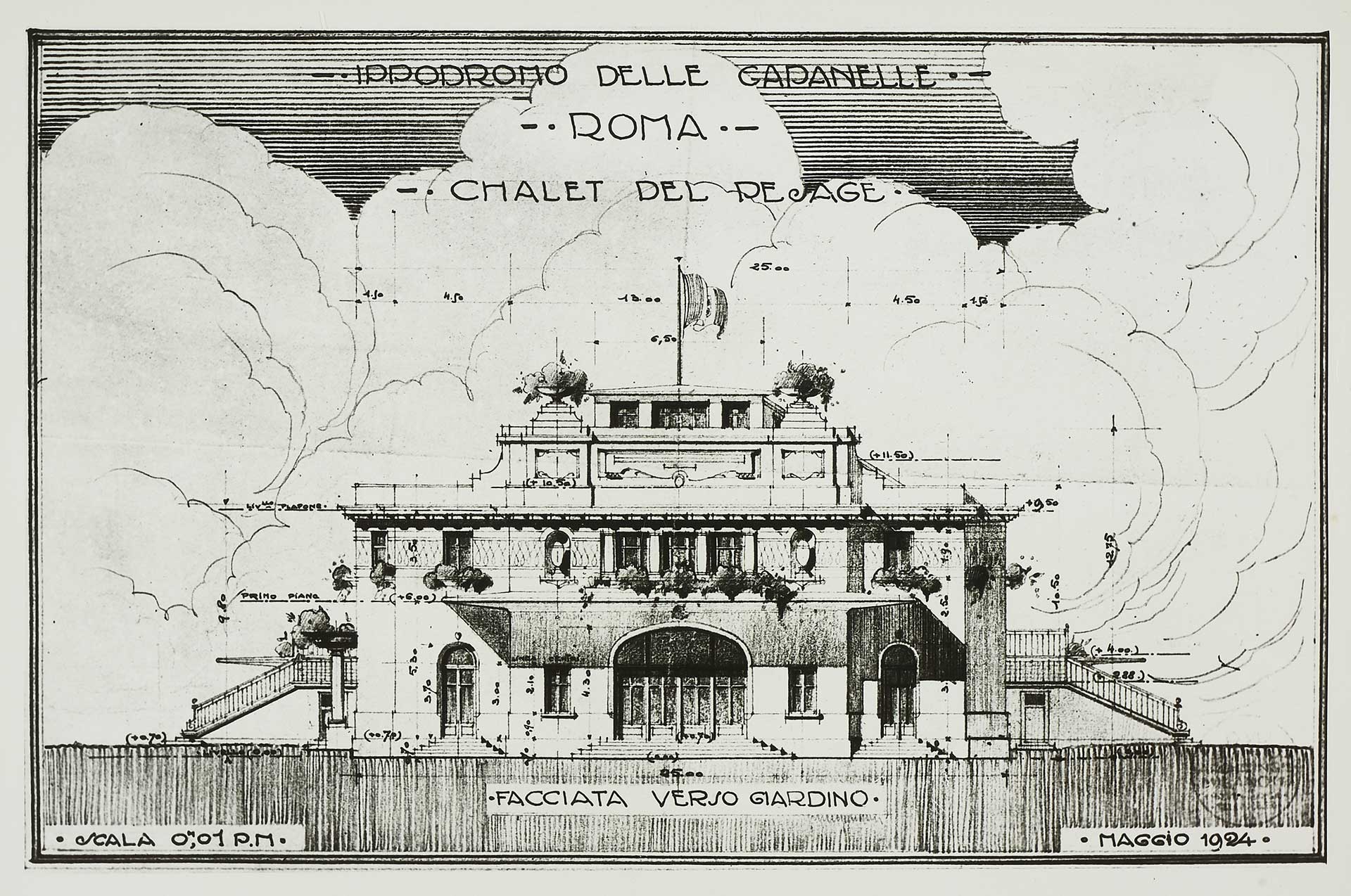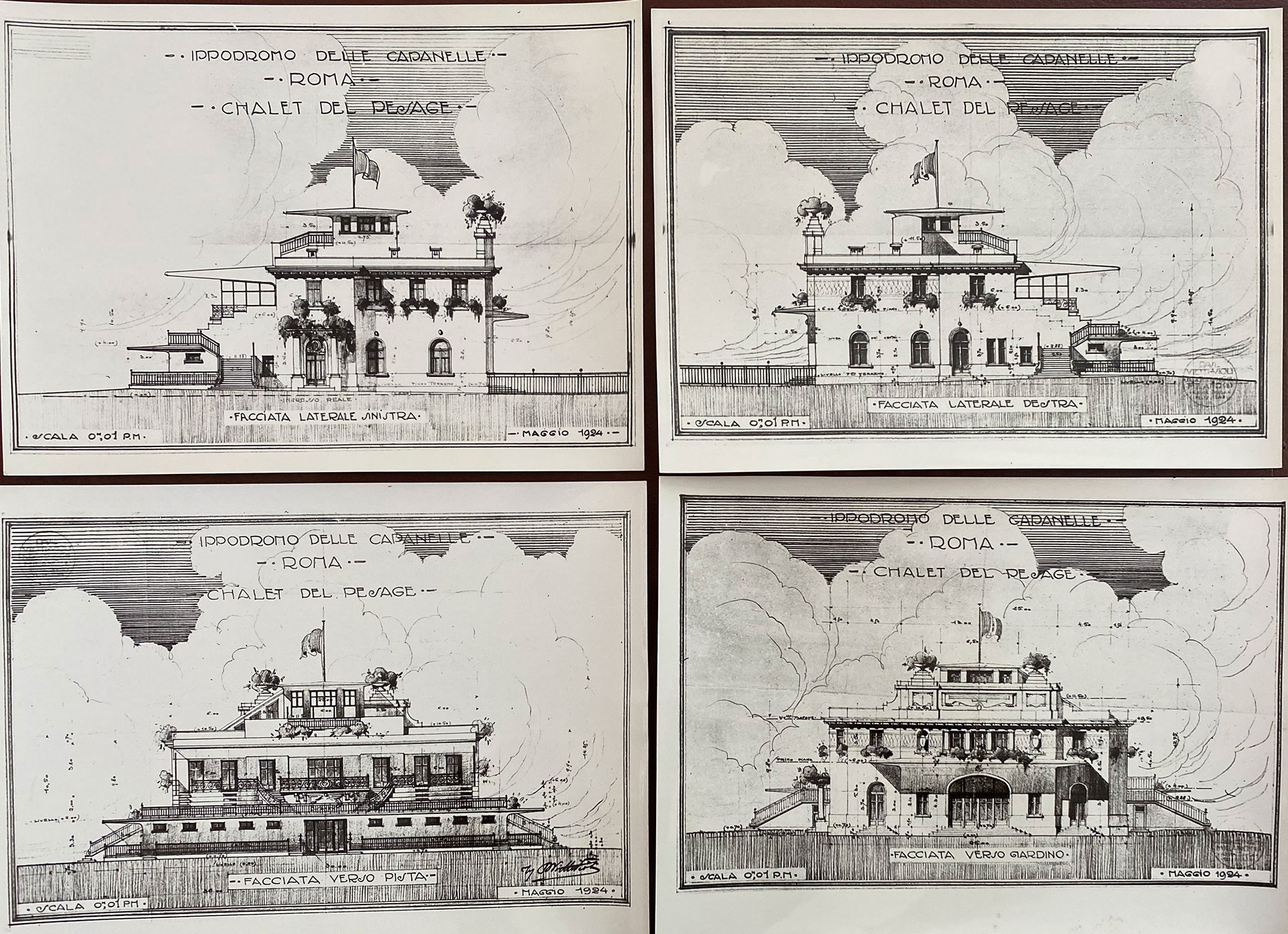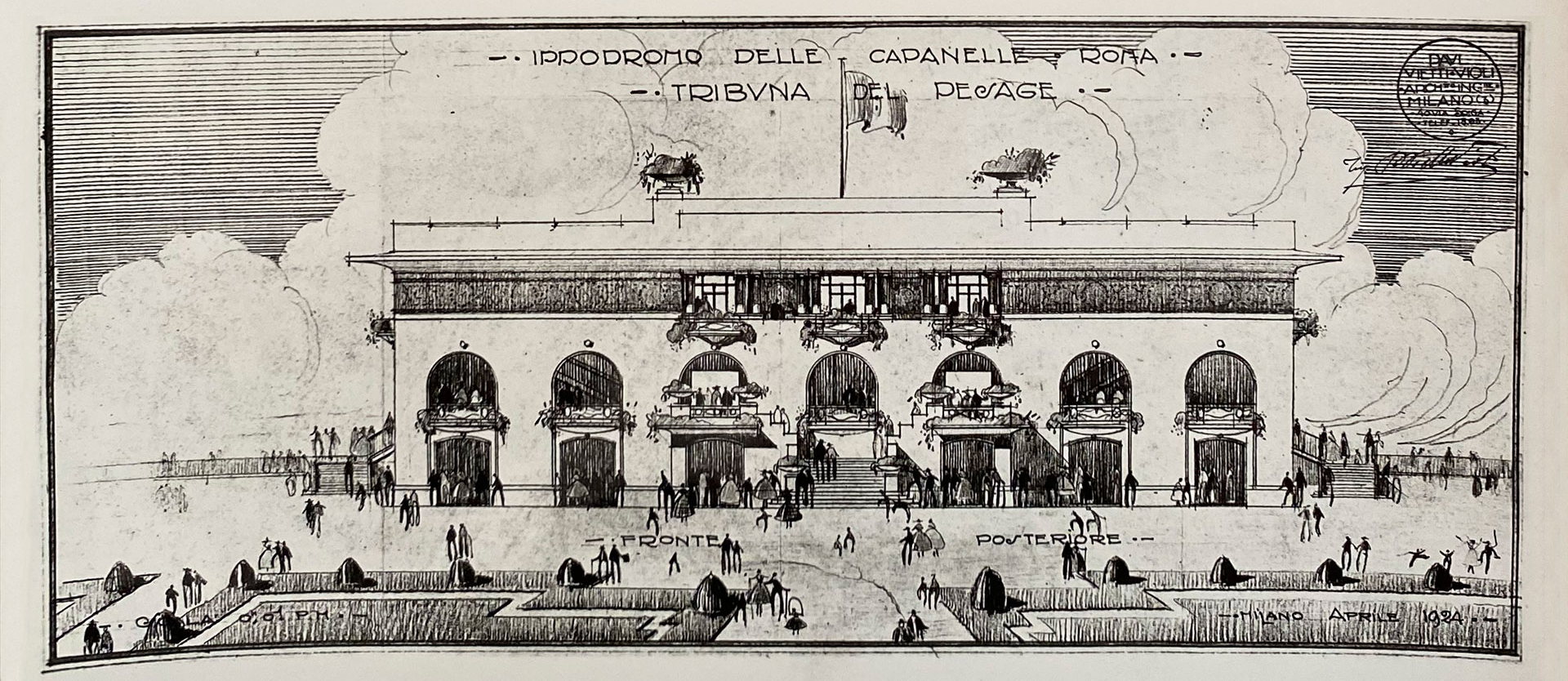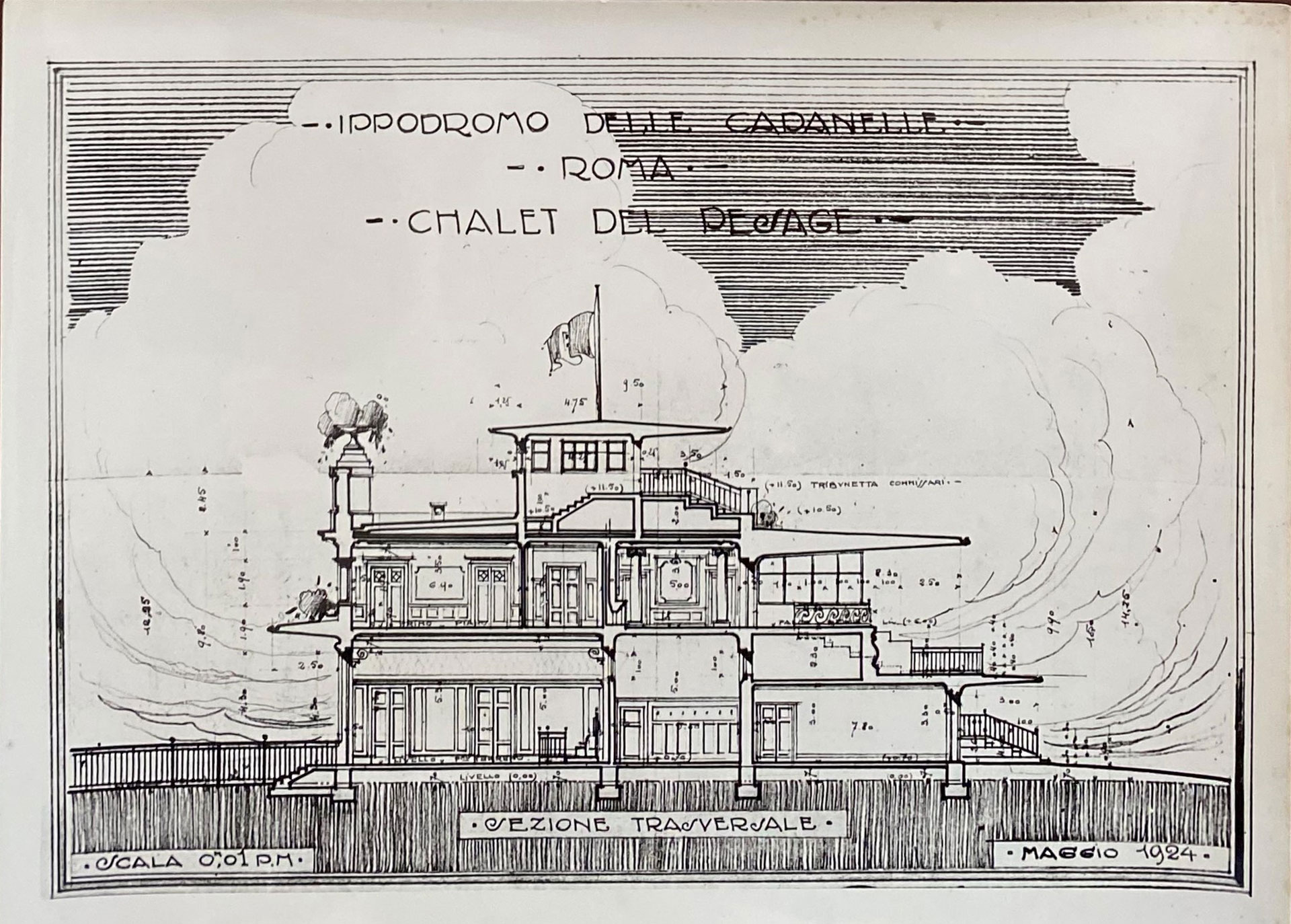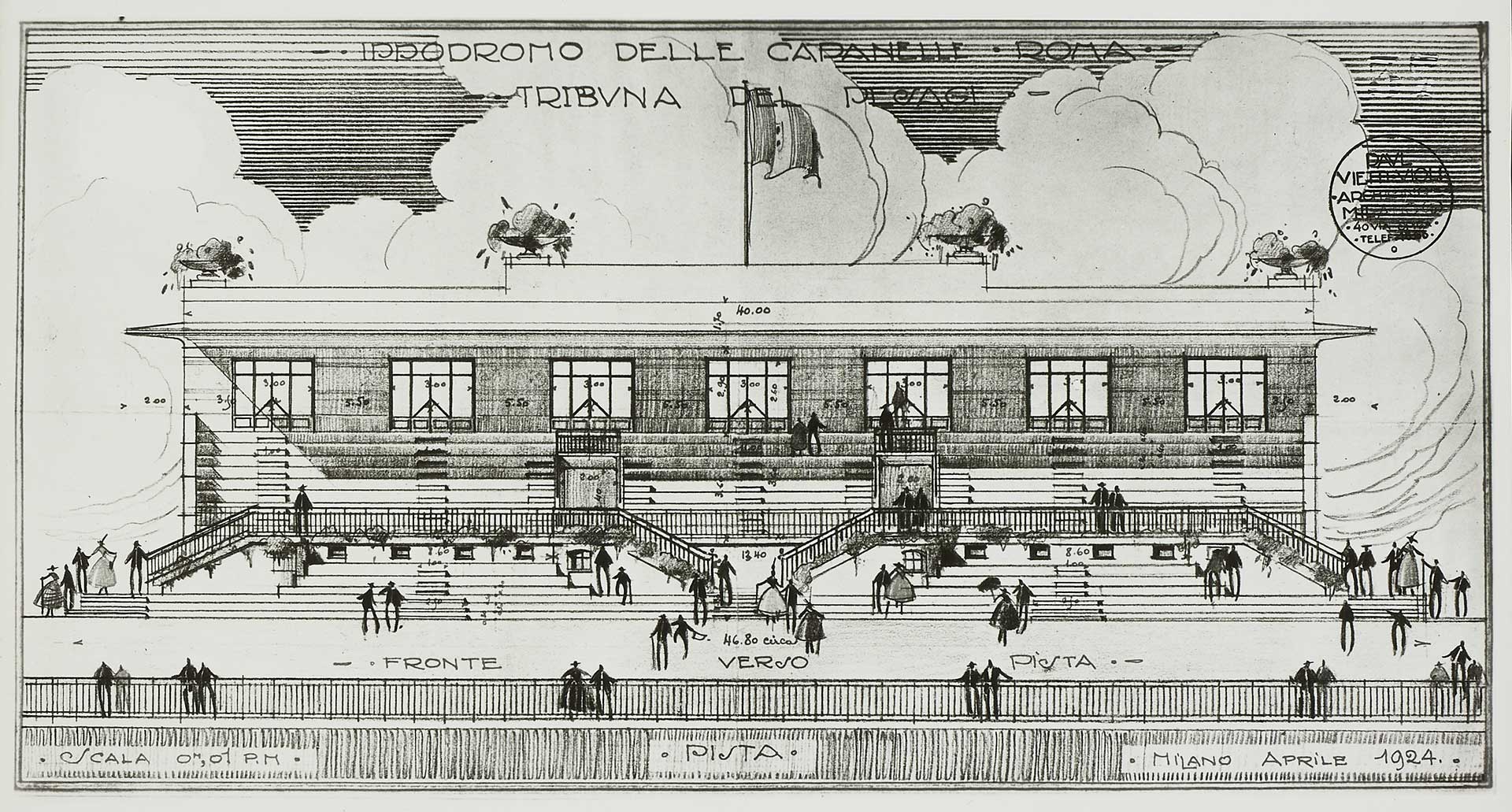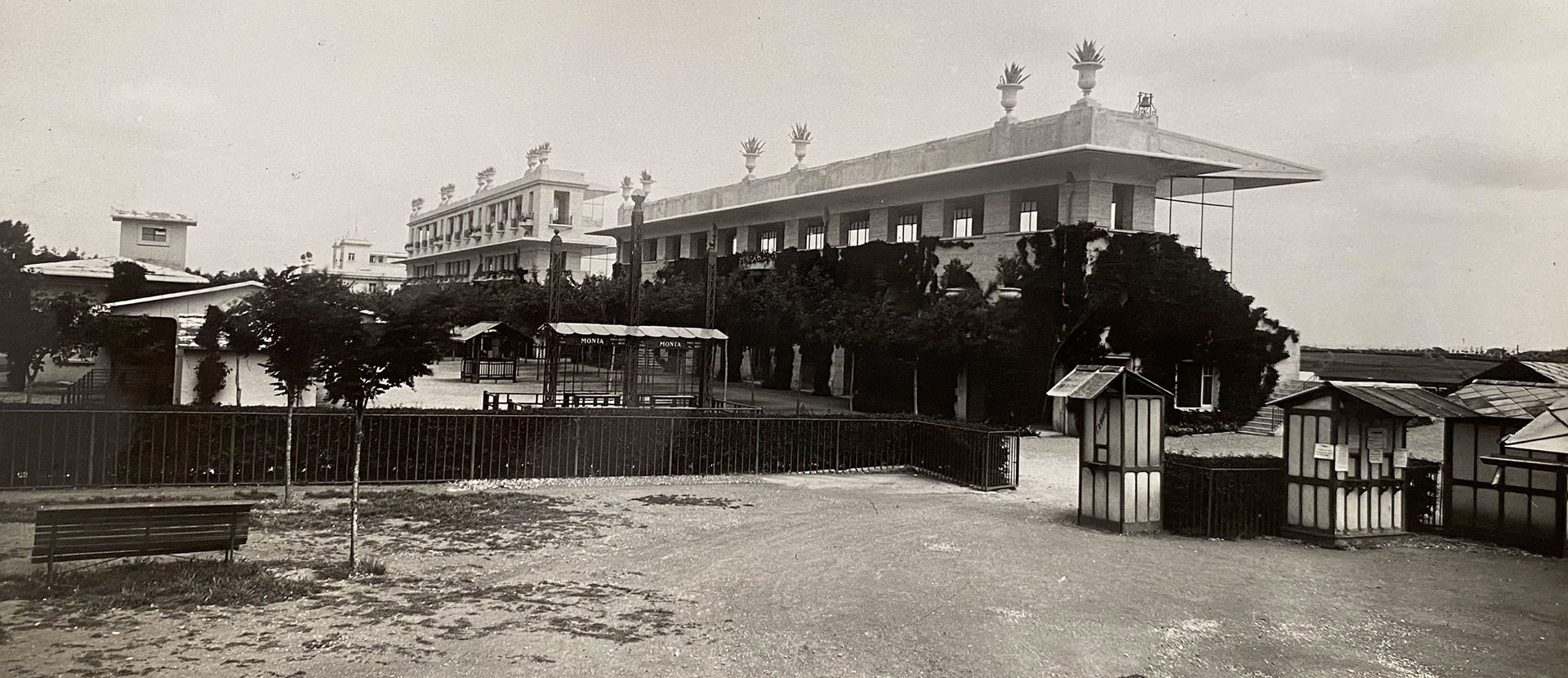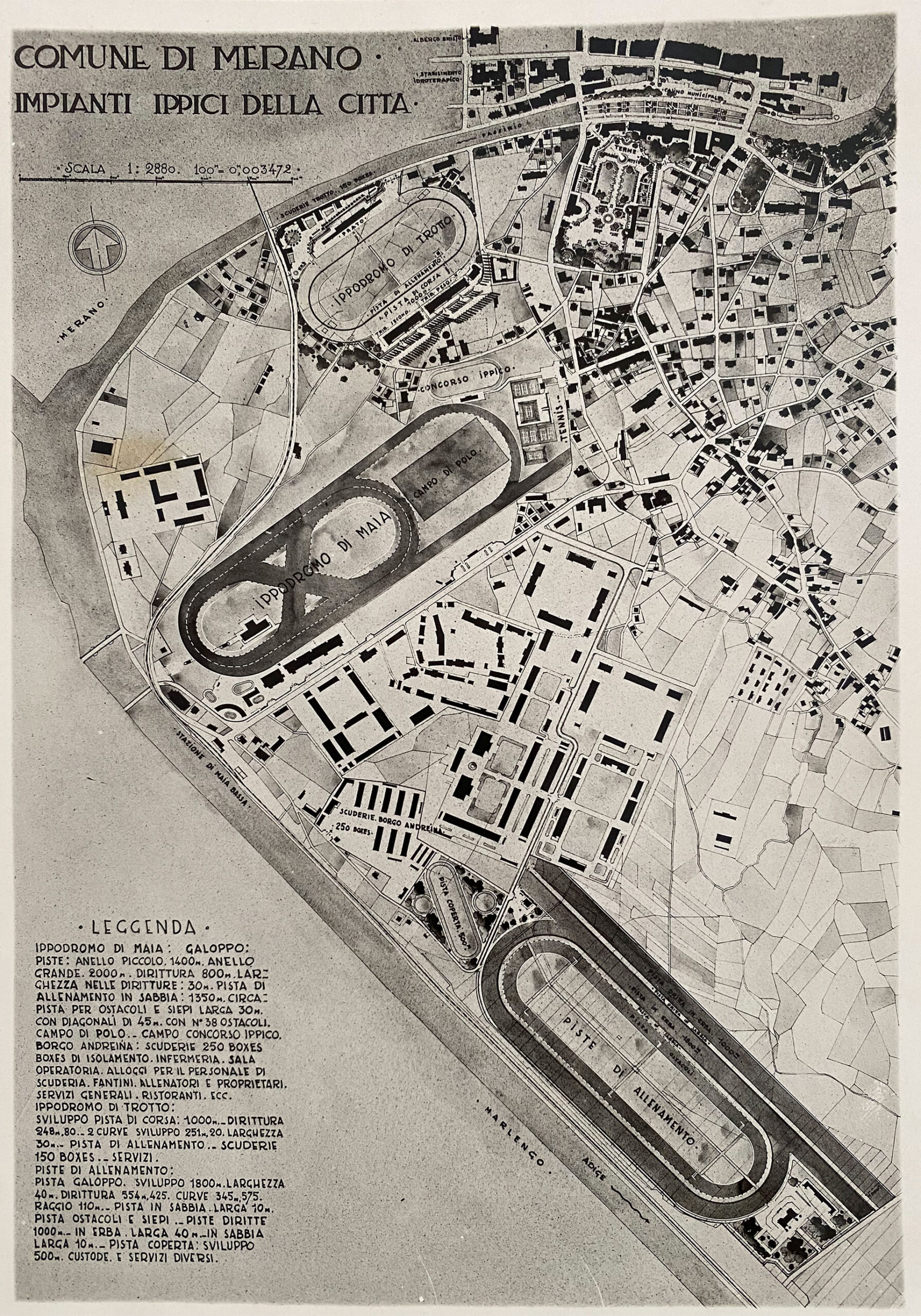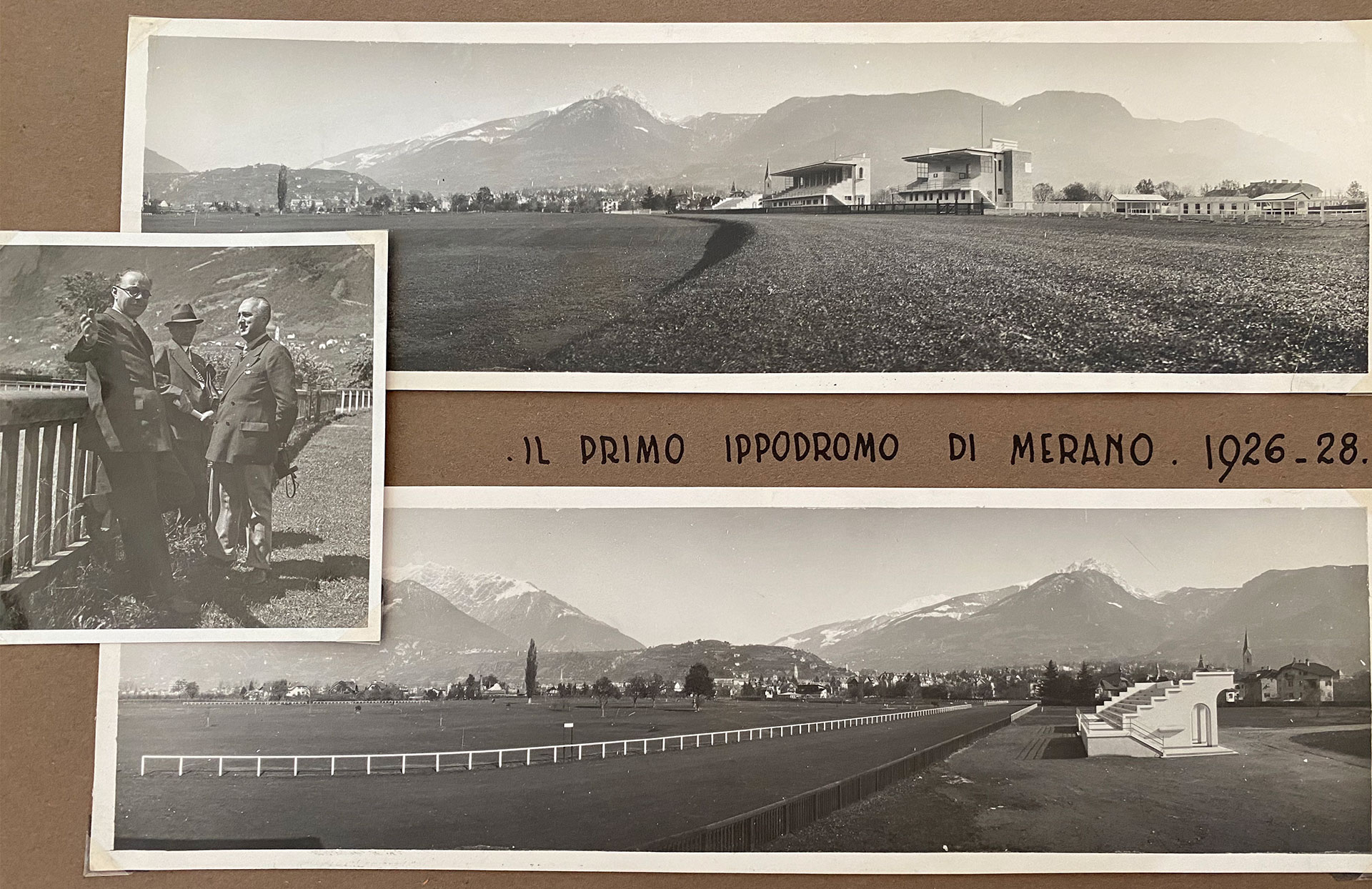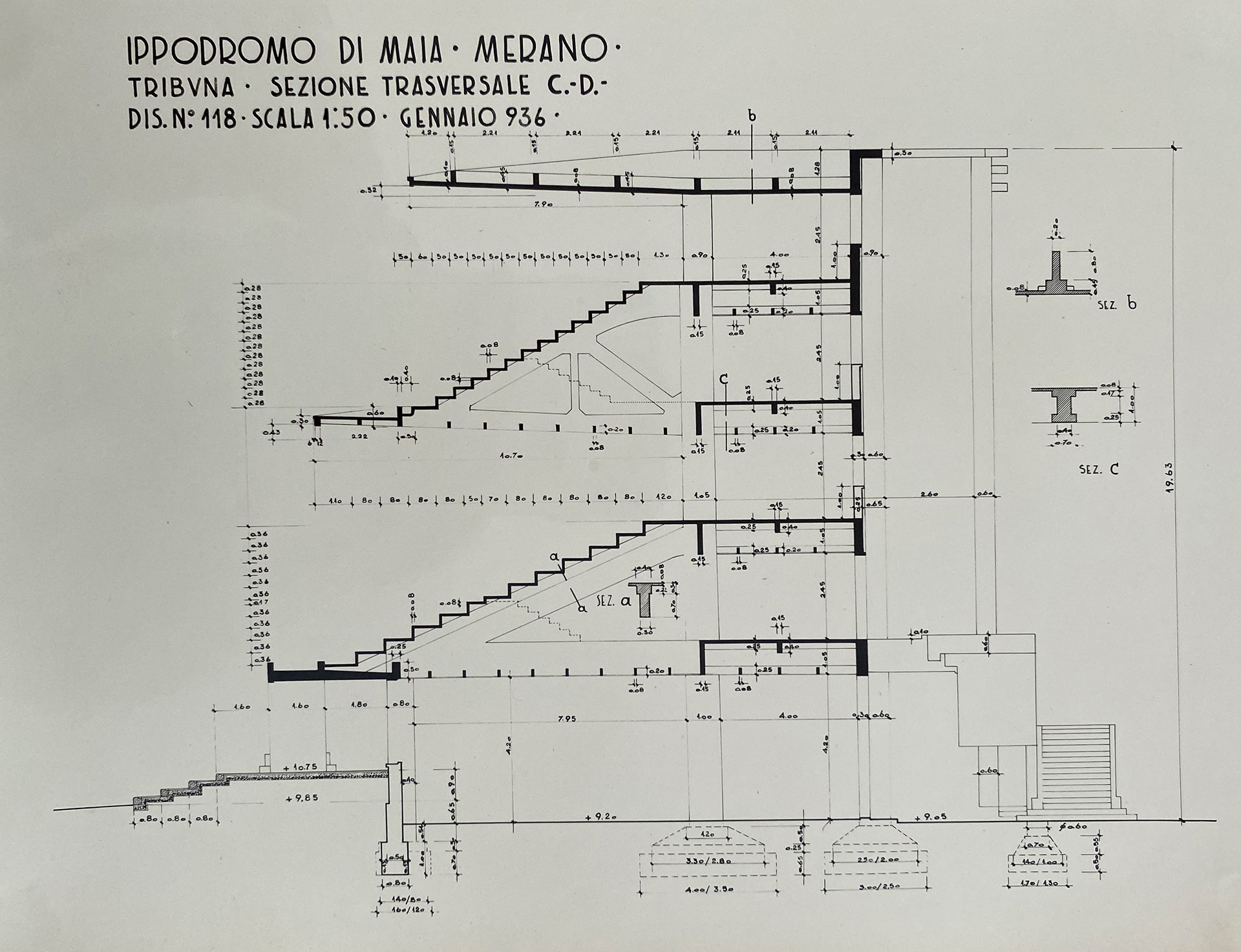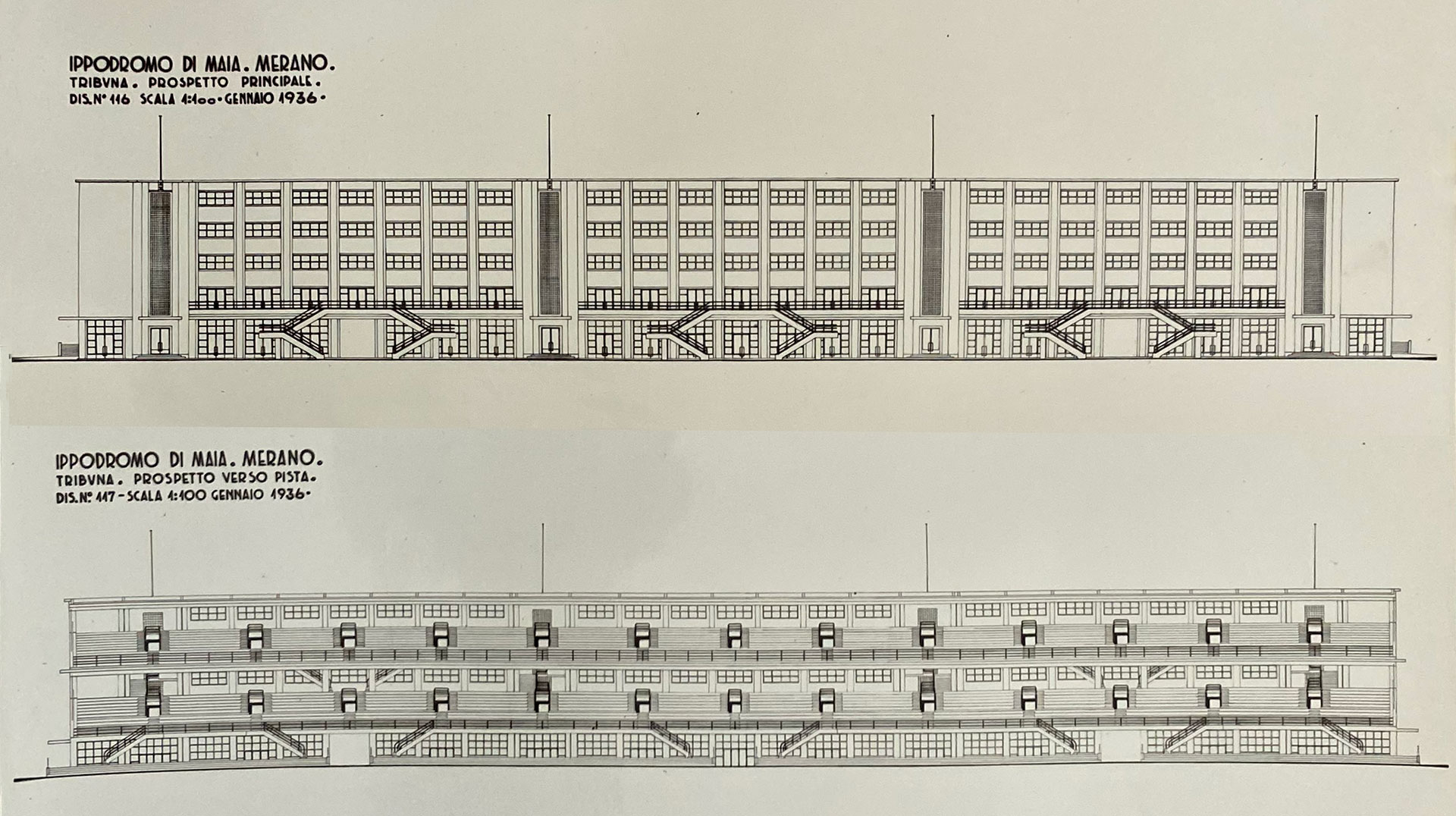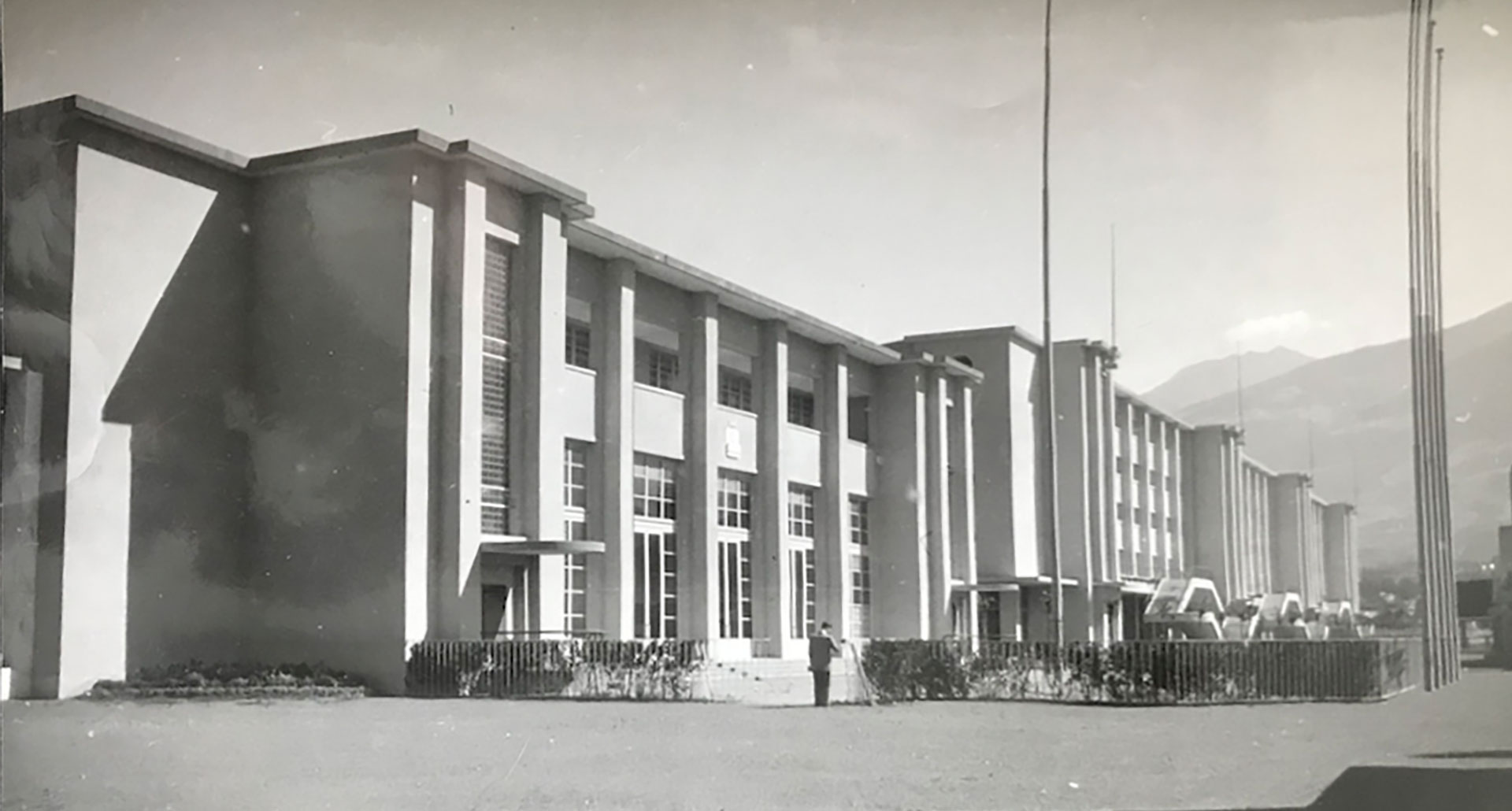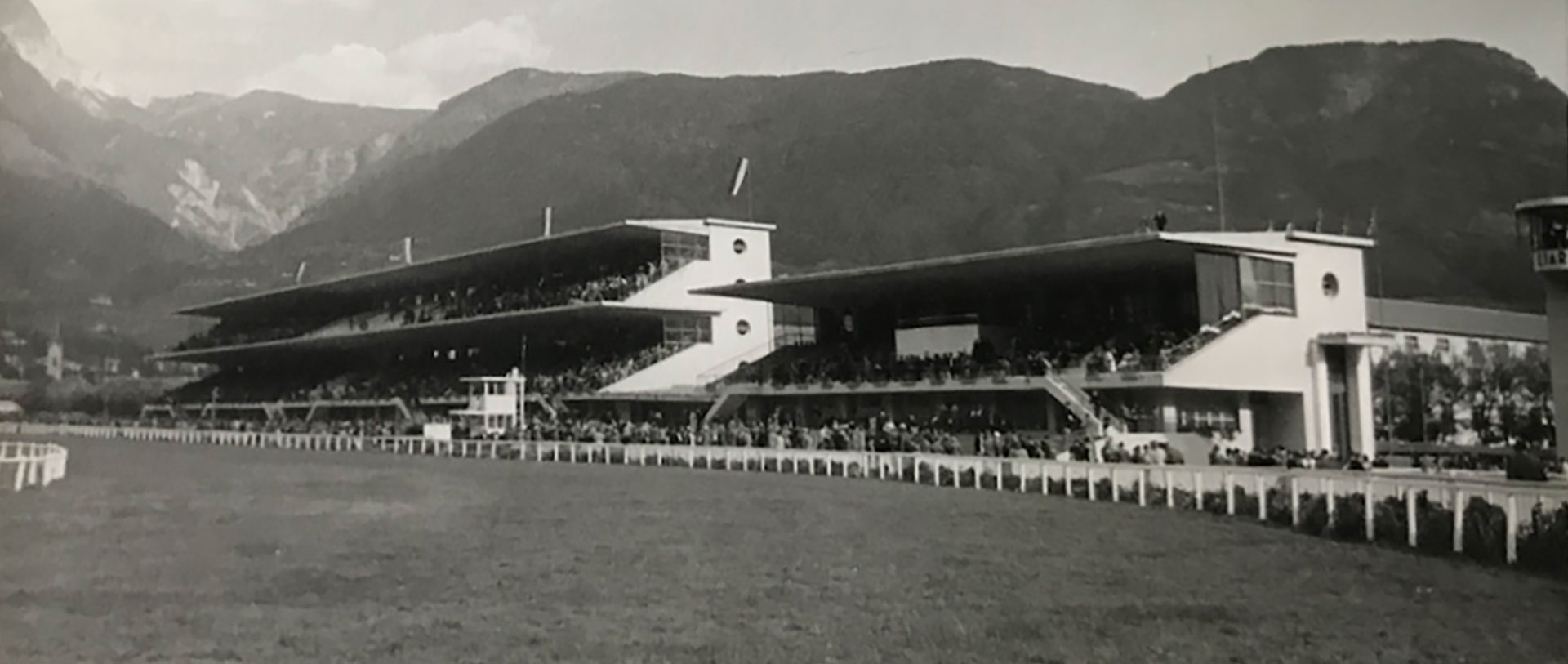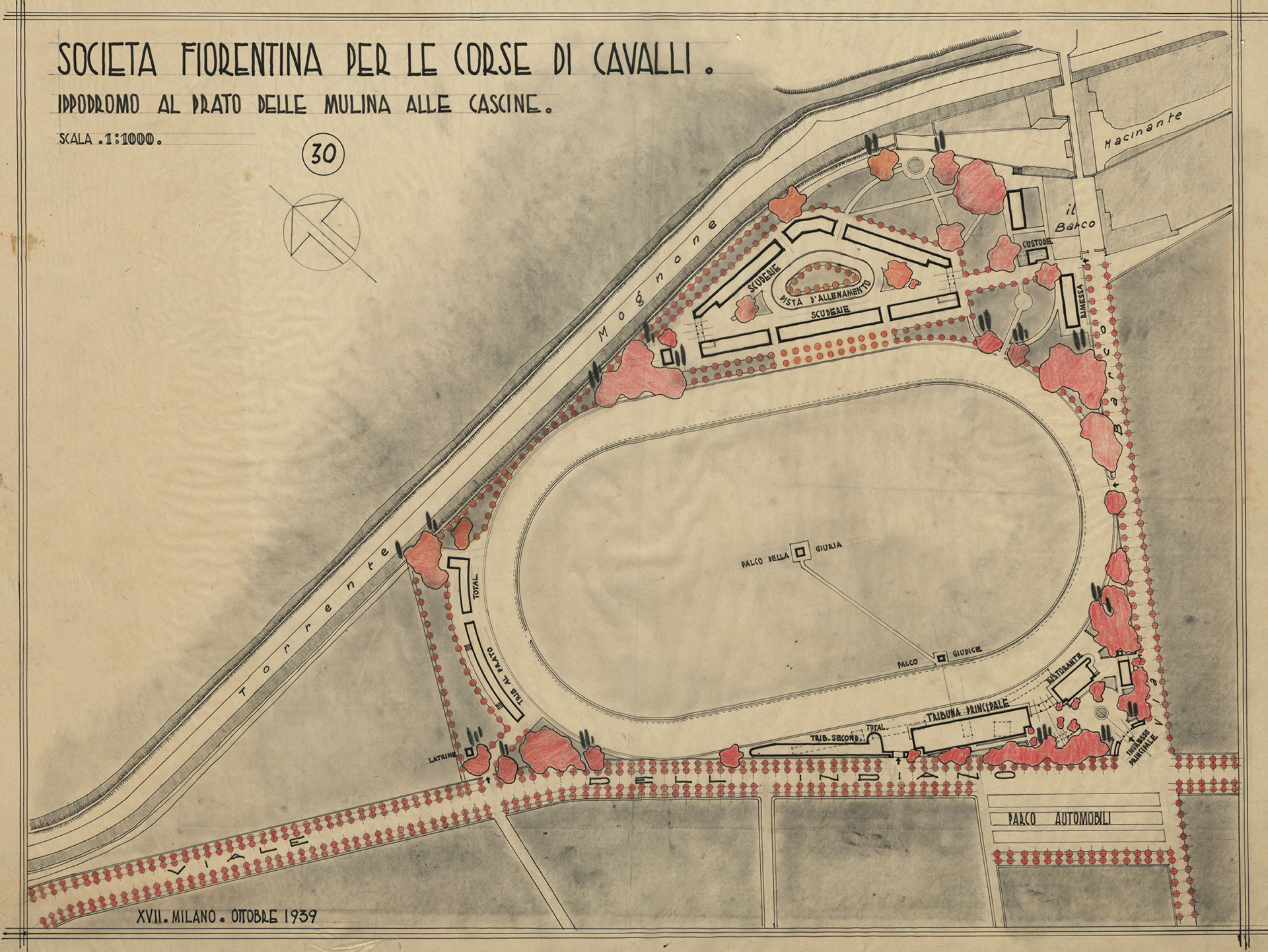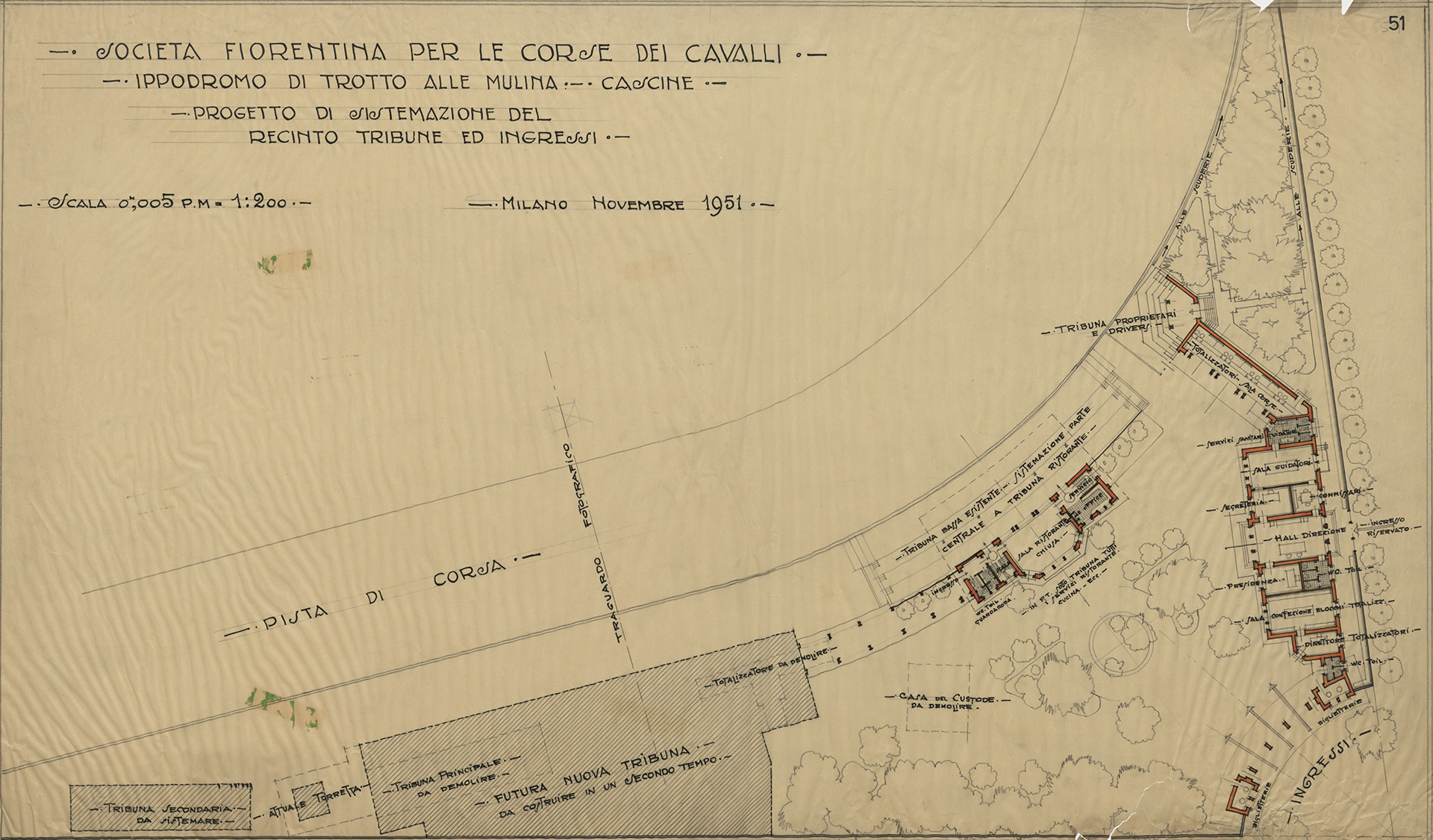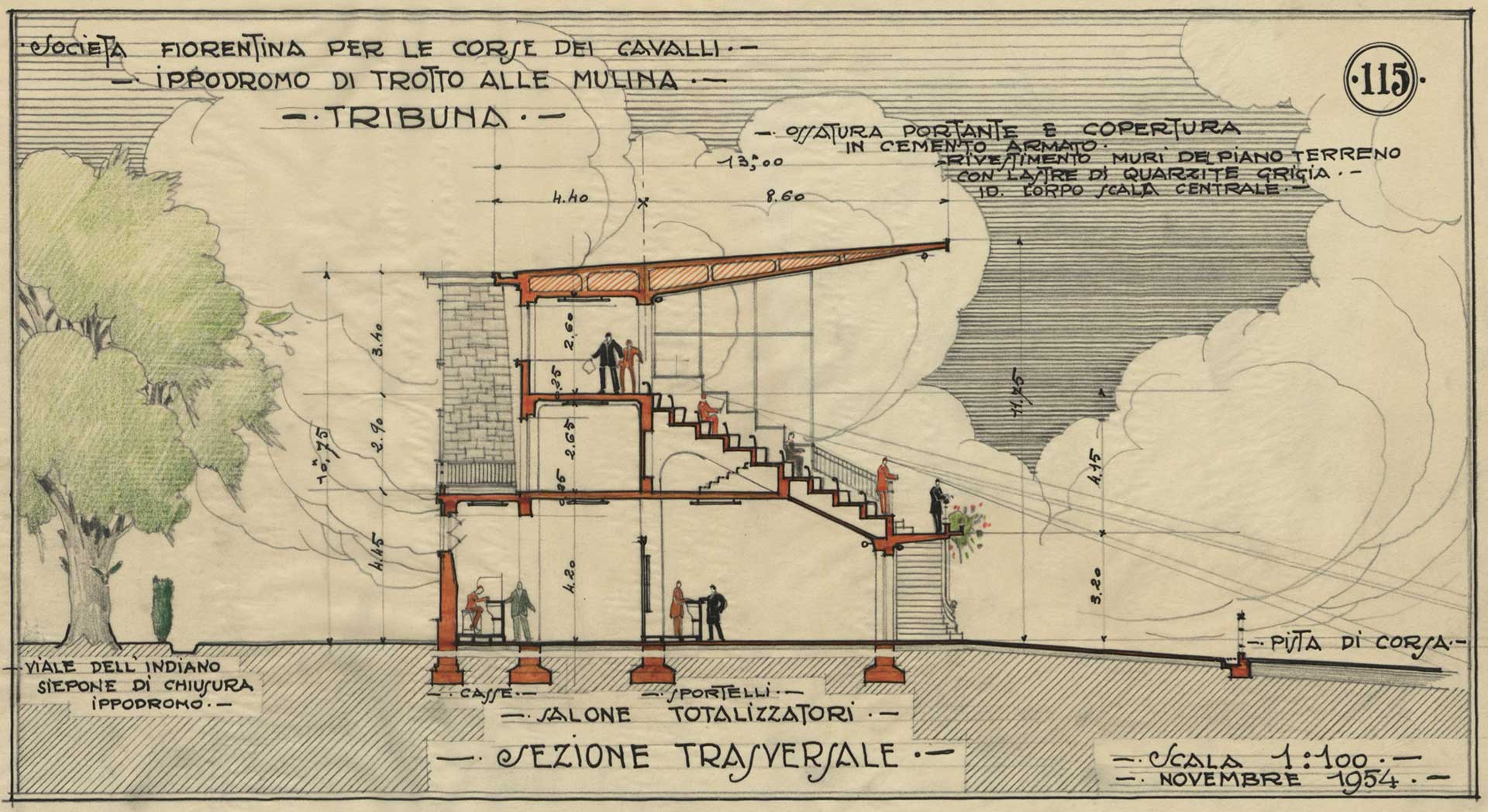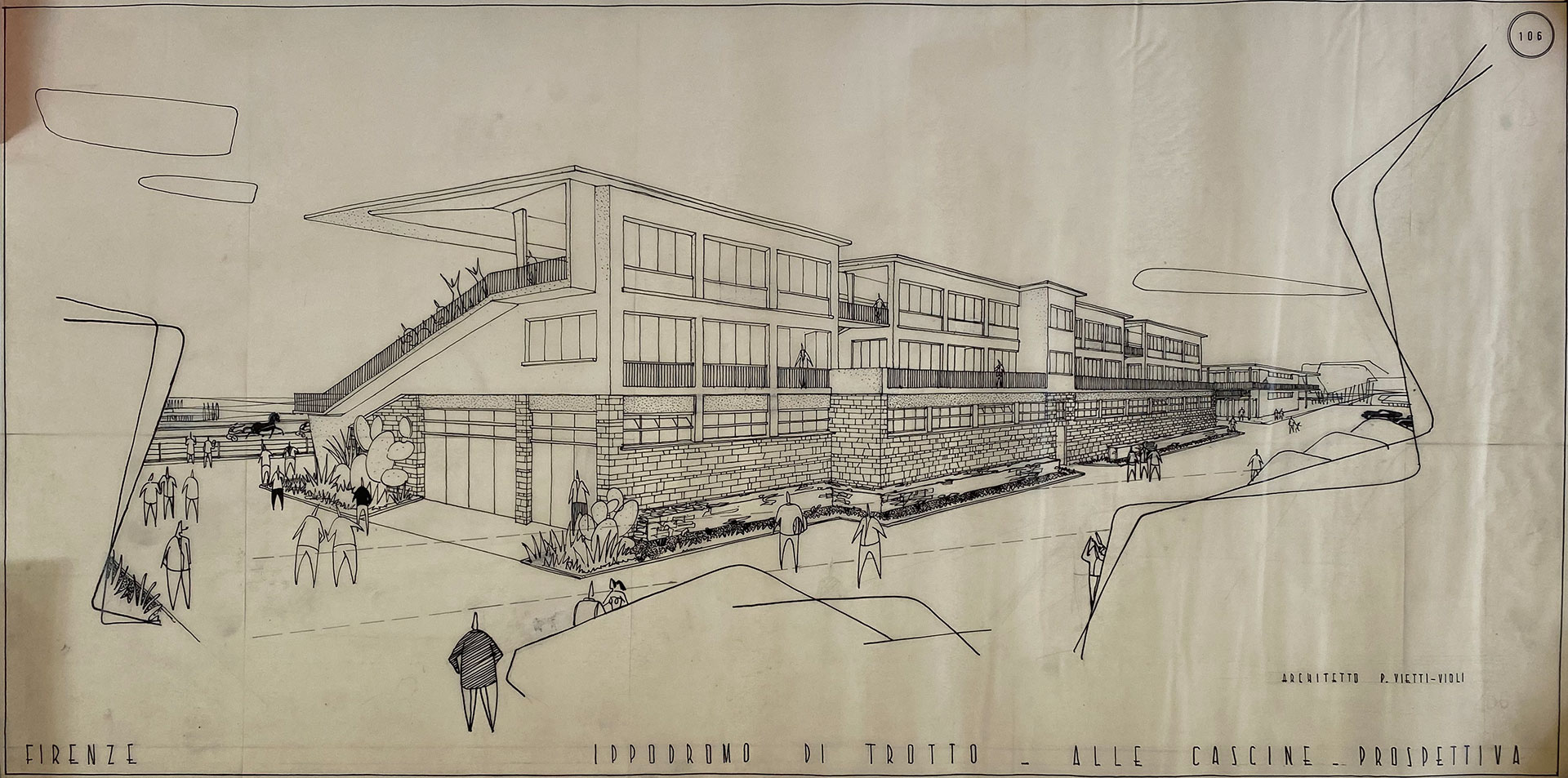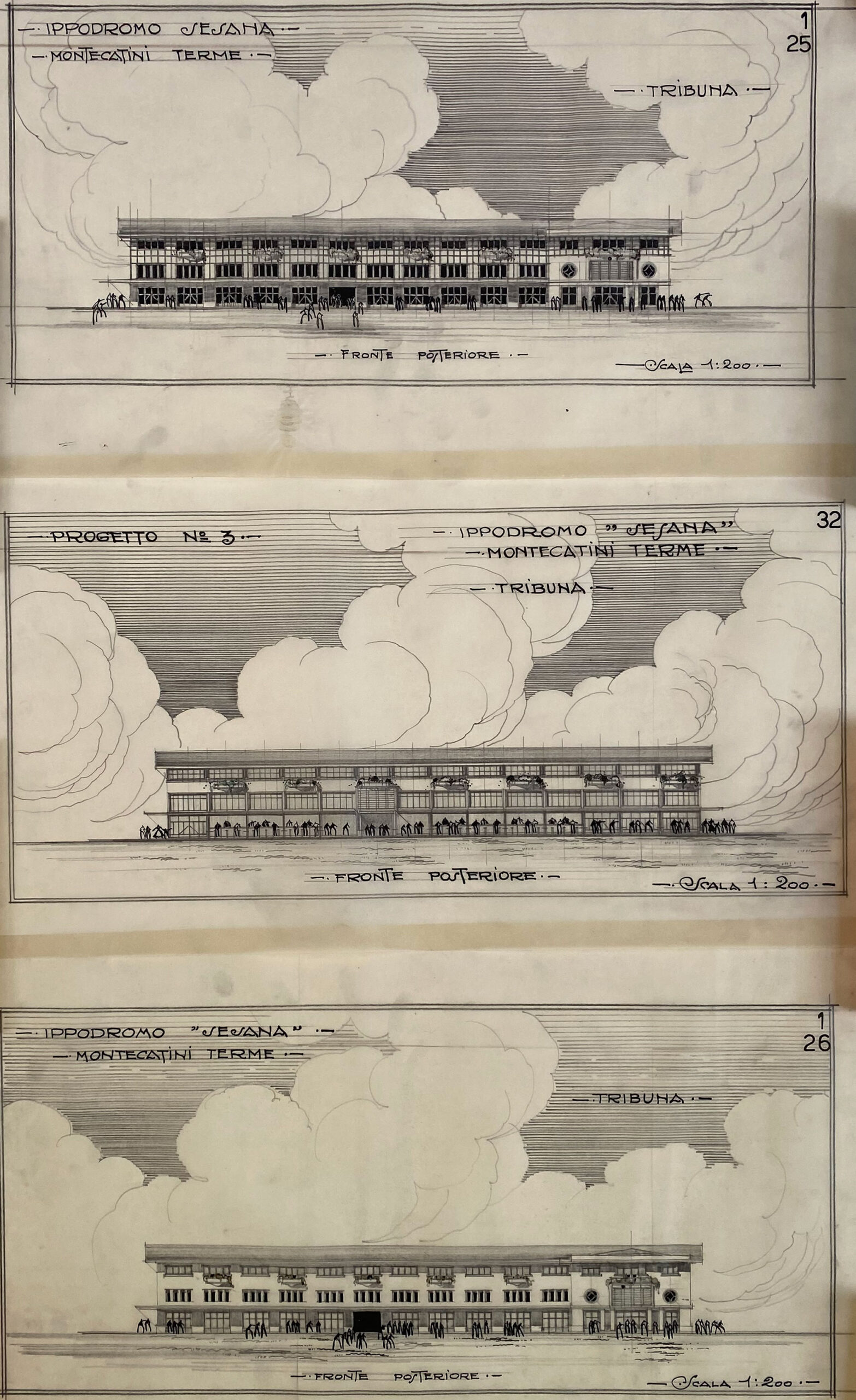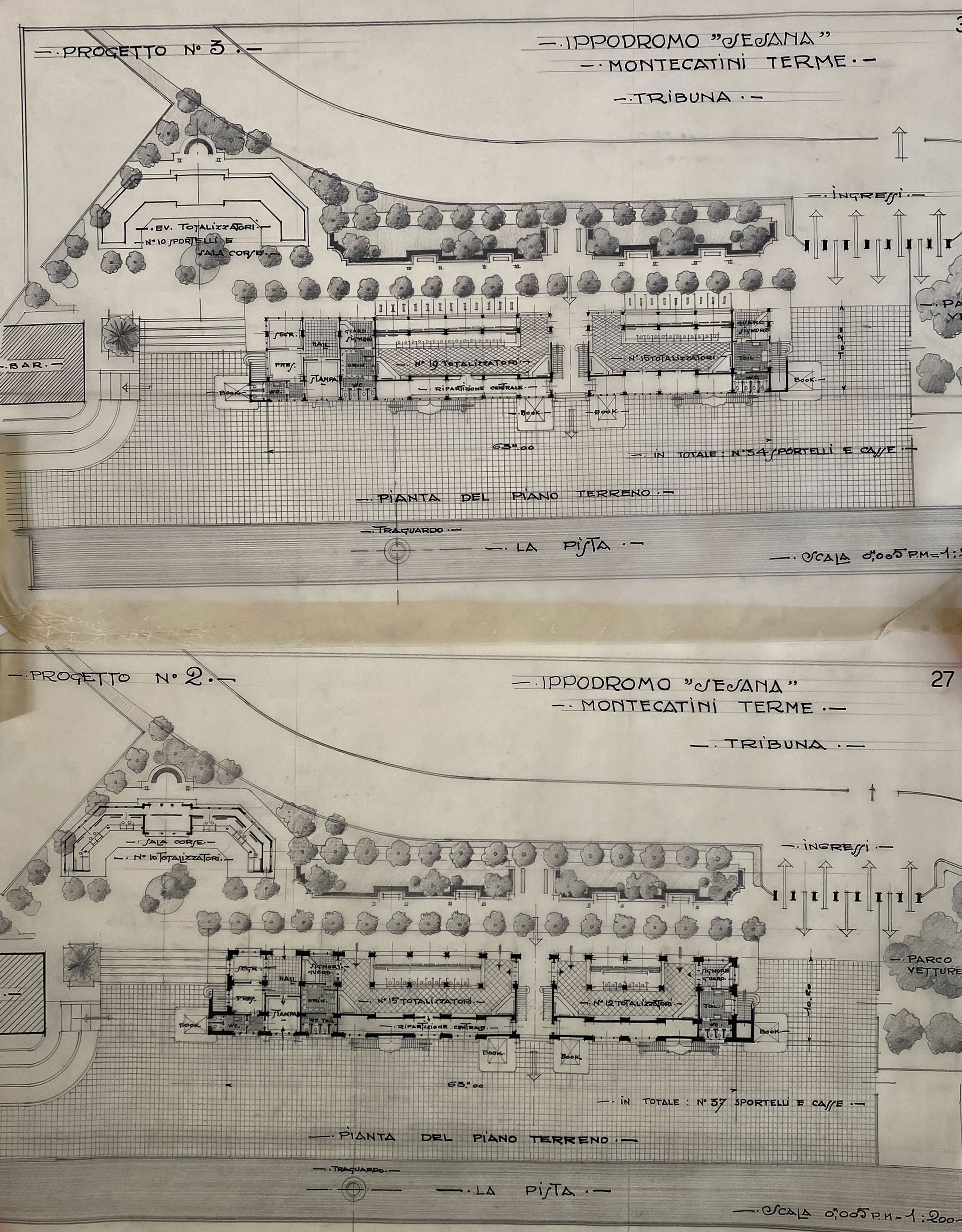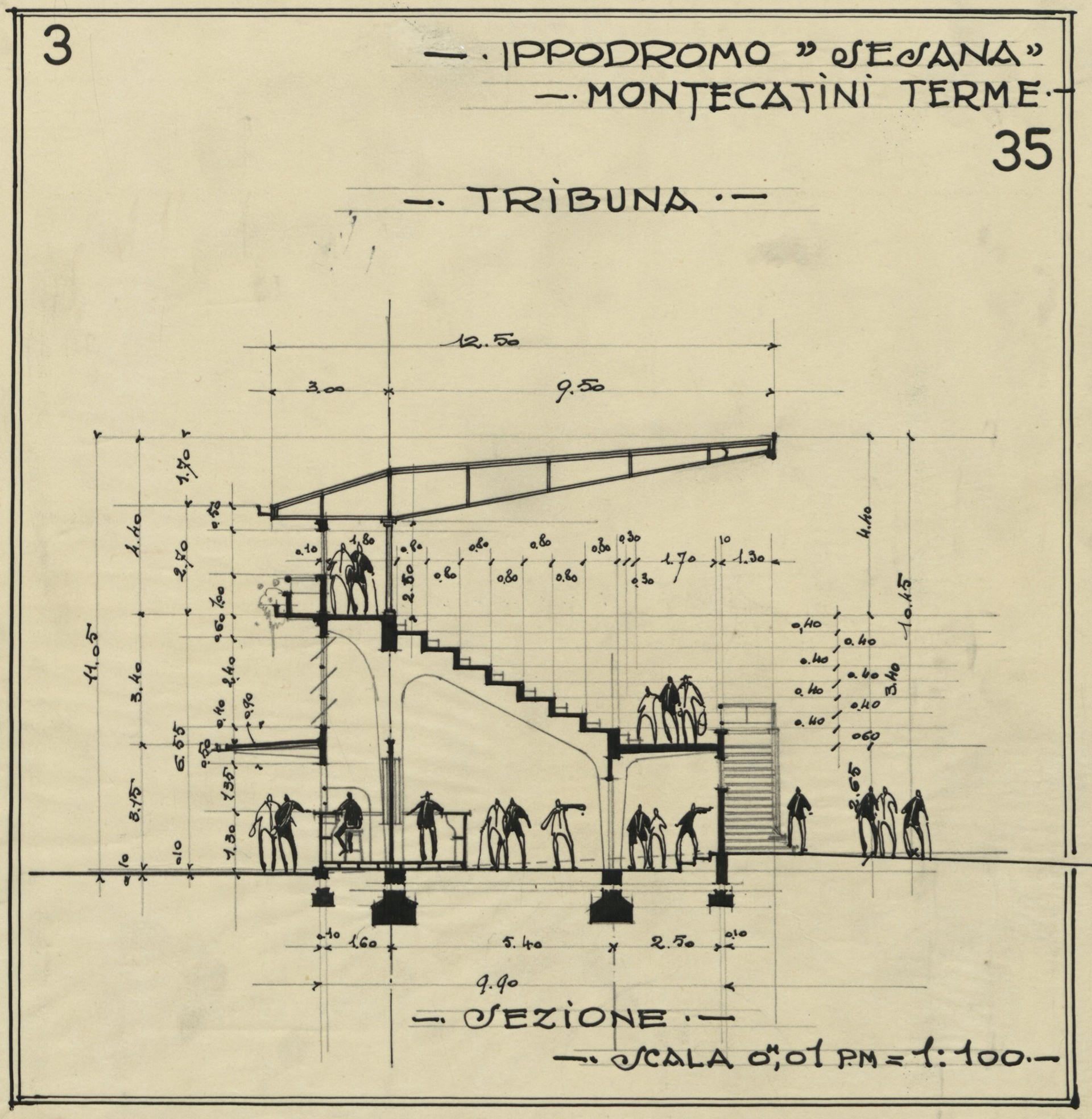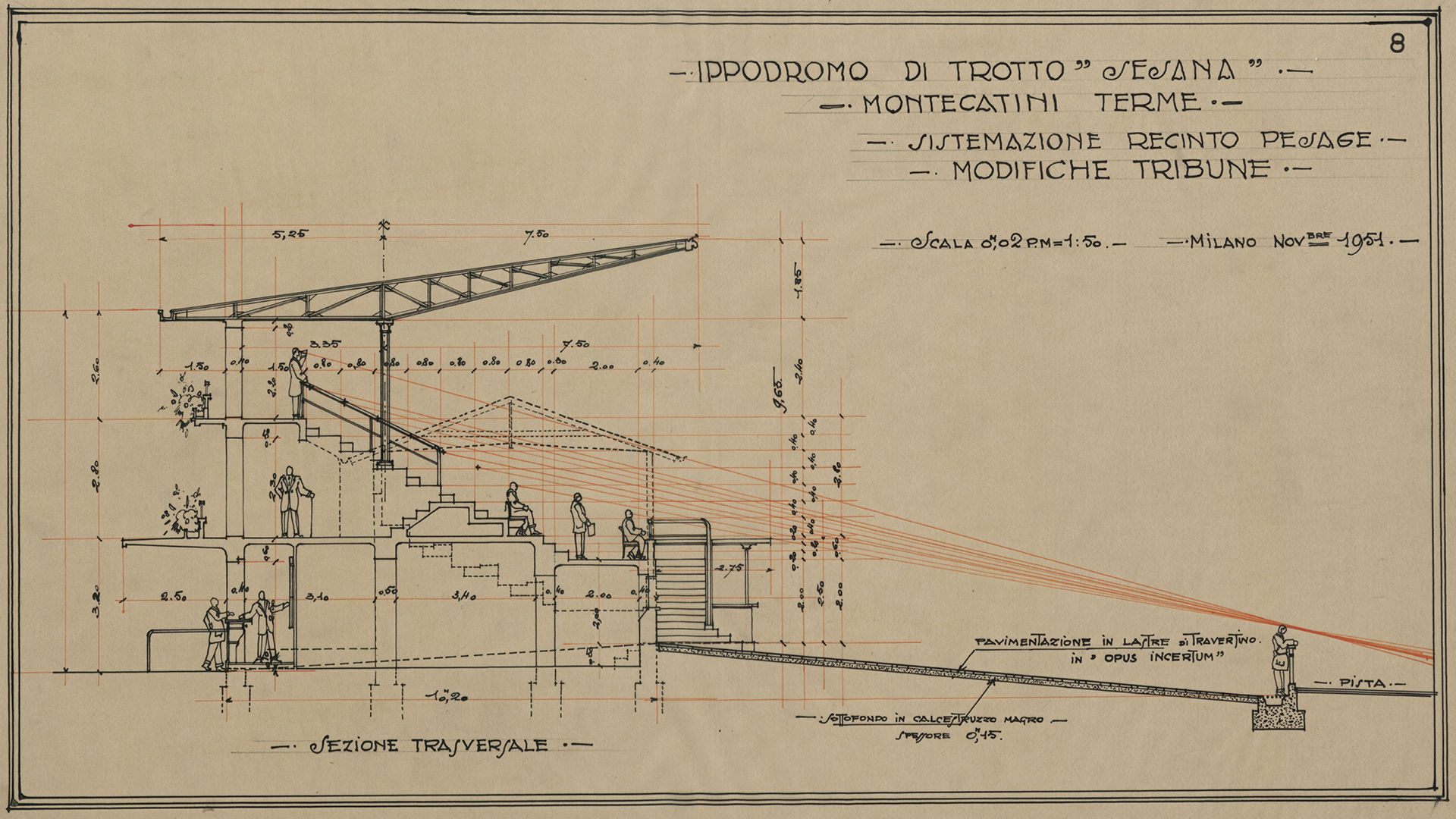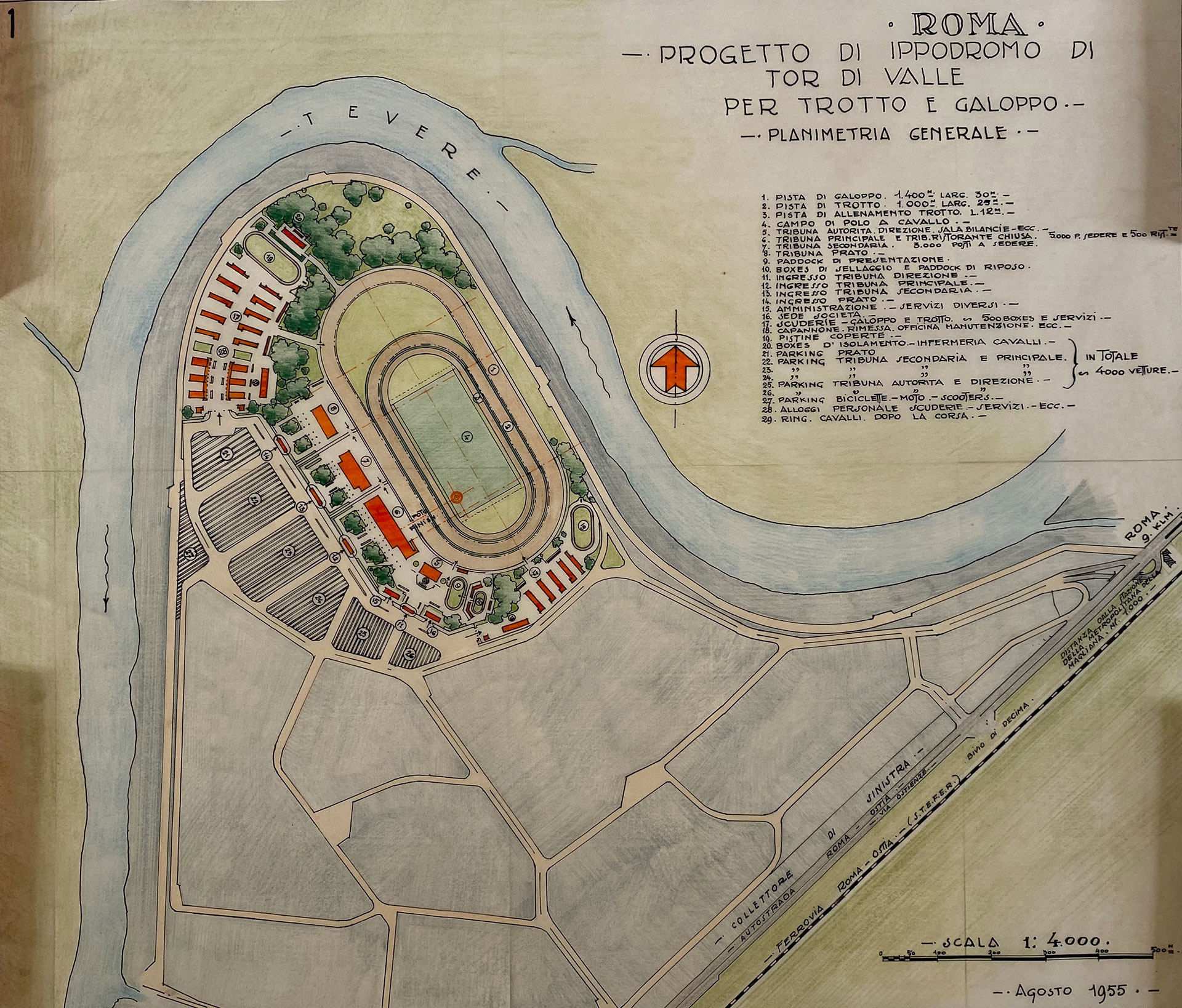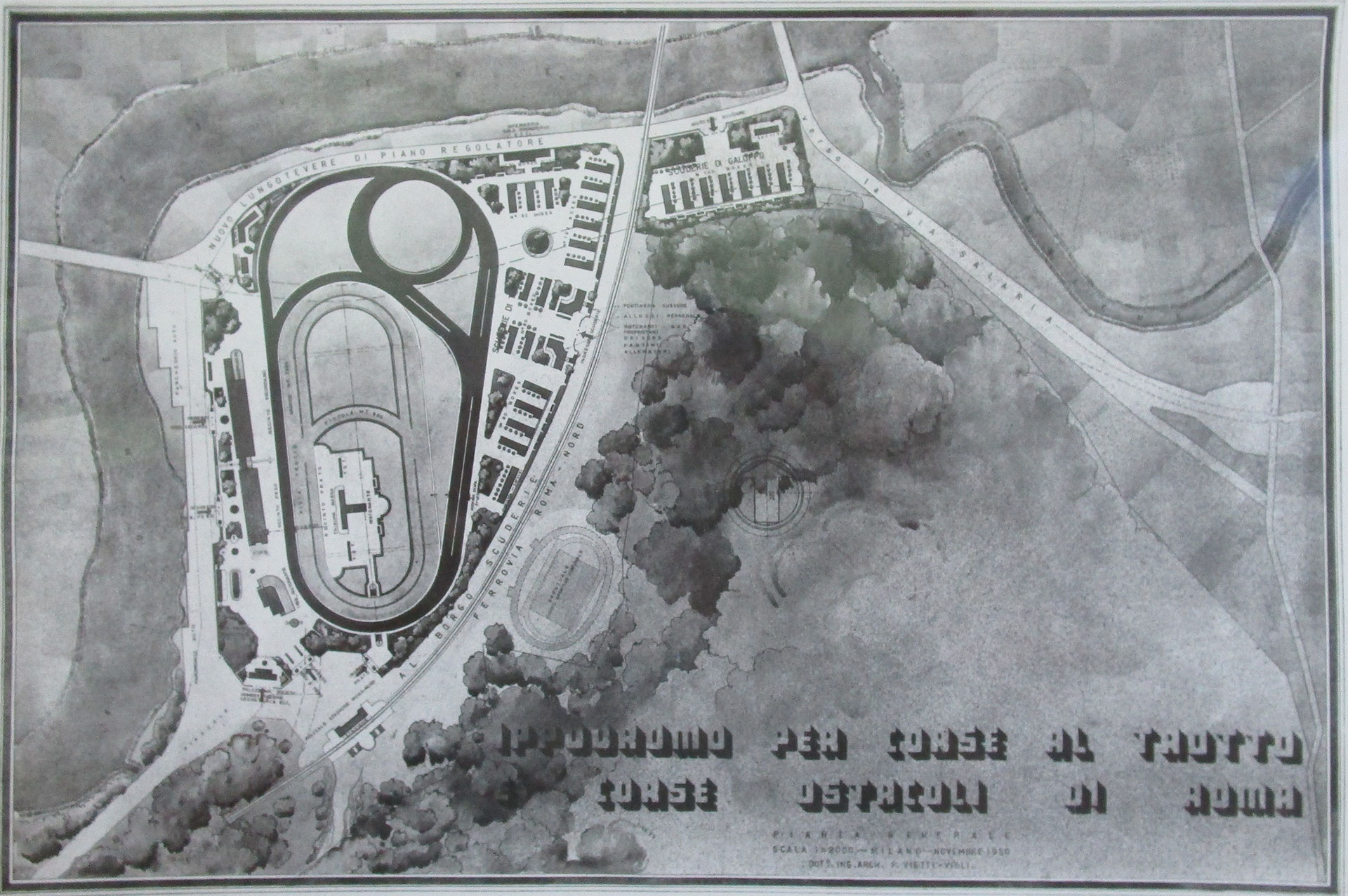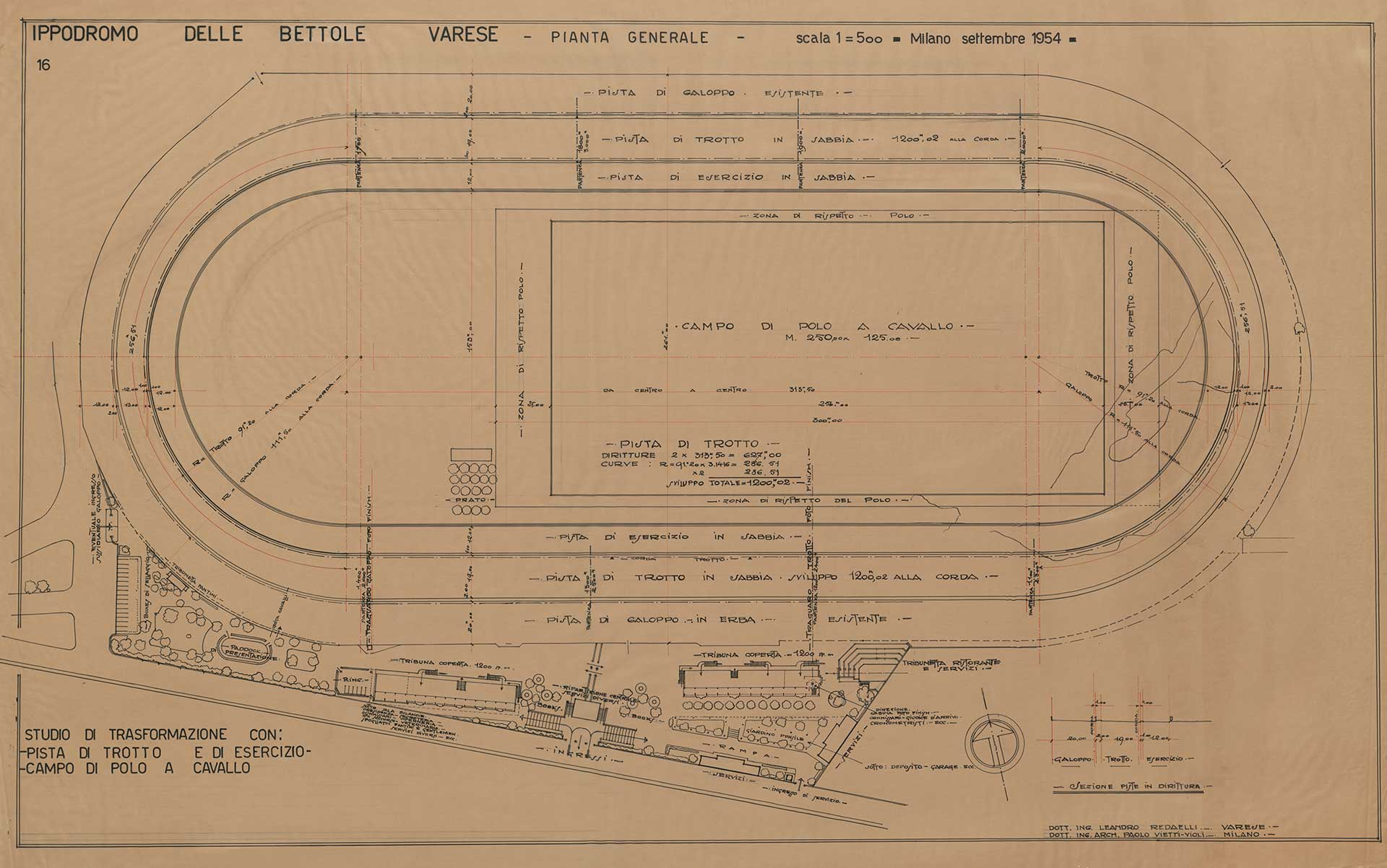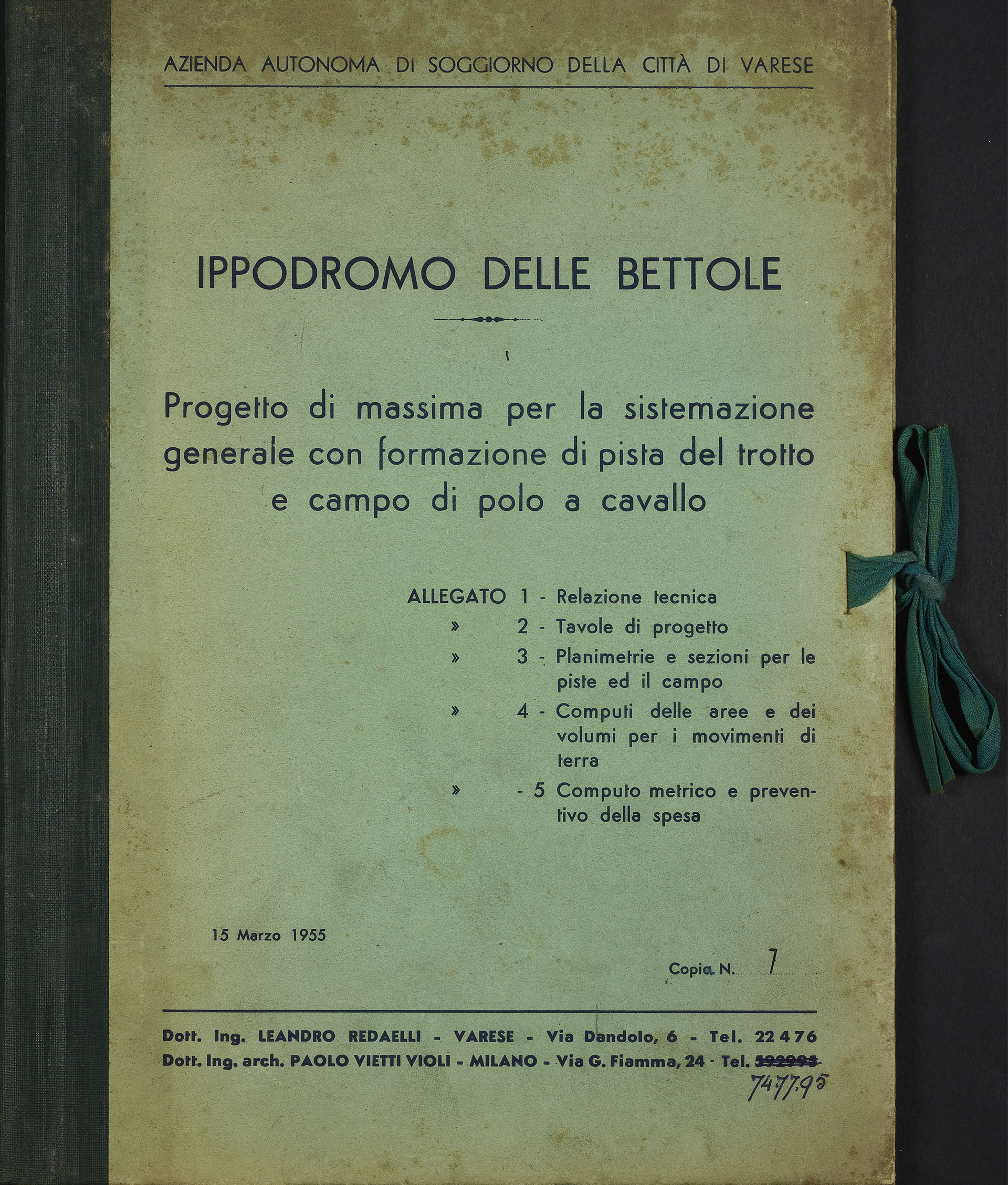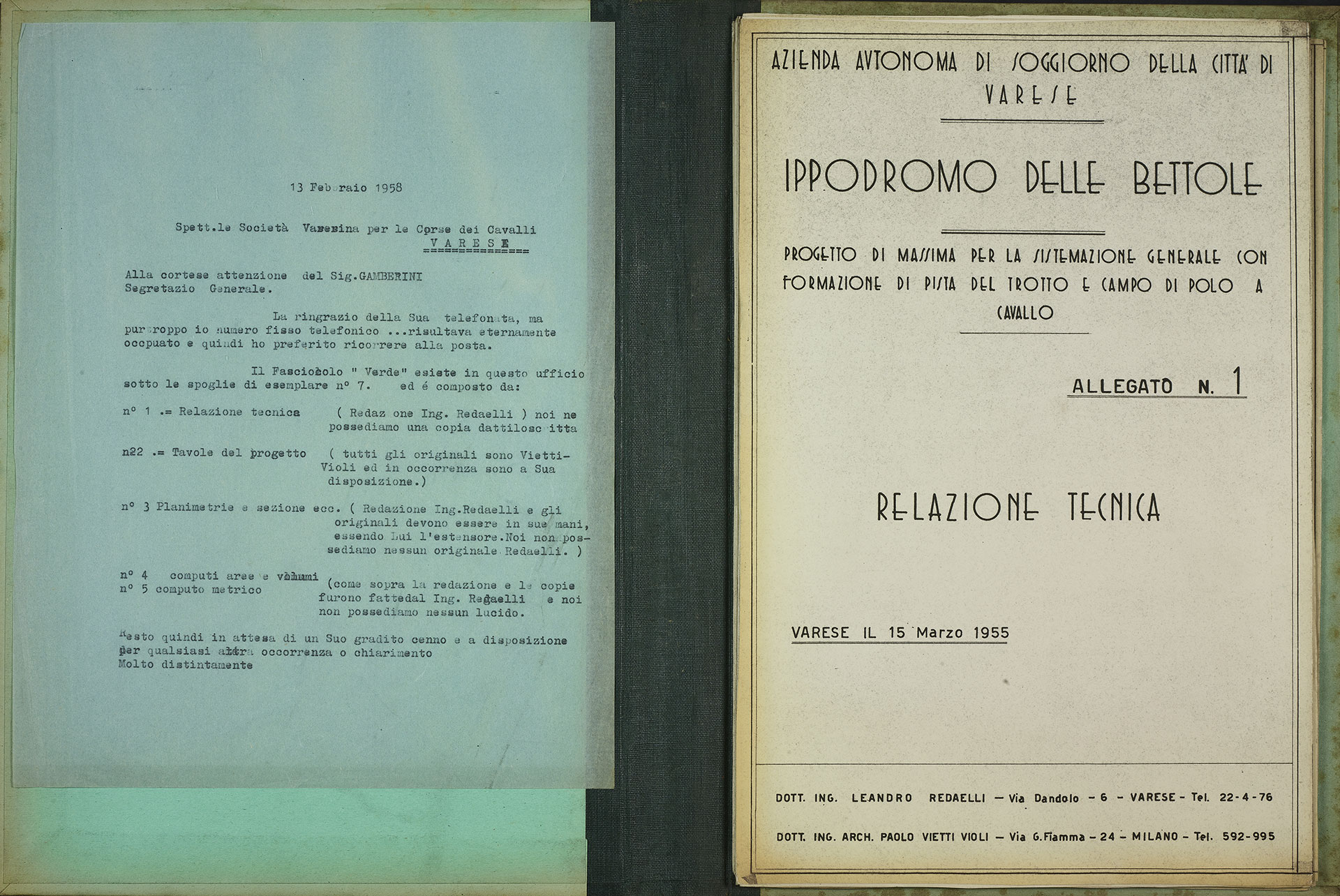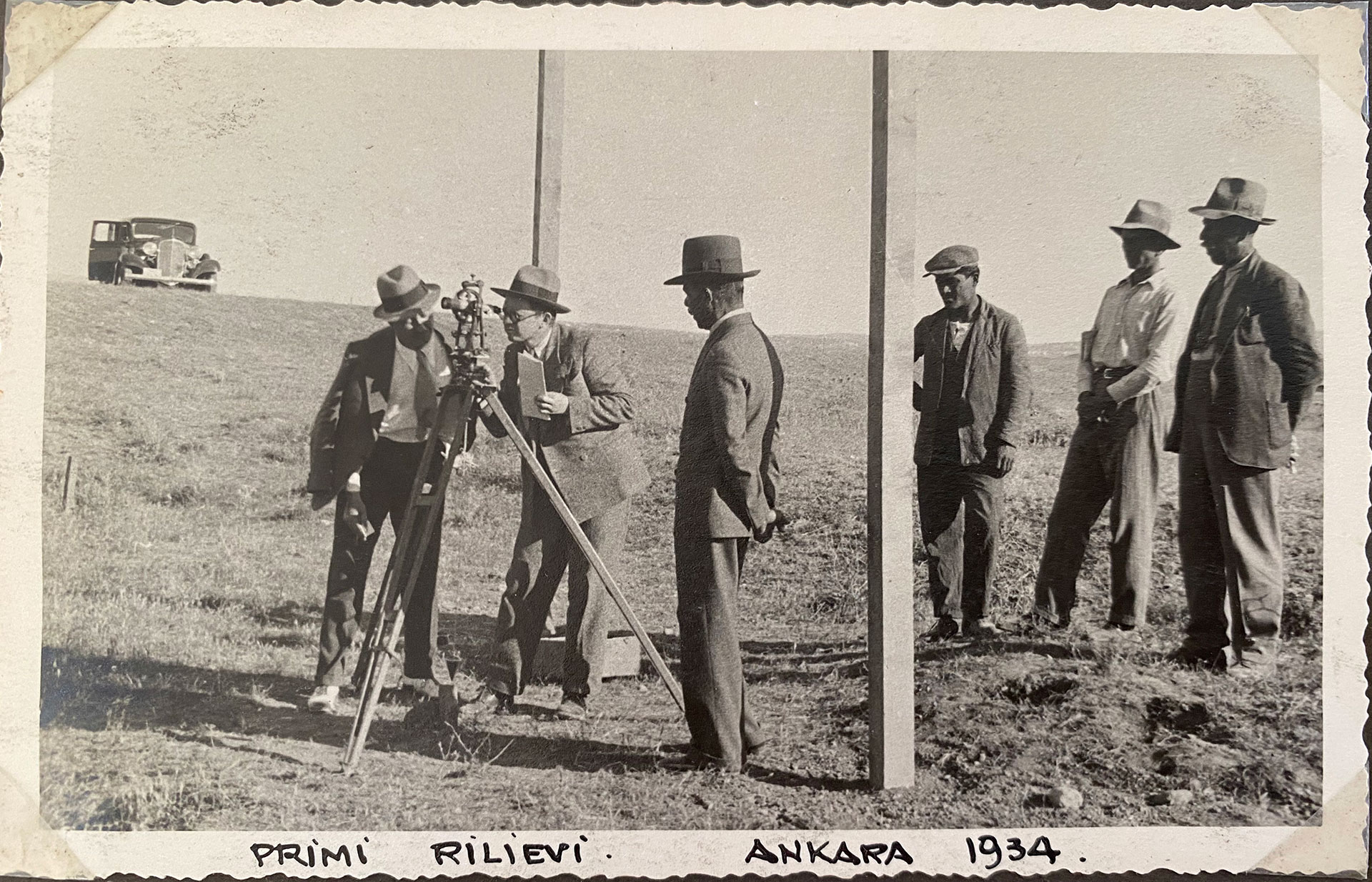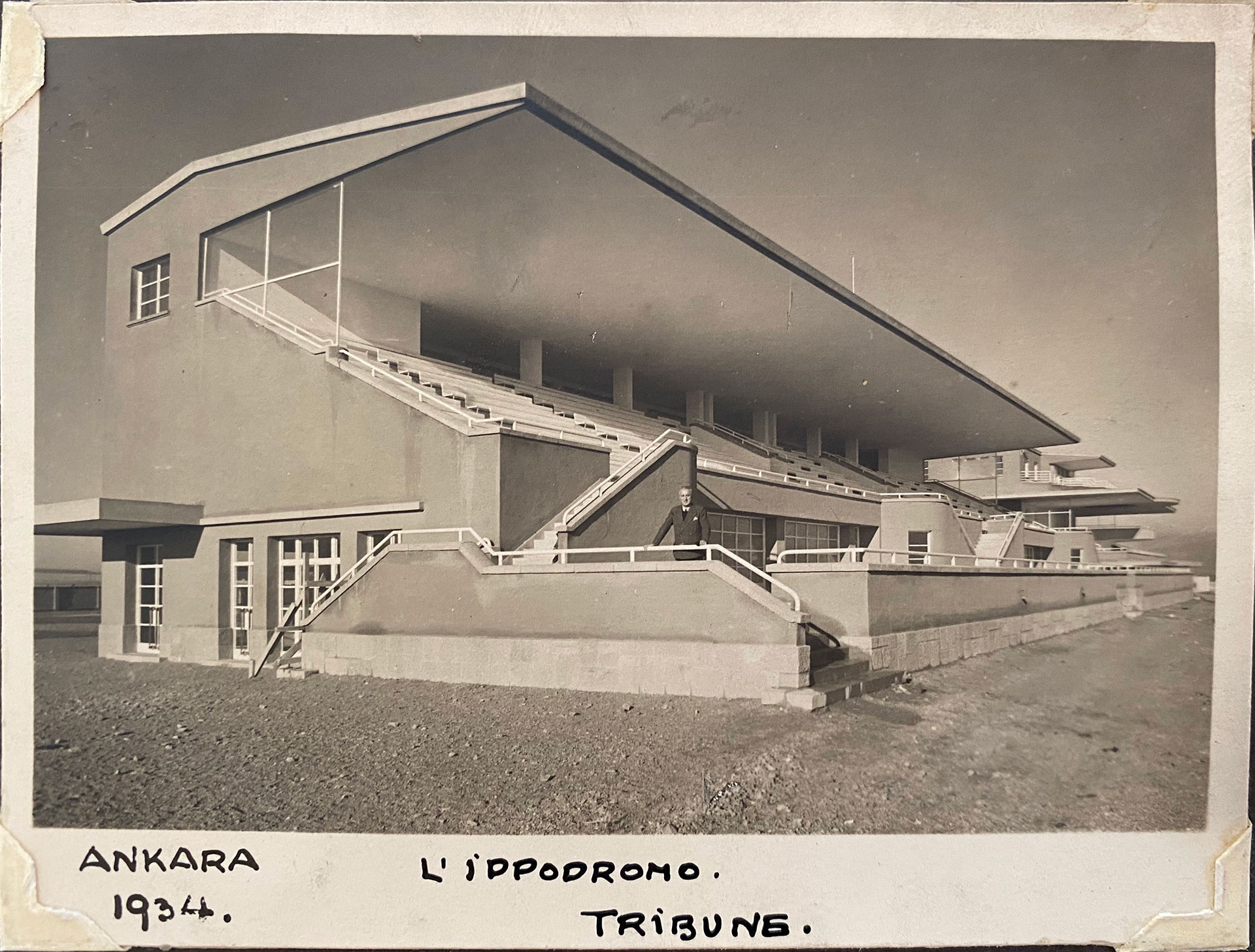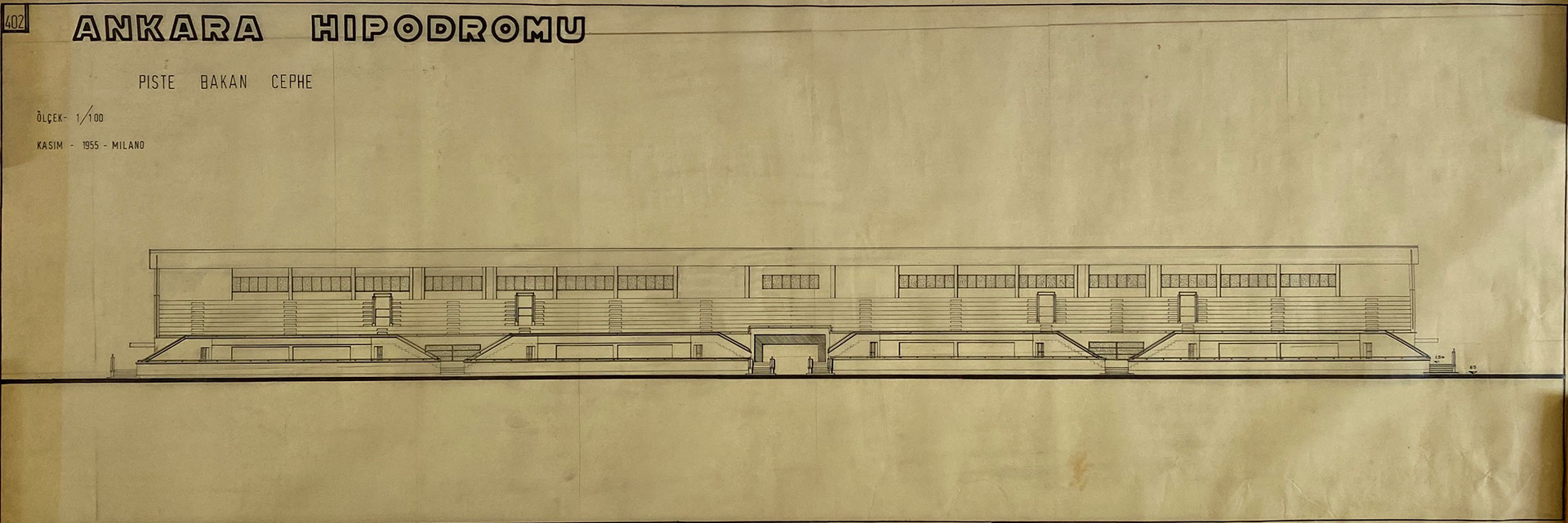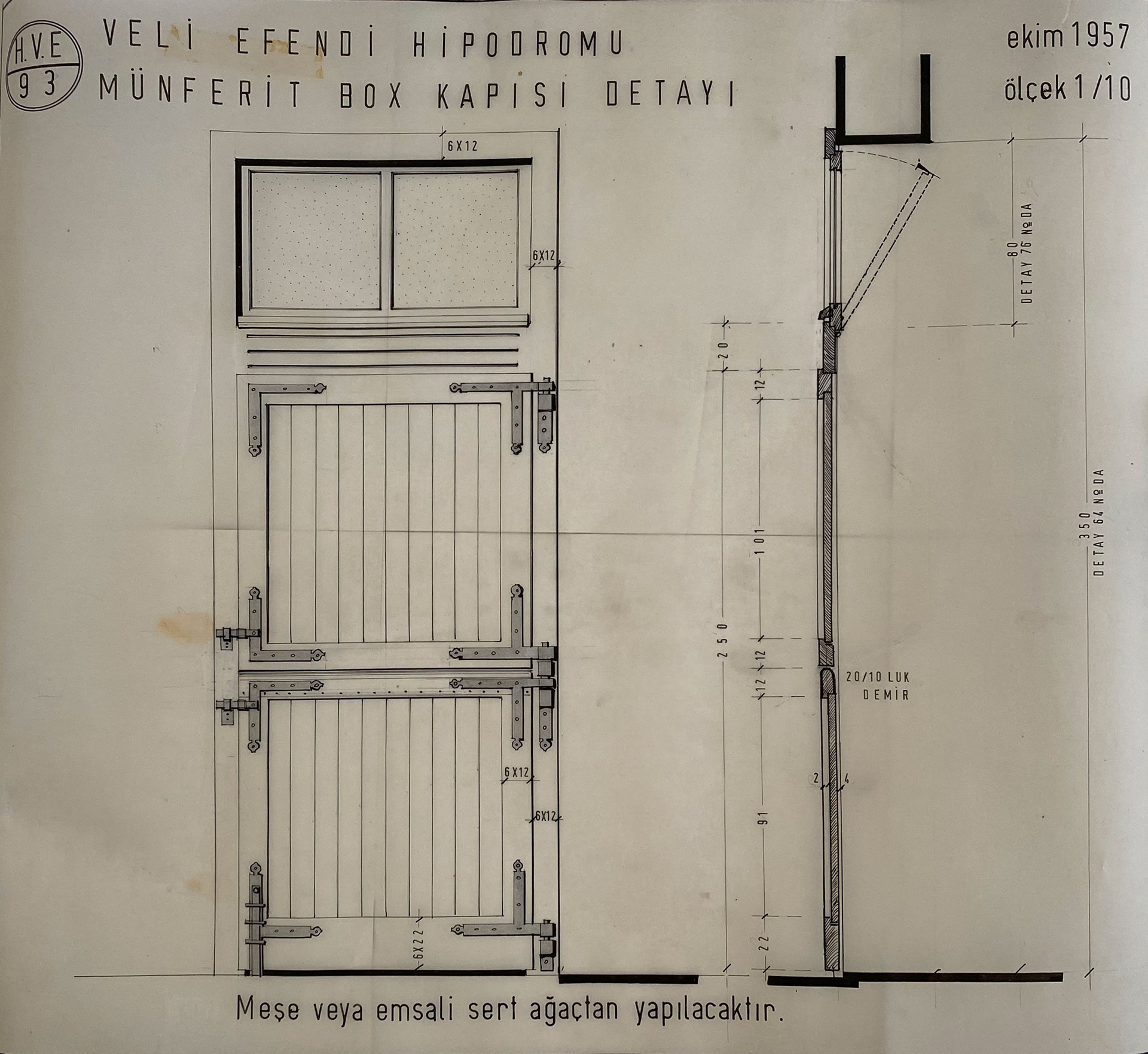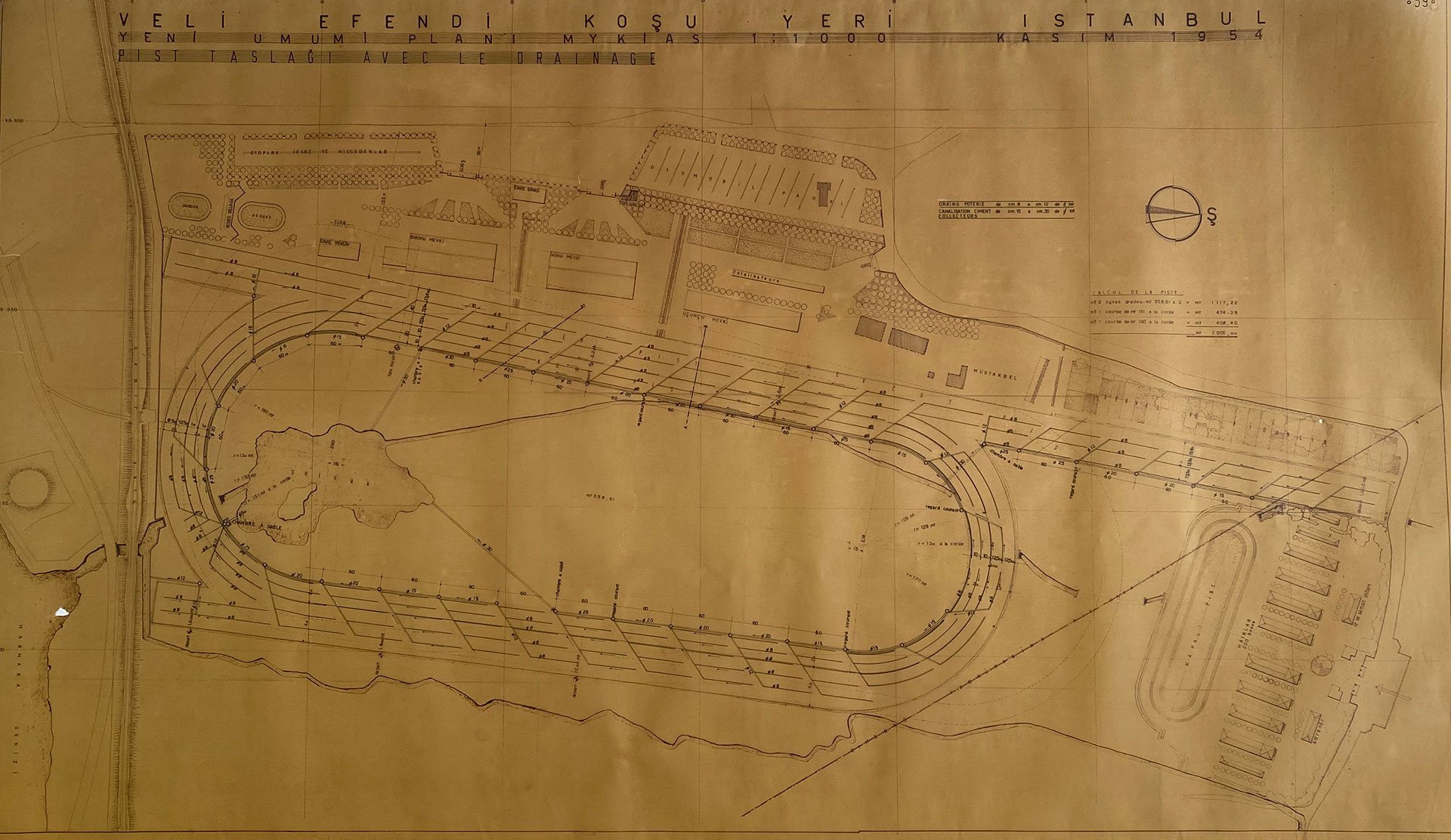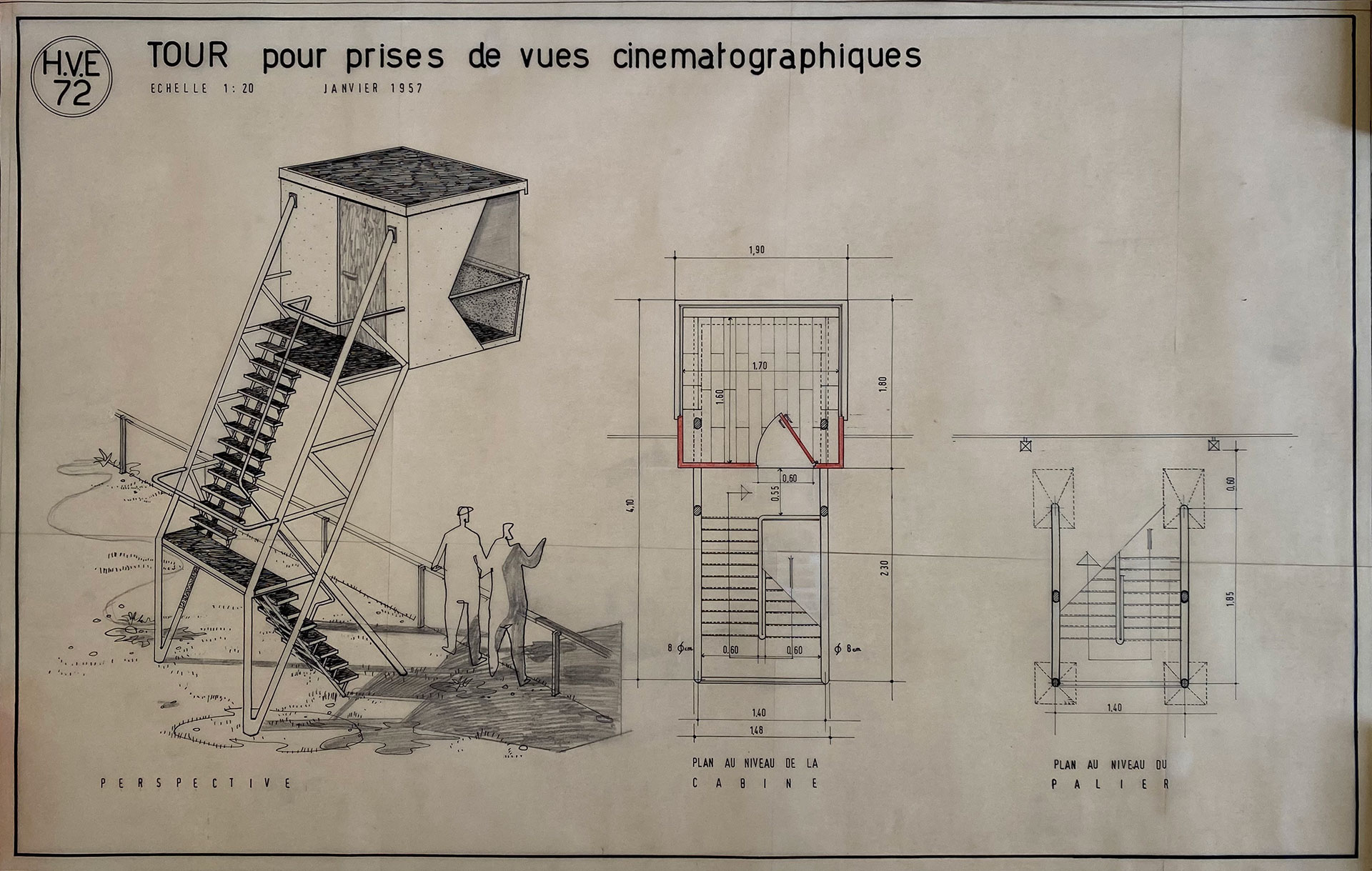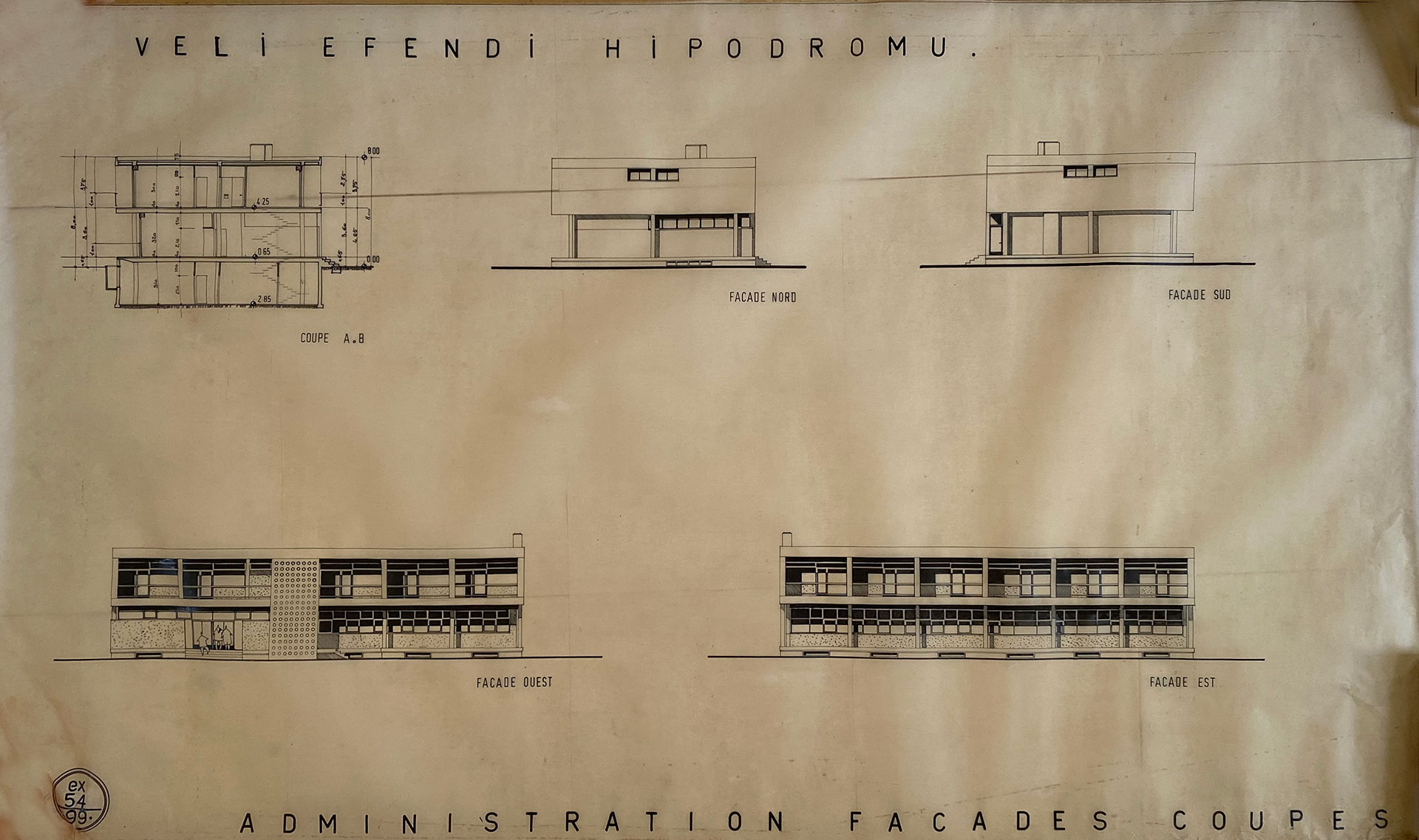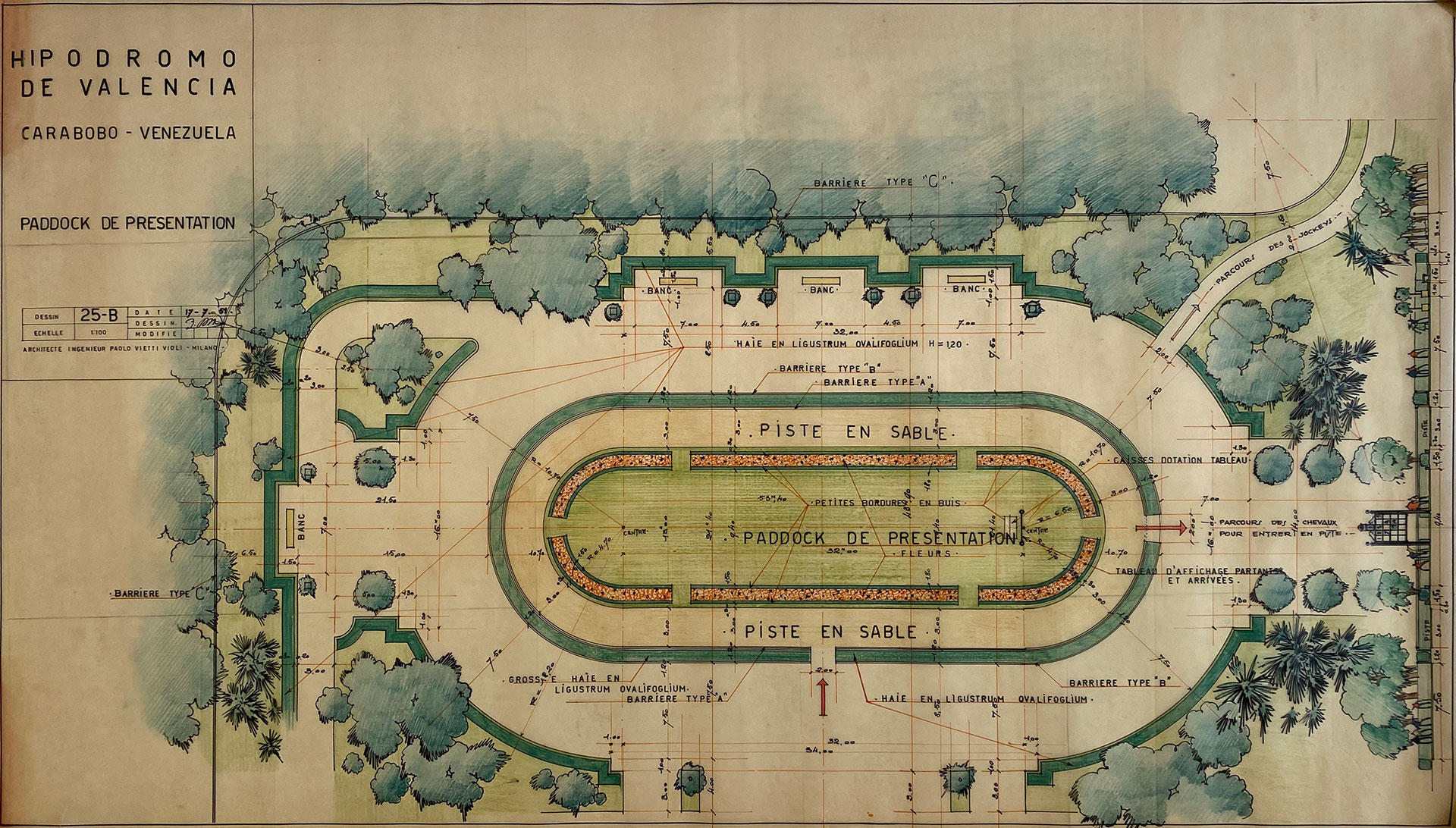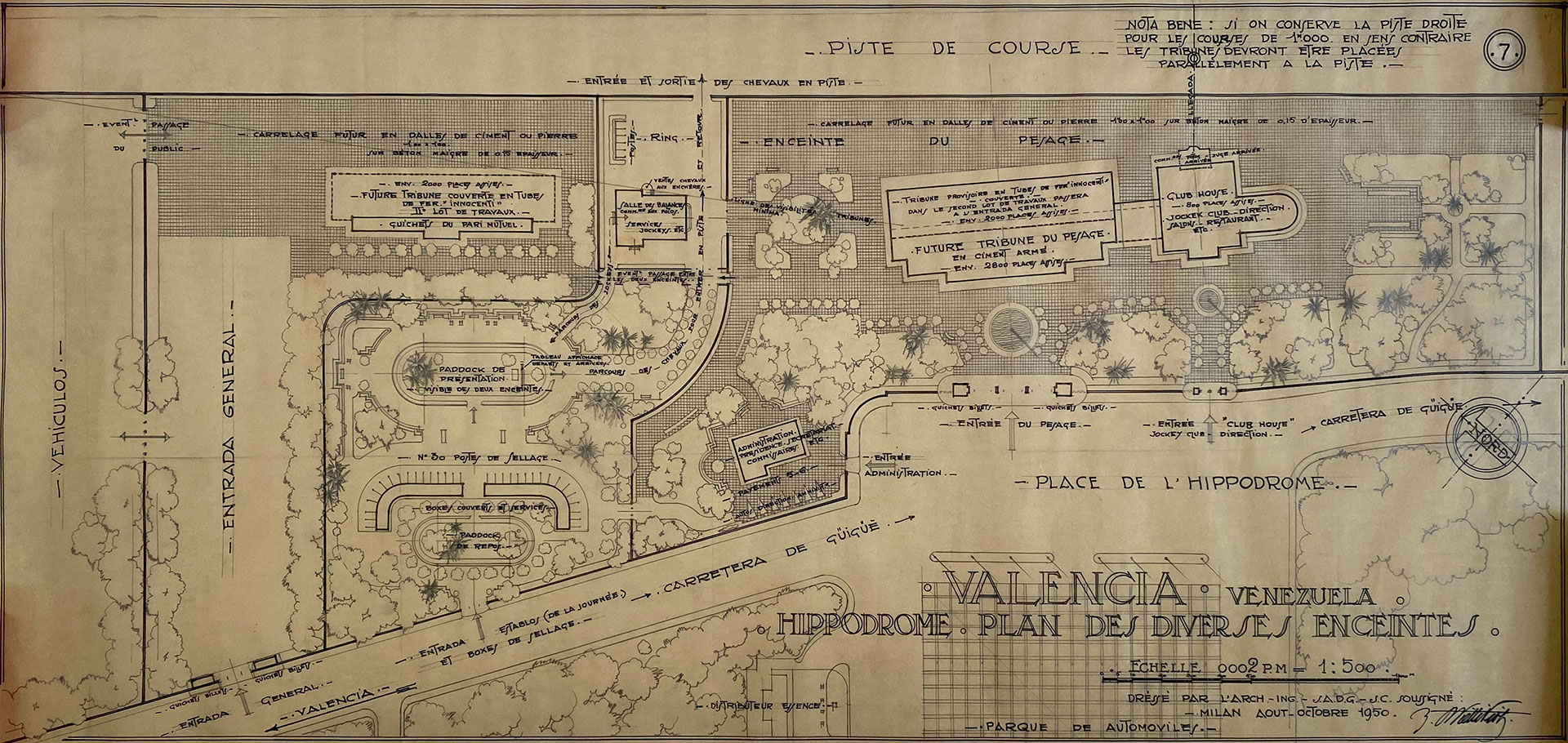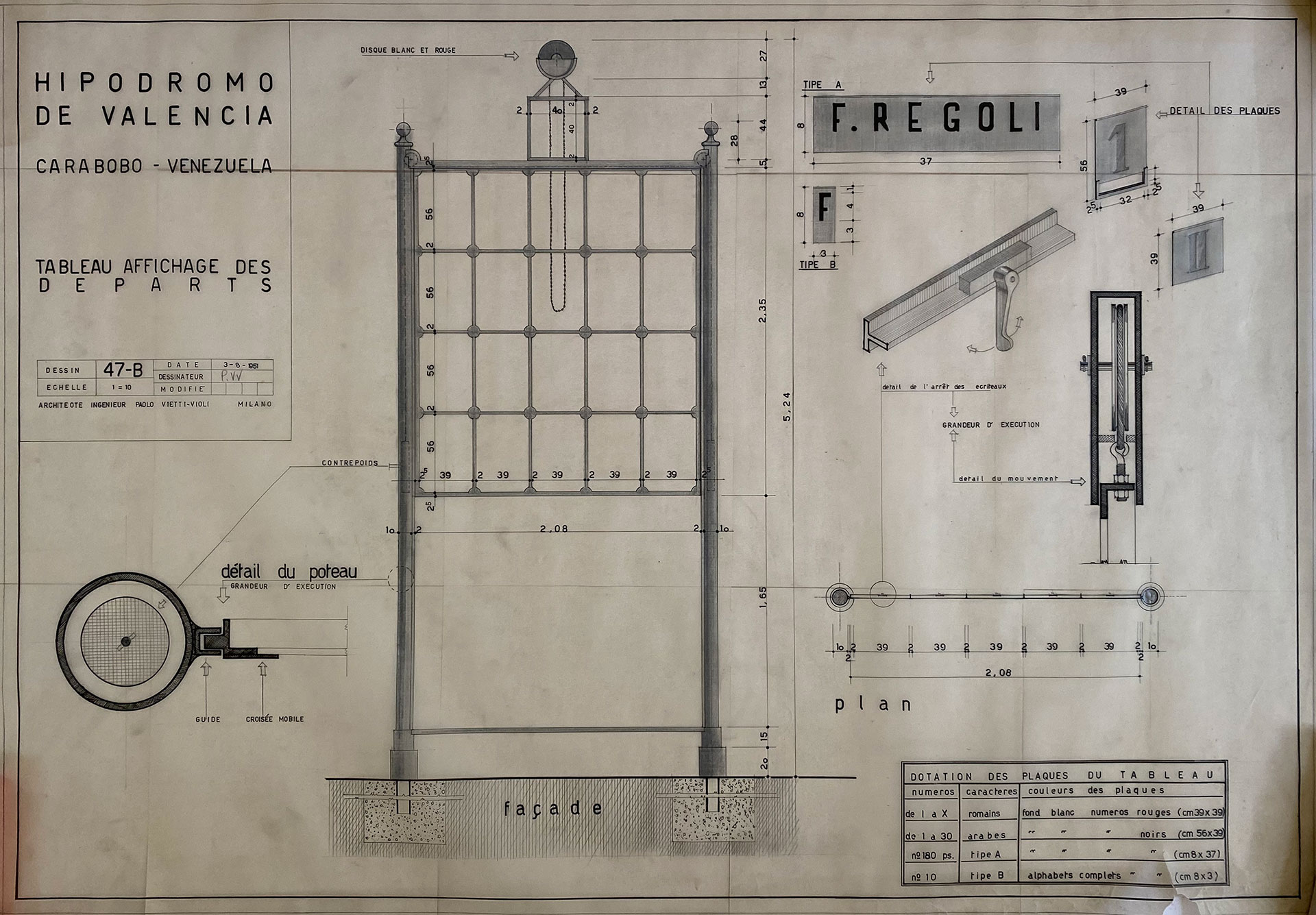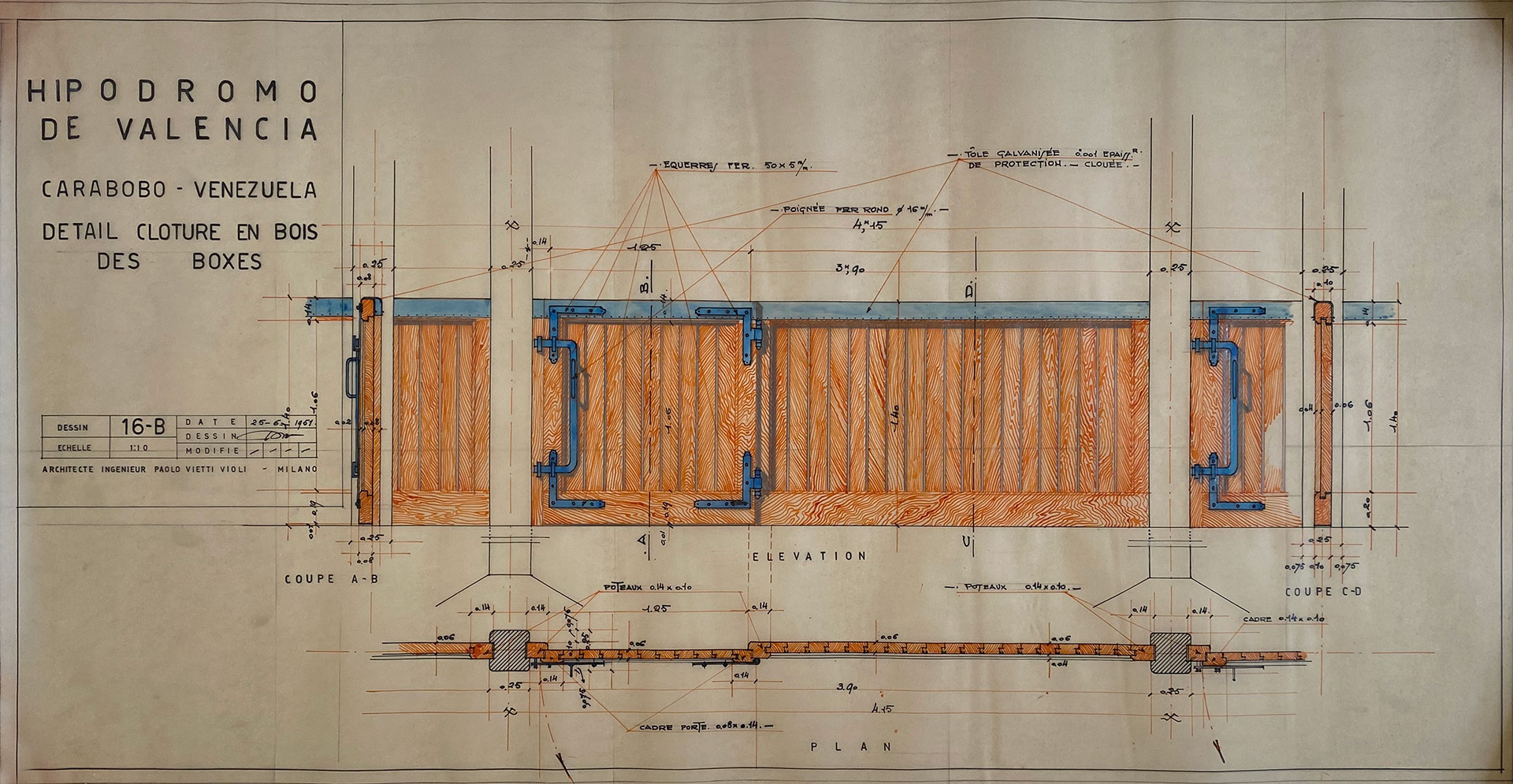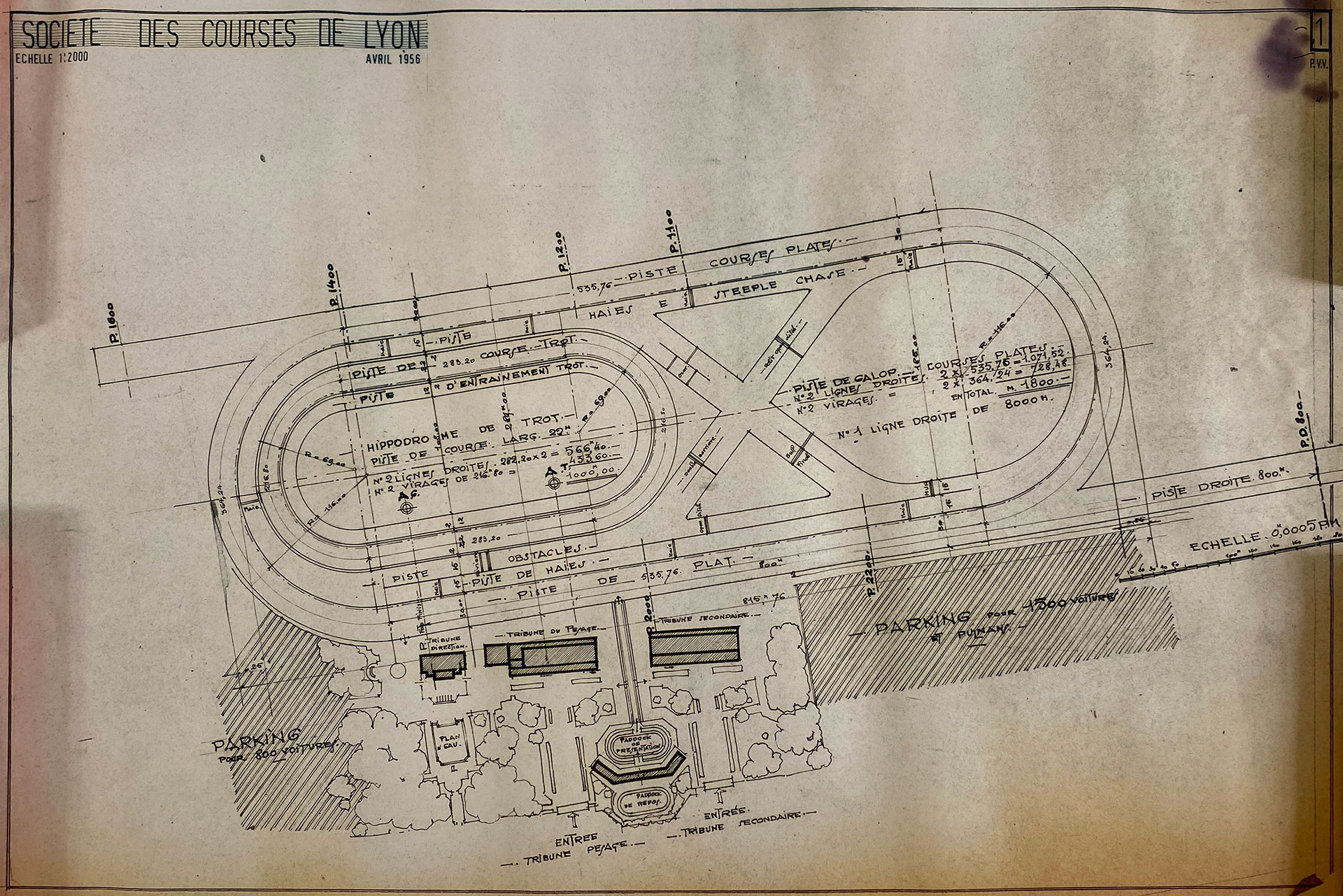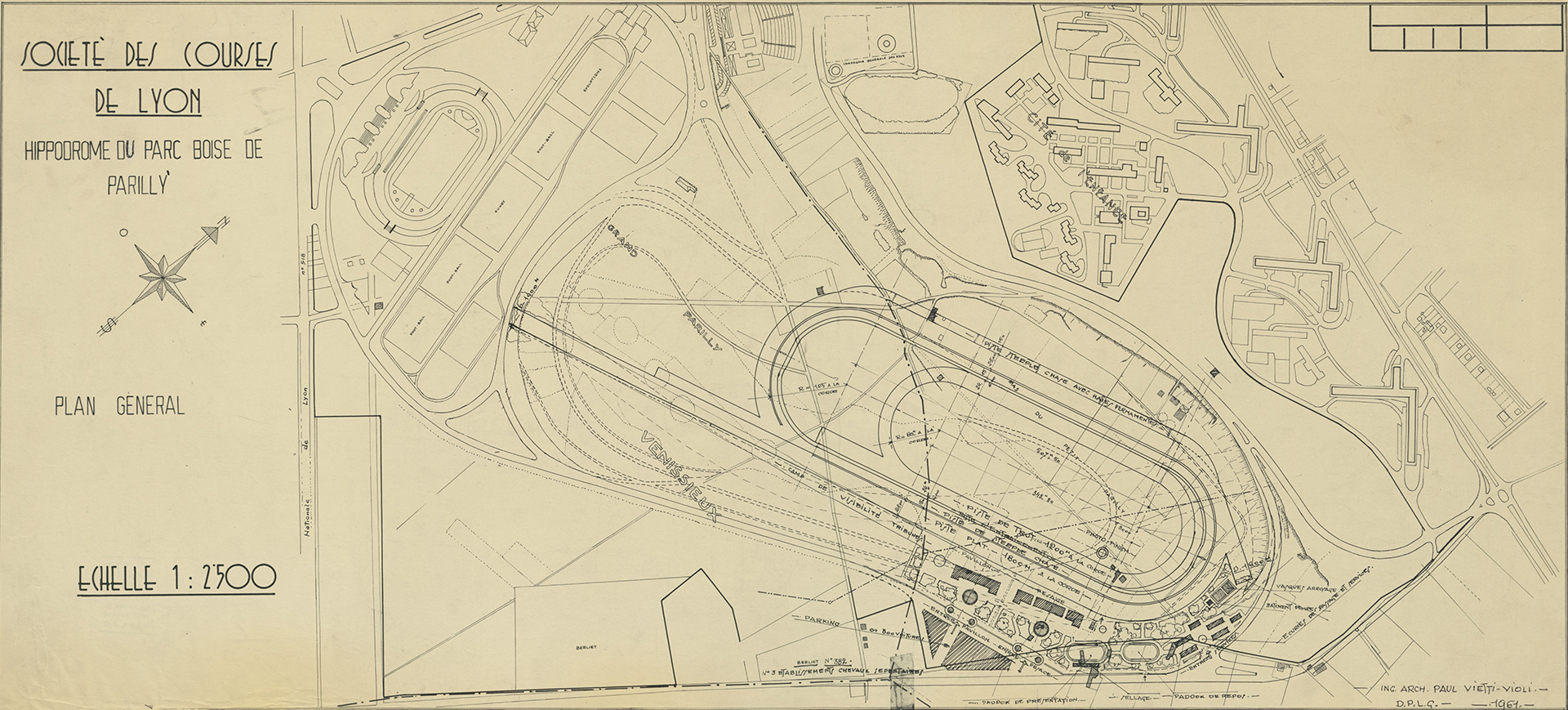In the 19th century, when equestrian sports took on their present form, horse racing was held in various places within the city of Milan. As already described in the first section of this historical archive, it was in 1883 that the Lombard Society for Horse Racing decided to build a suitable racecourse for the city, choosing as its location the village of San Siro, which had been annexed to the Municipality a few years before. The 19th-century structure was designed by the architect Giulio Valerio, who created a layout including grandstands, a management office with a portico for weighing, a coffee room, service areas for the jockeys, an infirmary, stables and other service buildings.
In 1911 a competition was held to design a vast and complex Equestrian Centre in San Siro, which was possible thanks to the district still being peripheral and non-urbanised.
The grandstands of the San Siro Racecourse in Milan (undated).
© San Siro Racecourses Archive
General plan of the San Siro Equestrian Centre in Milan. Scale 1:8000 (undated).
© San Siro Racecourses Archive
General plan of the San Siro Equestrian Centre in Milan (undated).
© San Siro Racecourses Archive
THE GALLOP RACECOURSE
The 1888 gallop racecourse featured an elegant Art Nouveau style devoid of ornamental excesses and clearly differentiated compositional-architectural language in the various buildings, based on their intended use, including half-timbered walls with a clear English inspiration.
In 1911 the Society for the Encouragement of Equine Breeds (SIRE) decided to renovate its facilities to make them better suited to the rapidly growing passion for this sport in the Lombard city.
In the same year Vietti Violi, alongside his colleague Arrigo Cantoni, participated in and won the international competition for the design and construction of the new gallop racecourse in Milan. The style of the grandstands of the first 19th-century facility, characterised by simple, lightweight constructions, made of masonry up to the terrace level and wood in the upper parts protected by canopies supported by slender cast iron columns, was abandoned in favour of more spacious and modern architecture. The use of reinforced concrete, innovative at the time, made it possible to create technically avant-garde structures: these can still be seen today by observing the grandstands from the side of the track, characterised by strongly overhanging roofs.
The result is an excellent facility that marked the beginning of a flourishing career for Vietti Violi designing other major sports facilities in Italy and abroad.
Regarding the architectural project of the gallop grandstands, created and completed in the 1920s, the archive contains only one drawing of the executive project: it depicts a section of the weighing grandstand.
The old facility. A moment of refreshment during a day of racing (undated).
© San Siro Racecourses Archive
San Siro Gallop Racecourse in Milan. Section of the Weighing Grandstand. Date: 1916, Scale: 0.04 per 1 metre.
© San Siro Racecourses Archive
On the other hand, there are numerous photographs taken during the races immortalising the grandstands crowded with people. These shots clearly show the eclectic style, which combines classical forms for the portico columns on the ground floor and the more slender columns of the gallery above with the more slender and daring forms of the projecting roofs in reinforced concrete.
For the fronts facing the entrances, however, a different language was chosen, favouring a composition of classically inspired architectural elements: ashlar cladding for the ground floor, airy loggias on pillars and bay windows framed by ionic pilasters for the first floor.
The grandstands.
© San Siro Racecourses Archive
Between the 1940s and 1950s some modifications were made to the grandstands, and there are some drawings from this phase that show only the date, referring to the status of the places rather than the creation of the drawing itself. These are the plans of all the grandstands and three elevation drawings of the secondary grandstand, the weighing and management grandstand, the main grandstand and the cross section of the secondary grandstand.
San Siro Gallop Racecourse in Milan. Plan of the ground floor of the secondary grandstand. Date: 1916 – 1945, Scale: 1:100.
© San Siro Racecourses Archive
San Siro Gallop Racecourse in Milan. Plan of the ground floor of the weighing and management grandstand. Date: 1915 – 1946, Scale: 1:50.
© San Siro Racecourses Archive
San Siro Gallop Racecourse in Milan. Plan of the ground floor of the main grandstand (undated).
© San Siro Racecourses Archive
© San Siro Racecourses Archive
THE HARNESS RACING COURSE
In 1924 the architect Vietti Violi was commissioned, this time directly, to design the harness racing facility.
Here too, the archive preserves diverse material and the documents describing the facility are both historical images and drawings subsequent to the first realisation: views, general and particular, of the track and buildings. A photograph dated 1947 shows an overall plan: there are all the buildings and the exercise and racetracks and – if compared with the photograph in the Gallop section – it can be seen how in just over 20 years the needs changed and new buildings were needed.
The photograph was taken directly by the architect Vietti Violi, as can be seen from his stamp on the back.
The grandstands were now designed taking full advantage of the possibilities offered by reinforced concrete, and allowed the roof of the terraces to have a large overhang without supports.
San Siro Harness Racing Course in Milan. General plan. Scale: 1:500, Date: 1947.
© San Siro Racecourses Archive
Stamp of the architect Paolo Vietti Violi
© San Siro Racecourses Archive
The grandstands and the terraces.
© San Siro Racecourses Archive
THE MONZA RACECOURSE
Two years after the inauguration of the new San Siro Gallop Racecourse, the SIRE decided to build a second one a few kilometres away within the Royal Park of Monza, between Villa Mirabello and Villa Mirabellino.
The project was entrusted to Vietti Violi. 1925 saw the inauguration of the 100-hectare facility, which adopted the Anglo-Saxon style, already used in the 19th-century racecourse and in the stables of San Siro, through a lattice structure. This solution had also been adopted for some appurtenances of the renovated San Siro complex.
There were only two racetracks and 3,000 seats. The drawings preserved in the Villa Reale Consortium and Monza Park show Art Nouveau-inspired buildings for the grandstands, restaurant and betting rooms, made of wood – a more informal material than the concrete used for the other facilities, and better suited to the monumental context of Monza Park. The Civic Historical Archive of the Municipality of Monza preserves many documents describing the creation of the Monza Racecourse and the correspondence prior to the concession of the areas and buildings of the Park annexed to the new racecourse. The Mirabellino became a restaurant and a stud farm for breeding thoroughbreds was set up inside the old royal stables at Villa Mirabello. In Monza, very important races were held for amateurs, gentlemen riders, and for obstacle trials. Although few in number, they were always of a high standard, and were considered a lively social pastime for the aristocracy and the upper middle class from Brianza and beyond. 1976 saw the last competition on the Monza tracks: the facility was closed and a few years later was hit by a series of fires that destroyed the two wooden grandstands, the chalet and the betting office.
The architect-engineer Paolo Vietti Violi was born in Grandson, Switzerland in 1882, but his family came from the Val d’Ossola. He trained in an international environment and studied in Geneva and Paris, where he graduated in Architecture from the École Nationale Spéciale des Beaux-Arts and where he resided, including after his marriage to Maria Biraghi Lossetti, until 1908. His ability to relate to different cultural contexts and his commissions in many countries worldwide were due precisely to these experiences. In 1908 he moved to Milan and opened the Italian studio where his son Emanuele would work. Emanuele went on to manage the professional activity after the war while his father was abroad. In 1920, during the inauguration ceremony of the San Siro Racecourse, he was appointed Knight of the Crown of Italy by the Duke of Aosta.
In 1943 a bombing destroyed the house in Milan, the studio and the archive with his projects. Vietti Violi was in Turkey and on his return moved to Villa Biraghi in Vogogna, his wife’s family home. In 1946 he returned to Turkey and resumed his international work until 1958, the year his son died, when he settled permanently in Vogogna.
© San Siro Racecourses Archive
Paolo Vietti Violi.
© San Siro Racecourses Archive
Details.
© San Siro Racecourses Archive
He started a studio with local professionals, the architects Luigi Visconti and Vladimiro Francioli, and managed to maintain an international clientele. He died in 1965, just as he was working on the project for the Parilly Racecourse in Lyon.
Studies on Vietti Violi’s work are fragmented due to the loss of much of his archive. The most important contributions are the volume by Raffaele Calzini published in the series “International Archives. Great Architects Series” in Geneva in 1931 and the volume by Paolo Volorio, “Paolo Vietti Violi – Architecture and Sport – The Ossolan world of an international architect, the international world of an Ossolan architect”, which is a catalogue of exhibitions dedicated to Vietti Violi in Vogogna and Villadossola in 2016.
The works of Paolo Vietti Violi in Italy and around the world.
© San Siro Racecourses Archive
From studying the documents of the Vietti Violi Fund, it is clear from the outset that life, relationships and a taste for travel are inseparable from the architect’s work.
Winning the competition for the San Siro Racecourse certainly directed Vietti Violi’s professional activity, but did not limit his prospects. As can be seen from the thematic sections of this fund, there were numerous international projects. The materials include two photo albums that collect in a single story the photos of the construction sites, colleagues, representatives of institutions, recently completed buildings, cities, historical heritage of the places Vietti Violi visited, people he met, events that would go down in history and sites for which he designed new works.
There are many ways to read the material, even more so in this section, and therefore a chronological story is just one possibility.
In the 1910s and 1920s Vietti Violi also dealt with housing projects, especially in Milan, and architecture unrelated to the world of sport. The documents testify to uninterrupted activity designing private, public and religious buildings, attesting to his design versatility and appreciation by a cultured clientele./p>
Paolo Vietti Violi travelling across Anatolia. June 1936
© San Siro Racecourses Archive
In the 1930s, Vietti Violi was in Turkey and the projects from those years for numerous buildings in different cities are preserved. In Ankara, for example, he designed the sports facilities and the stadium, the racecourse, the Parliament building, the Italian Embassy in Ankara and the Ataturk Mausoleum. In Istanbul he designed the racecourse, Galatasaray Stadium, Dolmabahçe Stadium and other public buildings, and was commissioned with numerous other sports centres and racecourses in other cities.
© San Siro Racecourses Archive
General plan of the Dolmabahçe Stadium in Istanbul. Scale: 1:2000, Date: 11/10/1939.
© San Siro Racecourses Archive
Istanbul project for the Tepe Basi sports facility, the first solution.
© San Siro Racecourses Archive
General colour plan of Samsun Sports Centre in Turkey. Scale: 1:500.
© San Siro Racecourses Archive
General colour plan of the Kütahya Vilayeti Racecourse and Sports Centre in Turkey. Scale 1:1000.
© San Siro Racecourses Archive
The travel images contained in the albums provide a very interesting documentary heritage attesting to the nature of archaeological sites, portraying cities and landscapes that can no longer be seen today, testifying to historical events, and immortalising Vietti Violi’s moments of work and conviviality.
© San Siro Racecourses Archive
In the 1940s and 1950s international activity intensified, with commissions for athletics facilities, stadiums, racecourses, sports halls and swimming pools in Izmir, Manissa, Adana, Samsun, Trabzon, Aydin, Kütahya, Isparta, other Turkish cities and also in Yugoslavia, Poland, France, Switzerland, the US and South America. In Italy we recall the project of the Radioactive Baths of Merano, carried out with the engineer Alberto Bernardi, and the 1947 proposal for the urban and tourist arrangement of the Venice Lido, with drawings ranging from the urban scale to the detail of the building in plan, as for the racecourse.
The 1950s were focused on sports facilities, in various parts of the world from Cyprus to the US.
In the last years of his life, Vietti Violi dedicated himself in particular to the project for the Parilly Racecourse in Lyon and interventions on two religious buildings in Valdossola and Vogogna.
The grandstands of the Deauville Racecourse in France.
© San Siro Racecourses Archive
Radioactive Baths of Merano, general plan. Scale: 1:500, Date: November 1942.
© San Siro Racecourses Archive
General plans of the urban and tourist arrangement of the Venice Lido. Scale: 1:5000 and 1:2000.
© San Siro Racecourses Archiv
As we have seen, the architect Vietti Violi specialised from the early 20th century in designing sports centres and racecourses. In the historical period he worked in, sport and physical activity also took on a symbolic and political value. Vietti Violi was thus celebrated by magazines such as “Lo sport Fascista”, the official organ of CONI, which dedicated an entire article to him setting out his design principles.
The expertise and design skills of Vietti Violi were also recognised in the 1950s, when architectural design faced the need for standardisation and regulation. His architecture thus became a reference in the specialised literature, especially with regard to racecourses.
Palazzo dello Sport in Milan. Study for a new facade.
© San Siro Racecourses Archive
Vietti Violi designed sports facilities all over the world, from Domodossola to Mexico. In Milan, between 1921 and 1923, he designed the Palazzo dello Sport (now known as Palazzo delle Scintille) at the Fiera Campionaria, a facility published in the magazine “Il Monitore Tecnico” and in the “Manuale dell’Architetto” by Daniele Donghi in 1930.
It is a structure that combines Liberty and Neo-Baroque, chosen for the elevations, with completely contemporary materials and solutions such as the large iron-glass structures supported by reinforced concrete pillars of the dome and the windows of the large openings on the facade. He drew up studies for the renovation of the facades of the same building in 1957.
Elevations
© San Siro Racecourses Archive
Longitudinal section of the Palazzo dello Sport e delle Esposizioni in Milan. Scale 0.01 P.M, Date: June 1923.
© San Siro Racecourses Archive
Colour sketch of a facade of the Palazzo dello Sport and Esposizioni in Milan (undated).
© San Siro Racecourses Archive
The project for the indoor swimming pool in Milan, also designed in reinforced concrete, iron and glass, dates back to 1931. The architect imagined the new facility as a place to practise swimming up to a competitive level, but also to relax in the massage and reading rooms, practise other sports like fencing, have lunch in the restaurant and hold business meetings.
Between 1936 and 1939 he worked on sports centre projects in Yugoslavia and Turkey, and in 1953 he designed an indoor swimming pool in Istanbul, following the design choices of the one designed for Milan.
Subsequently, in collaboration with the architects Şinasi Şahingiray and Fazıl Aysu, he was asked to design the Dolmabaçe Stadium in Istanbul. This would keep him busy until 1955: the large facility was part of a sports complex with soccer fields, tennis courts and basketball courts.
© San Siro Racecourses Archive
Plan of the mezzanine floor of the indoor swimming pool for the Central District of Milan. Scale: 1:100, Date: March 1932
© San Siro Racecourses Archive
General colour plan of the Smederevo Sports Centre in Yugoslavia. Scale: 1:1000, Date: 1937.
© San Siro Racecourses Archiveo
The indoor swimming pool in Istanbul.
© San Siro Racecourses Archive
General plan of the Dolmabahçe Stadium in Istanbul. Scale: 1:200, Date: 19/09/1939.
© San Siro Racecourses Archive
View of the terraces of the Dolmabahçe Stadium in Istanbul.
© San Siro Racecourses Archive
Vietti Violi’s presence in Ankara dates back to the 1930s and it was precisely then that he began to deal with the city’s sports facilities. The archive contains several drawings of stadiums, conceived – as in the case of the sports centres – as places to engage in various sporting and non-sporting activities.
Sports centres.
© San Siro Racecourses Archive
Most of the sports facility projects involve the construction of racecourses. The set of miscellaneous drawings of facilities built in Italy show, on the one hand, the evolution of Vietti Violi’s compositional and architectural language, also as part of numerous collaborations with other professionals, and on the other hand the functional characteristics of the racecourses, with the elements that change and those that remain constant.
Sesana Racecourse in Montecatini Terme. Sketch of the light drawing. Variant (undated).
© San Siro Racecourses Archive
© San Siro Racecourses Archive
It is also interesting to be able to compare the project drawings with the completed work, to identify variants, rethinks and improvements.
Back of the grandstands of the Capannelle Racecourse in Rome (undated).
© San Siro Racecourses Archive
Vietti Violi was then called on to create the new facility in Maia Bassa in Merano: the first structure dated back to 1900, and the architect designed a large facility on an urban scale. The drawings and images do not constitute complete series, but with respect to the most recent bibliographic sources it is interesting to note a pair of photographs depicting three grandstands with the caption “The first racecourse of Merano. 1926-28” in which the differences from the 1936 project and the subsequent construction are evident.
General plan of the equestrian facilities of the Municipality of Merano. Scale: 1:2880 (undated).
© San Siro Racecourses Archive
Views of the track of Merano’s first racecourse, Paolo Vietti Violi with two men visiting the equestrian facility. Date: 1926-28.
© San Siro Racecourses Archive
Project of 1936 and the subsequent construction.
© San Siro Racecourses Archive
There is a plan dating from 1939 of the racecourse at Prato delle Mulina alle Cascine in Florence, itself dating from the end of the 19th century and owned by the Florentine Horse Racing Company (part of the Trenno company from Milan), which depicts the facility in the year of its relaunch. The link with Vietti Violi is therefore evident and from 1951 to 1954 he was in charge of modernising the facility. The project highlights a language that fully adheres to the Italian post-war stylistic currents and absolute mastery of the use of free cantilevered structures, which extend 13 metres.
General colour plan of the Mulina Racecourse at the Cascine in Florence. Scale 1:1000, Date: October 1939.
© San Siro Racecourses Archive
Plan of the project for the arrangement of the grandstand enclosure and the entrances of the Mulina Racecourse at the Cascine del Trotto in Florence. Scale 1:200, Date: November 1951.
© San Siro Racecourses Archive
Colour cross-section of the grandstand with the totalisator hall of the Mulina Racecourse at the Cascine del Trotto in Florence. Scale 1:100, Date: November 1954
© San Siro Racecourses Archive
© San Siro Racecourses Archive
Variants of the plan of the ground floor of the grandstand of the Sesana Racecourse in Montecatini Terme. Scale 1:200 (undated).
© San Siro Racecourses Archive
Cross section of the grandstand of the Sesana Racecourse in Montecatini Terme. Scale 1:100.
©© San Siro Racecourses Archive
The Tor di Valle racecourse was inaugurated in 1959. It was the result of the collaboration of a group of designers – including Vietti Violi – who had been studying the project since 1950. In the 1953 project the grandstand was equipped with a double level of terraces, but the solution subsequently adopted in the 1957-1959 project – including for the overhanging roof – was very different.
General colour plan of the Tor di Valle Harness Racing and Gallop Racecourse in Rome. Scale: 1:4000, Date: August 1955.
© San Siro Racecourses Archive
Side elevations of the grandstand of the Tor di Valle Harness Racing and Gallop Racecourse in Rome. Scale: 1:200, Date: March 1953.
© San Siro Racecourses Archive
Front elevation of the entrances to the grandstand of the Tor di Valle Harness Racing and Gallop Racecourse in Rome. Scale: 1:100, Date: March 1953.
© San Siro Racecourses Archive
Some other interesting documentation is that concerning the arrangement and renovation of the Bettole racecourse, a late 19th-century facility that had been inaugurated in 1911.
Plans.
© San Siro Racecourses Archive
Project report of the Bettole Racecourse in Varese.
© San Siro Racecourses Archive
In 1933 Vietti Violi took part in an international competition involving the sports city of Ankara, and in particular for the design of a gallop racecourse. He won and received the commission to carry out the work.
First surveys for the Ankara Racecourse project in Turkey. Date: 1934.
© San Siro Racecourses Archive
There are some drawings and many photographs of the racecourse, including of the construction phase.
The designs of the racecourses of Veli Efendi in Istanbul and Carabobo du Valencia in Venezuela, both made in the mid-1950s, differ in one case for construction details of technological elements, such as windows, and in the other for the interesting use of colour.
Paolo Vietti Violi on one of the grandstands of the Ankara Racecourse in 1934.
© San Siro Racecourses Archive
Elevation towards the track of the grandstand of the Ankara Racecourse. Scale: 1:100, Date: 1955.
© San Siro Racecourses Archive
There are many detailed drawings of the Veli Efendi racecourse, both in terms of plans and technological elements.
© San Siro Racecourses Archive
There are also drawings of the facades of some of the buildings, in addition to the grandstands, that make up the racecourse complex, such as the veterinary clinic, the administration buildings, the jockey grandstand and the curious detail of the tower for television filming.
For the Venezuelan facility there are drawings that represent the plan distribution of the different areas making up the racecourse: the general plan, the paddocks and saddle stalls, the stables and the presentation paddock. The detailed drawings of the wooden closing walls of the stalls and the race board are also very interesting.
Plan and perspective sketch of the turret for filming. Scale: 1:20, Date: 1957.
© San Siro Racecourses Archive
General colour plan of the Valencia Racecourse in Venezuela, presentation paddock. Scale: 1:100, Date: 17/07/51
© San Siro Racecourses Archive
Detail of the race billboard of the Valencia Racecourse in Venezuela. Scale: 1:10, Date: 3.8.51.
© San Siro Racecourses Archive
General plan of the Parilly Racecourse in Lyon. Scale: 1:2000, Date: April 1955.
© San Siro Racecourses Archive
Elevation towards the entrance to the weighing grandstand at the Parilly Racecourse in Lyon. Scale: 0.005 PM, Date: 15/03/1951.
© San Siro Racecourses Archive
Parilly Racecourse in Lyon. Weighing grandstand, side elevations. Scale: 0.005 PM, Date: 15/03/1961.
© San Siro Racecourses Archive


